Chimney Swift recovery strategy
Read the recovery strategy for the Chimney Swift, a bird at risk in Ontario.
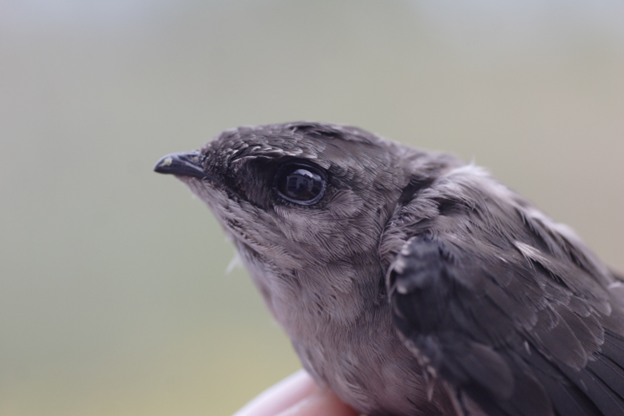
About the Ontario recovery strategy series
This series presents the collection of recovery strategies that are prepared or adopted as advice to the Province of Ontario on the recommended approach to recover species at risk. The Province ensures the preparation of recovery strategies to meet its commitments to recover species at risk under the Endangered Species Act, 2007 (ESA) and the Accord for the Protection of Species at Risk in Canada.
What is recovery?
Recovery of species at risk is the process by which the decline of an endangered, threatened, or extirpated species is arrested or reversed, and threats are removed or reduced to improve the likelihood of a species’ persistence in the wild.
What is a recovery strategy?
Under the ESA a recovery strategy provides the best available scientific knowledge on what is required to achieve recovery of a species. A recovery strategy outlines the habitat needs and the threats to the survival and recovery of the species. It also makes recommendations on the objectives for protection and recovery, the approaches to achieve those objectives, and the area that should be considered in the development of a habitat regulation. Sections 11 to 15 of the ESA outline the required content and timelines for developing recovery strategies published in this series.
Recovery strategies are required to be prepared for endangered and threatened species within one or two years respectively of the species being added to the Species at Risk in Ontario list. Recovery strategies are required to be prepared for extirpated species only if reintroduction is considered feasible.
What’s next?
Nine months after the completion of a recovery strategy a government response statement will be published which summarizes the actions that the Government of Ontario intends to take in response to the strategy. The implementation of recovery strategies depends on the continued cooperation and actions of government agencies, individuals, communities, land users, and conservationists.
For more information
To learn more about species at risk recovery in Ontario, please visit the Ministry of the Environment, Conservation and Parks Species at Risk webpage.
Recommended citation
Ministry of the Environment, Conservation and Parks. 2024. Recovery Strategy for the Chimney Swift (Chaetura pelagica) in Ontario. Ontario Recovery Strategy Series. Prepared by the Ministry of the Environment, Conservation and Parks, Peterborough, Ontario. iv + 5 pp. + Appendix. Adoption of the Recovery Strategy for Chimney Swift (Chaetura pelagica) in Canada (Environment and Climate Change Canada 2022). Cover illustration: Copyright Fisheries and Oceans Canada
© King’s Printer for Ontario, 2024
ISBN 978-1-4868-8006-5 (HTML)
ISBN 978-1-4868-8007-2 (PDF)
Content (excluding illustrations) may be used without permission with appropriate credit to the source, except where use of an image or other item is prohibited in the content use statement of the adopted federal recovery strategy.
Cette publication hautement spécialisée « Recovery strategies prepared under the Endangered Species Act, 2007 », n’est disponible qu’en anglais en vertu du Règlement 671/92 qui en exempte l’application de la Loi sur les services en français. Pour obtenir de l’aide en français, veuillez communiquer avec recovery.planning@ontario.ca.
Declaration
The recovery strategy for the Chimney Swift (Chaetura pelagica) was developed in accordance with the requirements of the Endangered Species Act, 2007 (ESA). This recovery strategy has been prepared as advice to the Government of Ontario, other responsible jurisdictions and the many different constituencies that may be involved in recovering the species.
The recovery strategy does not necessarily represent the views of all individuals who provided advice or contributed to its preparation, or the official positions of the organizations with which the individuals are associated.
The recommended goals, objectives and recovery approaches identified in the strategy are based on the best available knowledge and are subject to revision as new information becomes available. Implementation of this strategy is subject to appropriations, priorities and budgetary constraints of the participating jurisdictions and organizations.
Success in the recovery of this species depends on the commitment and cooperation of many different constituencies that will be involved in implementing the directions set out in this strategy.
Responsible jurisdictions
- Ministry of the Environment, Conservation and Parks
- Environment and Climate Change Canada – Canadian Wildlife Services, Ontario
- Parks Canada Agency
Executive summary
The Endangered Species Act, 2007 (ESA) requires the Minister of the Environment, Conservation and Parks to ensure recovery strategies are prepared for all species listed as endangered or threatened on the Species at Risk in Ontario (SARO) List. Under the ESA, a recovery strategy may incorporate all or part of an existing plan that relates to the species.
The Chimney Swift (Chaetura pelagica) is listed as Threatened on the SARO List. The species is listed as Threatened under the federal Species at Risk Act (SARA). Environment and Climate Change Canada prepared the Recovery Strategy for the Chimney Swift (Chaetura pelagica) in Canada in 2023 to meet its requirements under the SARA. This recovery strategy is hereby adopted under the ESA. With the additions indicated below, the enclosed strategy meets all of the content requirements outlined in the ESA.
The Critical Habitat section of the federal recovery strategy provides an identification of critical habitat (as defined under the SARA). Identification of critical habitat is not a component of a recovery strategy prepared under the ESA. However, it is recommended that the approach used to identify critical habitat in the federal recovery strategy, along with any new scientific information pertaining to the Chimney Swift and the areas it occupies, be considered if a habitat regulation is developed under the ESA.
1.0 Adoption of federal recovery strategy
The Endangered Species Act, 2007 (ESA) requires the Minister of the Environment, Conservation and Parks to ensure recovery strategies are prepared for all species listed as endangered or threatened on the Species at Risk in Ontario (SARO) List. Under the ESA, a recovery strategy may incorporate all or part of an existing plan that relates to the species.
The Chimney Swift (Chaetura pelagica) is listed as Threatened on the SARO List. The species is listed as Threatened under the federal Species at Risk Act (SARA). Environment and Climate Change Canada prepared the Recovery Strategy for the Chimney Swift (Chaetura pelagica) in Canada in 2023 to meet its requirements under the SARA. This recovery strategy is hereby adopted under the ESA. With the additions indicated below, the enclosed strategy meets all of the content requirements outlined in the ESA.
1.1 Species assessment and classification
The following list provides assessment and classification information for the Chimney Swift (Chaetura pelagica). Note: The glossary provides definitions for the abbreviations and technical terms in this document.
- SARO List Classification: Threatened
- SARO List History: Threatened (2009)
- COSEWIC Assessment History: Threatened (2018, 2007)
- SARA Schedule 1: Threatened
- Conservation Status Rankings: G-rank: G4G5; N-rank: N4B, N3M; S-rank: S3B
1. 2 Area for consideration in developing a habitat regulation
Under the ESA, a recovery strategy must include a recommendation to the Minister of the Environment, Conservation and Parks on the area that should be considered in developing a habitat regulation. A habitat regulation is a legal instrument that prescribes an area that will be protected as the habitat of the species. The recommendation provided below will be one of many sources considered by the Minister, including information that may become newly available following completion of the recovery strategy should a habitat regulation be developed for this species.
The Critical Habitat section of the federal recovery strategy provides an identification of critical habitat (as defined under the SARA). Identification of critical habitat is not a component of a recovery strategy prepared under the ESA. However, it is recommended that the approach used to identify critical habitat in the federal recovery strategy along with any new scientific information pertaining to the Chimney Swift and the areas it occupies, be considered if a habitat regulation is developed for the species under the ESA.
Glossary
- Committee on the Status of Endangered Wildlife in Canada (COSEWIC)
- The committee established under section 14 of the Species at Risk Act that is responsible for assessing and classifying species at risk in Canada.
- Committee on the Status of Species at Risk in Ontario (COSSARO)
- The committee established under section 3 of the Endangered Species Act, 2007 that is responsible for assessing and classifying species at risk in Ontario.
- Conservation status rank
- A rank assigned to a species or ecological community that primarily conveys the degree of rarity of the species or community at the global (G), national (N) or subnational (S) level. These ranks, termed g-rank, n-rank and S-rank, are not legal designations. Ranks are determined by NatureServe and, in the case of Ontario’s s-rank, by Ontario’s Natural Heritage Information Centre. The conservation status of a species or ecosystem is designated by a number from 1 to 5, preceded by the letter G, N or S reflecting the appropriate geographic scale of the assessment. The numbers mean the following:
- 1 = critically imperilled
- 2 = imperilled
- 3 = vulnerable
- 4 = apparently secure
- 5 = secure
- NR = not yet ranked
- Endangered Species Act, 2007 (ESA)
- The provincial legislation that provides protection to species at risk in Ontario.
- Species at Risk Act (SARA)
- The federal legislation that provides protection to species at risk in Canada. This Act establishes Schedule 1 as the legal list of wildlife species at risk. Schedules 2 and 3 contain lists of species that at the time the Act came into force needed to be reassessed. After species on Schedule 2 and 3 are reassessed and found to be at risk, they undergo the SARA listing process to be included in Schedule 1.
- Species at Risk in Ontario (SARO) List
- The regulation made under section 7 of the Endangered Species Act, 2007 that provides the official status classification of species at risk in Ontario. This list was first published in 2004 as a policy and became a regulation in 2008 (Ontario Regulation 230/08).
List of abbreviations
- COSEWIC
- Committee on the Status of Endangered Wildlife in Canada
- COSSARO
- Committee on the Status of Species at Risk in Ontario
- CWS
- Canadian Wildlife Sevice
- ESA
- Ontario’s Endangered Species Act, 2007
- ISBN
- International Standard Book Number
- SARA
- Canada’s Species at Risk Act
- SARO List
- Species at Risk in Ontario List
Appendix 1. Recovery Strategy and Action Plan for Chimney Swift (Chaetura pelagica) in Canada
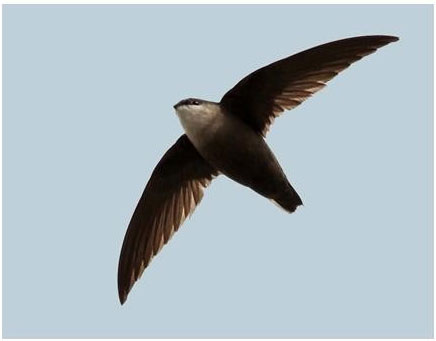
Recommended citation
Environment and Climate Change Canada. 2023. Recovery Strategy for the Chimney Swift (Chaetura pelagica) in Canada. Species at Risk Recovery Strategy Series, Environment and Climate Change Canada, Ottawa, ix + 151 pp.
For copies of the recovery strategy, or for additional information on species at risk, including the Committee on the Status of Endangered Wildlife in Canada (COSEWIC) Status Reports, residence descriptions, action plans, and other related recovery documents, please visit the Species at Risk (SAR) Public Registry
Cover illustration: © Serge Beaudette
Également disponible en français sous le titre « Programme de rétablissement du Martinet ramoneur (Chaetura pelagica) au Canada »
© His Majesty the King in Right of Canada, represented by the Minister of Environment and Climate Change, 2023. All rights reserved.
ISBN 978-0-660-48546-1
Catalogue no. En3-4/365-2023E-PDF
Content (excluding the illustrations) may be used without permission, with appropriate credit to the source.
Preface
The federal, provincial,
The Minister of Environment and Climate Change and Minister responsible for the Parks Canada Agency is the competent minister under SARA for the Chimney Swift and has prepared this recovery strategy, as per section 37 of SARA. To the extent possible, the recovery strategy has been prepared in cooperation with the provinces of Saskatchewan, Manitoba, Ontario, Quebec, New Brunswick and Nova Scotia, as per subsection 39(1) of SARA.
Success in the recovery of this species depends on the commitment and cooperation of many different constituencies that will be involved in implementing the directions set out in this strategy and will not be achieved by Environment and Climate Change Canada, the Parks Canada Agency, or any other jurisdiction alone. All Canadians are invited to join in supporting and implementing this strategy for the benefit of the Chimney Swift and Canadian society as a whole.
This recovery strategy will be followed by one or more action plans that will provide information on recovery measures to be taken by Environment and Climate Change Canada, the Parks Canada Agency, or any other jurisdictions and/or organizations involved in the conservation of the species. Implementation of this strategy is subject to appropriations, priorities and budgetary constraints of the participating jurisdictions and organizations.
The recovery strategy sets the strategic direction to arrest or reverse the decline of the species, including identification of critical habitat to the extent possible. It provides all Canadians with information to help take action on species conservation. When critical habitat is identified, either in a recovery strategy or an action plan, SARA requires that critical habitat then be protected.
In the case of critical habitat identified for terrestrial species including migratory birds, SARA requires that critical habitat identified in a federally protected area
For critical habitat located on other federal lands, the competent minister must either make a statement on existing legal protection or make an order so that the prohibition against destruction of critical habitat applies.
If the critical habitat for a migratory bird is not within a federal protected area and is not on federal land, within the exclusive economic zone or on the continental shelf of Canada, the prohibition against destruction can only apply to those portions of the critical habitat that are habitat to which the Migratory Birds Convention Act, 1994 applies as per SARA subsections 58(5.1) and 58(5.2).
For any part of critical habitat located on non-federal lands, if the competent minister forms the opinion that any portion of critical habitat is not protected by provisions in or measures under SARA or other Acts of Parliament, or the laws of the province or territory, SARA requires that the Minister recommend that the Governor in Council make an order to prohibit destruction of critical habitat. The discretion to protect critical habitat on non-federal lands that is not otherwise protected rests with the Governor in Council.
Acknowledgements
This recovery strategy was prepared under the direction of François Shaffer (Environment and Climate Change Canada, Canadian Wildlife Service – Quebec Region), Ron Bazin (Environment and Climate Change Canada, Canadian Wildlife Service – Prairie Region), Angela Darwin, Ken Tuininga and Mike Cadman, Marie-Claude Archambault (Environment and Climate Change Canada, Canadian Wildlife Service – Ontario Region), Kendra Marshman, Karen Potter and Becky Whittam (Environment and Climate Change Canada, Canadian Wildlife Service – Atlantic Region), and Véronique Connolly (private consultant).
Other Canadian Wildlife Service collaborators who contributed to the production of the recovery strategy are: Wendy Dunford, Manon Dubé, Véronique Brondex, Thomas Calteau, Julie Nadeau and Marie-Andrée Carrière (National Capital Region) and Céline Maurice, Karine Picard, Marianne Gagnon, Sylvain Giguère, Matthieu Allard, François Landry and Caroline Bureau (Quebec Region), Krista Holmes and John Brett (Ontario Region), Wendy Eskowich (Prairie Region), and Kathy St-Laurent and Lee Godfrey (Atlantic Region).
The following organizations also provided comments that contributed to improving the quality of the document: Government of Manitoba, Manitoba Chimney Swift Initiative, Birds Canada
Thanks also to the many individuals and organizations that provided information on the location of Chimney Swift nesting and roosting sites, in particular the Manitoba Chimney Swift Initiative, Birds Canada and Regroupement QuébecOiseaux. The information they provided was very useful in the identification of critical habitat.
Lastly, acknowledgement and thanks are given to all other parties that provided advice, guidance and information to help inform the development of this document including various organizations, Indigenous groups, provincial governments, other federal departments (e.g., Parks Canada), landowners, citizens, and stakeholders.
Executive summary
The Chimney Swift (Chaetura pelagica) is an aerial insectivorous bird species that is associated primarily with urban areas and is also found in rural and agricultural areas as well as forests. It perches exclusively on vertical surfaces, such as the inside of hollow tree trunks and chimneys. The species was assessed as Threatened in Canada by the Committee on the Status of Endangered Wildlife in Canada (COSEWIC) in 2007 and was added to Schedule 1 of the Species at Risk Act in 2009. In 2018, the species was reassessed and its status remained unchanged.
The Chimney Swift breeds in central and eastern North America and winters in South America, mainly in the Amazon basin. In Canada, it breeds in Saskatchewan, Manitoba, Ontario, Quebec, New Brunswick, and Nova Scotia. The Chimney Swift population in Canada is estimated to be between 20,000 and 70,000 mature individuals.
The main threats to the species have been identified as declines or changes in insect populations (due to pesticide use, urban development and other factors), chimney modification or demolition, chimney sweeping or use of chimneys during the breeding season, forestry practices on the breeding grounds, and logging on the wintering grounds.
There are some unknowns regarding the feasibility of recovery for the Chimney Swift. In keeping with the precautionary principle, this recovery strategy has been prepared as per subsection 41(1) of SARA, as is the case when recovery is determined to be feasible. The recovery strategy addresses the unknowns surrounding the feasibility of recovery of the species.
The long-term population and distribution objective is to maintain a stable Chimney Swift population in the current known extent of occurrence in Canada, for a period of 10 years following the achievement of the short-term objective (approximately 2033–2043). The short-term population and distribution objective for the Chimney Swift in Canada is to halt the population decline within 10 years and to maintain its current known extent of occurrence.
Broad strategies as well as research and management approaches for achieving the objectives are presented in section 6.2, “Strategic Direction for Recovery.”
Critical habitat for the Chimney Swift is partially identified in this recovery strategy. The identification of critical habitat is based on two criteria: habitat occupancy by the species and the biophysical attributes of suitable habitat. Habitat occupancy criteria in human-altered environments are as follows:
- any confirmed breeding record between 2011 and 2017, such as the observation of a nest, eggs or young inside a structure, or the observation of a bird entering a structure with a twig
or
- any observation of at least one swift entering or leaving a structure, on at least two different days, including at least one day between 2011 and 2017 and another between 2001 and 2017
Suitable Chimney Swift habitat generally has the following biophysical attributes: chimneys with interior walls constructed of masonry (stone, brick, concrete or ceramic tile), or other vertical structures such as barns, silos, or abandoned buildings with openings allowing access to the interior. The natural habitat characteristics that could provide suitable sites for the species are not sufficiently documented. Therefore, no natural habitat is identified as critical habitat in this recovery strategy. A schedule of studies, setting out the activities that must be carried out in order to complete the identification of the species’ critical habitat, has been included. Also provided are examples of activities likely to cause destruction of critical habitat.
One or more action plans for the Chimney Swift will be posted on the Species at Risk Public Registry within five years of the final publication of this recovery strategy.
Recovery feasibility summary
Based on the following four criteria that Environment and Climate Change Canada uses to establish recovery feasibility, there are unknowns regarding the feasibility of recovery of the Chimney Swift. In keeping with the precautionary principle, this recovery strategy has been prepared as per subsection 41(1) of SARA, as would be done when recovery is determined to be technically and biologically feasible. This recovery strategy addresses the unknowns surrounding the feasibility of recovery.
1. Individuals of the wildlife species that are capable of reproduction are available now or in the foreseeable future to sustain the population or improve its abundance
Yes. Breeding individuals are currently available and distributed throughout the Canadian range (between 20,000 and 70,000) as well as in the United States (approximately equal to 8.5 million).
2. Sufficient suitable habitat is available to support the species or could be made available through habitat management or restoration
Unknown. Within the species’ range in Canada, suitable habitat offering nesting and roosting sites still exists, including chimneys in urban areas and large hollow trees in forested areas. The suitable habitat located in human-altered environments is probably sufficient to maintain the population at its current level, but not to reach the historical level that existed prior to the 1970s, that is, before the decline was detected. Over time, some of these human-made structures are demolished or access to them is blocked, thereby reducing the availability of suitable habitat. In natural areas, suitable sites have also decreased in number compared to what likely existed before European settlement, and they are now quite rare. Thus, it is unclear whether the suitable habitat available in natural areas would be sufficient to support a stable population, or even a population comparable in size to the present population. Management efforts could help provide sufficient suitable habitat, but, as indicated in Criterion 4, it will take decades to achieve this. For recovery purposes, a very long-term transition to the exclusive use of natural habitat is envisioned for the species, where possible. The likelihood of the success of this transition throughout the Canadian range is unknown, and the transition will take decades. The use of human-made structures will, therefore, serve as an intermediate measure to facilitate the anticipated transition, as will habitat in natural environments, which will gradually contribute to providing suitable sites for the species. In the event that sufficiently increasing the suitable habitat in natural environments is not technically or biologically possible, human-made structures designed for the Chimney Swift (i.e. Chimney Swift towers) may be needed to meet the species’ habitat requirements for survival or recovery (see criterion 4). With respect to suitable habitat on wintering grounds, the current knowledge is incomplete, but such habitat is likely threatened by heavy logging and forest fires in the Amazonian forest. It is not certain that it will be possible to stop such habitat loss.
3. The primary threats to the species or its habitat (including threats outside Canada) can be avoided or mitigated
Unknown. It is possible to mitigate some threats to the species and its habitat (e.g., modification or demolition of chimneys; chimney sweeping) through management, conservation and legal protection of nesting and roosting sites as well as through stewardship and outreach. However, the trend among building owners toward renovating, modifying or demolishing chimneys for safety reasons, throughout the species’ range in Canada, represents a threat that is likely to compound the effects of other threats, thereby compromising the species’ recovery. Given current forestry practices, preserving nesting sites in forests also poses a major challenge, especially with the loss of old growth forests. In addition, the timber harvesting cycle is generally too short to allow the trees to grow large enough to develop cavities that could be used as nesting or roosting sites. Another major challenge is maintaining the insect populations on which the Chimney Swift depends for food; these populations are threatened by the use of pesticides as well as by unfavourable weather conditions. There are ways to reduce the use of pesticides, and doing so could contribute to improving the status of insect populations. The threat related to unfavourable weather conditions, which is linked to climate change, might not be reduced quickly enough to ensure that a stable Chimney Swift population is achieved and maintained over the long term.
4. Recovery techniques exist to achieve the population and distribution objectives or can be expected to be developed within a reasonable timeframe
Unknown. Although methods exist (notably stewardship) for counteracting the loss of nesting or roosting sites in urban areas, there is no guarantee that these methods will be effective enough to achieve the population and distribution objectives. Chimneys have a limited lifespan, and owners must eventually demolish, renovate or replace them, or upgrade them to meet new safety standards and comply with current building codes. A number of chimneys currently used by Chimney Swifts as nesting or roosting sites cannot be conserved in the long term. Installing Chimney Swift nesting towers
1. COSEWIC* species assessment information
Assessment summary – April 2018
Common name: Chimney Swift
Scientific name: Chaetura pelagica
Status: Threatened
Reason for designation: This aerial insectivore is a long-distance migrant, breeding in central and eastern Canada and wintering in South America. It has experienced a long-term population decline of close to 90% since 1970 in areas outside towns and cities, including a reduction of 49% over the past three generations (14 years). However, most roost counts in towns and urban areas show relatively stable numbers. A significant cause of decline is the reduced availability of aerial insects, likely due to the effects of agricultural and other pesticides, changing agricultural practices, and broad-scale ecosystem modifications in much of its breeding, migratory and wintering range. Reduced availability of roosting and nesting sites in chimneys and similar human-made structures, and in large hollow trees, is also likely contributing to declines. Greater frequency and severity of weather extremes may be reducing productivity, and increasing mortality during migration.
Occurrence: Saskatchewan, Manitoba, Ontario, Québec, New Brunswick, Nova Scotia
Status history: Designated Threatened in April 2007. Status re-examined and confirmed in April 2018.
* COSEWIC (Committee on the Status of Endangered Wildlife in Canada)
2. Species status information
Canada includes approximately one quarter of the Chimney Swift’s breeding range (COSEWIC 2018). The Chimney Swift has been listed as threatened on Schedule 1 of the Species at Risk Act (S.C. 2002, c. 29) since 2009. In Manitoba, it is listed as a threatened species under the Endangered Species and Ecosystems Act (C.C.S.M. c. E111). It has been listed as a threatened species under Ontario’s Endangered Species Act, 2007 (S.O. 2007, c. 6) since 2007 and appears on the Liste des espèces de la faune vertébrée susceptibles d’être désignées menacées ou vulnérables au Québec (Gouvernement du Québec 2010). In New Brunswick, it is designated threatened under the Species at Risk Act (RSNB 2012, c. 6). In Nova Scotia, the species has been listed as endangered under the Endangered Species Act (1998, c. 11, s. 1.) since 2007. Although COSEWIC does not consider it to be a breeder in Newfoundland and Labrador, the species is nonetheless listed as threatened under the Newfoundland and Labrador Endangered Species Act (SNL 2001 c. E-10.1). Lastly, the species has no legal provincial status as a species at risk in Saskatchewan. The Migratory Birds Convention Act, 1994 (MBCA), and its regulations apply across Canada.
In North America, the Chimney Swift’s conservation status rank is G5 (Secure) (NatureServe 2019). In Canada, its rank is N4B (apparently secure, breeding), and in the United States, it is N5B (secure, breeding). In addition, the Chimney Swift’s conservation status ranks vary by province (see Table 1).
| Global (G) rank | National (N) rank | Subnational (S) rank* |
|---|---|---|
| G5 (secure) | Canada: N4B (apparently secure) United States: N5B (secure) | Saskatchewan: S2B |
* See Appendix A for definitions of status ranks used by NatureServe (2019).
3. Species information
3.1 Species description
The Chimney Swift is a small bird that, in flight, resembles a flying cigar because of its shape. It has a dark brown body and a pale grey throat. The species has long wings that extend beyond the tip of its tail when it roosts. Each tail feather ends in a spiny tip. When the Chimney Swift perches, it clings to vertical surfaces inside chimneys, hollow trees, or similar structures. The species is mostly seen when flying. Its flight is rapid. Its call is a distinctive, high-pitched, twittering “tchit-tchit-tchit” that can be heard over a long distance and fades into a long warble (Godfrey 1986). The Chimney Swift’s call is often the first indicator of its presence and is an effective way of distinguishing it from swallows and other aerial insectivores.
3.2 Species population and distribution
The Chimney Swift population in Canada is estimated at between 20,000 and 70,000 mature individuals (COSEWIC 2018). For its part, Partners in Flight estimates the Canadian population at 74,000 birds and the US population at 8.5 million birds (Partners in Flight 2019). Annual monitoring of Chimney Swift roosts (during spring migration) was carried out over most of the species’ Canadian range between 2013 and 2018, and a maximum of 17,128 birds was recorded in a single night in 2015, which included both breeding and non-breeding individuals (COSEWIC 2018). Since the monitoring was restricted to known roosts, this number represents a minimum estimate. The species’ exact abundance by province is unknown. Based on data from the monitoring program, it is estimated that Ontario and Quebec likely have the highest number of Chimney Swifts, followed by New Brunswick, Nova Scotia, and Manitoba (Canadian Wildlife Service, Birds Canada and Manitoba Chimney Swift Initiative, unpublished data 2018). Saskatchewan, located at the northwestern limit of the species’ range, also has a small population.
The Chimney Swift breeds in central and eastern North America (Figure 1). In Canada, the species nests in Saskatchewan, Manitoba, Ontario, Quebec, New Brunswick and Nova Scotia (Figure 2). It is occasionally observed in Prince Edward Island and in Newfoundland and Labrador. It was detected as a probable or possible breeder in Prince Edward Island when the first Atlas of Breeding Birds of the Maritime Provinces was compiled (1986 to 1990), but there were no confirmed breeding records (Erskine 1992). Furthermore, it was not detected during the development of the second Atlas (Stewart et al. 2015). In Newfoundland and Labrador, the species is observed mainly during the spring and fall migration and there are no records of confirmed nesting (Government of Newfoundland and Labrador 2019). The Canadian extent of occurrence
The Chimney Swift is part of a group of aerial insectivores (including swallows and nighthawks) that feed in flight, and whose North American populations have declined significantly over the past 40 to 50 years. Breeding Bird Survey (BBS)
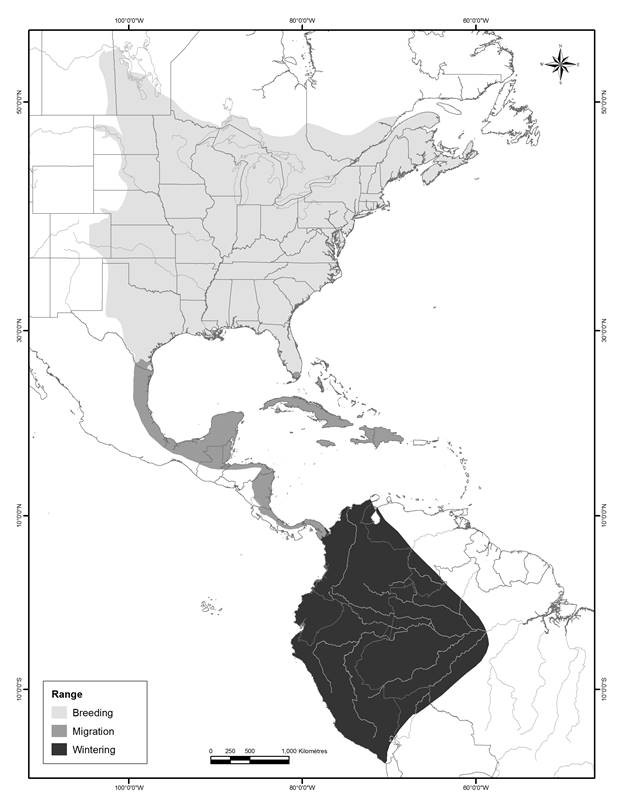
Figure 1. Global distribution of the Chimney Swift (adapted from Ridgely et al. 2007)
The map shows the global distribution of the Chimney Swift for breeding, migration, and wintering. The breeding grounds range from southeastern Canada to southeastern United States; the migration grounds are located along the eastern coast of Central America; and the wintering grounds are located on the northwestern end of South America.
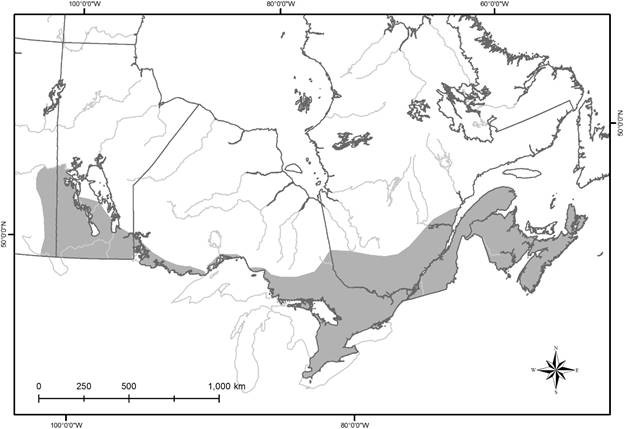
Figure 2. Breeding range of the Chimney Swift in Canada (Canadian Wildlife Service unpublished data)
The map shows the breeding range of the Chimney Swift in Canada. It ranges from southern Saskatchewan, southern Manitoba, southern Ontario, and southern Quebec, to New Brunswick and Nova Scotia.
3.3 Needs of the Chimney Swift
In Canada, the Chimney Swift is primarily associated with urban and suburban areas as well as small towns. It spends most of the day in flight feeding on flying insects wherever it can find them. This includes urban areas, rural and agricultural areas, aquatic and wetland environments and forests. It is thus difficult to associate the species with one specific type of habitat since its presence in an area depends mainly on the abundance of flying insects and the availability of suitable nesting and roosting sites (COSEWIC 2018). The Chimney Swift needs a vertical cavity with rough surfaces to which it can cling, spend the night and attach its nest (COSEWIC 2018). These sites protect the birds from inclement weather and predators (Graves 2004). Both nesting and roosting sites are generally occupied year after year (Fischer 1958; Gauthier et al. 2007). It is important to note that since the Chimney Swift is rarely observed in its natural habitat except in flight, human-made sites used for nesting or roosting are currently the main elements that can be used to characterize its habitat.
Prior to European settlement in North America, it is likely that the Chimney Swift nested and roosted mainly inside large hollow trees in old-growth forests (COSEWIC 2018). When large-scale logging began in the early 19th century, forests containing suitable trees for the species became increasingly scarce, leading the Chimney Swift to use human-made structures, particularly chimneys, for nesting and roosting. The species has thus shown adaptability in choosing its nesting sites. Today, the Chimney Swift is primarily associated with urban and suburban areas where chimneys are available. An unknown proportion of the population is associated with mature forests (COSEWIC 2018).
The Chimney Swift most often nests in chimneys (generally having an opening diameter greater than 28.5 cm), although it also uses large hollow trees (> 50 cm in diameter at breast height, or DBH) (COSEWIC 2018). The species commonly nests in old brick or stone chimneys built before the 1960s; however, it occasionally uses vent pipes, wells, silos, barns, tobacco-drying sheds and abandoned buildings. Quebec data appear to show that in the summer, the temperature inside chimneys used as nesting sites rarely drops below 13 ºC at night (COSEWIC 2018), while the lowest temperatures recorded in a study at nesting sites in New Brunswick and Nova Scotia were 9.7 ºC and 11.7 ºC, respectively (le Roux et al. 2019). This latter study found that Chimney Swifts preferred chimneys that buffered the nesting site from excess ambient heat.
The species is known for its gregariousness. At night and on days with inclement weather (e.g., heavy rain, wind, cold temperature), Chimney Swifts gather at roosting sites in flocks ranging in size from several dozen to more than 1,000 birds (Steeves et al. 2014). Chimneys used as roosting sites are generally bigger than those used for nesting. Roosts are used primarily during migration, when the birds arrive on their breeding grounds, and after the breeding season just before the birds migrate to their wintering area (Steeves et al. 2014). Some non-breeding individuals and failed breeders continue to congregate in roosts at night throughout the breeding season (Steeves et al. 2014). All along the migration route, the birds spend their nights in such roosting sites (Steeves et al. 2014).
Chimney Swifts arrive on their breeding grounds in Canada between late April and late May. The period of possible occupancy of the nesting structure is about four months, from the beginning of May to the beginning of September. Once the nest site is selected, the birds will start the nesting season which usually extends from late May to mid-August (COSEWIC 2018). The nest takes close to 18 days or more to build. The egg-laying period can vary and may take about seven days for a clutch of four eggs, since eggs are generally laid at a rate of one every two days (COSEWIC 2007). Incubation takes on average 19 days (Fischer 1958, Steeves et al. 2014). The chicks remain in the nest for an average of 19 days, after which they leave it to cling to the interior walls of the structure (Fischer 1958). Juveniles take their first flight outside the structure at about 30 days of age (Fischer 1958). They may return to the nesting structure for another one or two weeks (Steeves et al. 2014), and may also be able to use other structures during this period (Manitoba Chimney Swift Initiative, unpublished data, 2021). Fall migration occurs from late July to late September. In Ontario, the majority of Chimney Swifts have left for their wintering grounds by October, although a small number of birds remain until the end of the month (Birds Canada, unpublished data). During migration, the Chimney Swift requires access to an abundance of insects and high-quality roosting sites to meet its significant energy needs (Steeves et al. 2014).
Information on the Chimney Swift’s wintering habitat is incomplete. However, its roosting sites in wintering areas appear to resemble those used in its breeding range or during migration (COSEWIC 2018). At night the species roosts in chimneys, churches, caves (Fjeldså and Krabbe 1990) and hollow trees in the Amazon forest (Whittemore 1981). Habitats used include open areas, riparian forests, tropical lowland deciduous forest, and areas undergoing regeneration (Rappole et al. 1983; Stotz et al. 1996). The species also frequents irrigated farmland and suburban and central urban areas (Hughes 1988). It regularly occurs on the Peruvian coast and can also be seen annually in regions at elevations of up to 2,500 metres and sometimes even 3,000 metres (Hughes 1988).
Little is known about the Chimney Swift’s diet, but it is known to feed on insects, in particular Trichoptera, Ephemeroptera, Diptera, Coleoptera, Hymenoptera and Hemiptera. An abundant supply of insects is required to meet the dietary needs of both adults and chicks (Steeves et al. 2014). Chimney Swifts also need water sources, from which they drink while in flight by skimming the surface with their bills (Steeves et al. 2014).
4. Threats
The threat assessment for the Chimney Swift is based on the IUCN-CMP (World Conservation Union–Conservation Measures Partnership) unified threats classification system. Limiting factors are not considered during this assessment process. Threats are defined as the proximate activities or processes that have caused, are causing, or may cause the destruction, degradation, and/or impairment of the entity being assessed (population, species, community, or ecosystem) in the area of interest (global, national, or subnational). This threat assessment is adapted from that in COSEWIC (2018). For more detailed information on how the values are assigned in the table (Table 2), see the table footnotes. For purposes of threat assessment, only present and future threats are considered. Historical threats, indirect or cumulative effects of the threats, or any other relevant information that would provide a better understanding of the nature of the threats are presented in the Description of Threats section.
4.1 Threat assessment
| Threat Number | Threat | Impacta | Scopeb | Severityc | Timingd |
|---|---|---|---|---|---|
| 1 | Residential and commercial development | Medium | Large | Moderate | High |
| 1.1 | Housing and urban areas | Low | Restricted | Moderate | High |
| 1.2 | Commercial and industrial areas | Low | Restricted | Moderate | High |
| 2 | Agriculture and aquaculture | Unknown | Unknown | Moderate | High |
| 2.1 | Annual and perennial non-timber crops | Unknown | Unknown | Moderate | High |
| 4 | Transportation and service corridors | Negligible | Negligible | Negligible | High |
| 4.1 | Roads and railroads | Negligible | Negligible | Negligible | High |
| 4.2 | Utility and service lines | Negligible | Negligible | Negligible | High |
| 5 | Biological resource use | Low | Small - Restricted | Slight | High |
| 5.1 | Hunting and collecting terrestrial animals | Negligible | Negligible | Negligible | High |
| 5.3 | Logging and wood harvesting | Low | Small - Restricted | Slight | High |
| 6 | Human intrusions and disturbance | Low | Restricted | Slight | High |
| 6.3 | Work and other activities | Low | Restricted | Slight | High |
| 7 | Natural system modifications | High - Medium | Pervasive | High - Moderate | High |
| 7.1 | Fire and fire suppression | Unknown | Unknown | Unknown | High |
| 7.3 | Other ecosystem modifications | High - Medium | Pervasive | High - Moderate | High |
| 8 | Invasive and other problematic species | Negligible | Negligible | Negligible | High |
| 8.2 | Problematic native species | Negligible | Negligible | Negligible | High |
| 9 | Pollution | Unknown | Large | Unknown | High |
| 9.3 | Agricultural and forestry effluents | Unknown | Large | Unknown | High |
| 9.5 | Air-borne pollutants | Unknown | Large | Unknown | High |
| 11 | Climate change and severe weather | Unknown | Pervasive | Unknown | High |
a Impact – The degree to which a species is observed, inferred, or suspected to be directly or indirectly threatened in the area of interest. The impact of each stress is based on the severity and scope ratings and considers only present and future threats. Threat impact reflects a reduction of a species population or decline/degradation of the area of an ecosystem. The median rate of population reduction or area decline for each combination of scope and severity corresponds to the following classes of threat impact: very high (75% decline), high (40%), medium (15%) and low (3%). Unknown: category used when impact cannot be determined (e.g., when the values for scope and severity are unknown). Not calculated: impact was not calculated when the threat does not occur within the assessment period (e.g., timing is insignificant/negligible or low because the threat existed only in the past). Negligible: when the value for scope or severity is negligible. Not a threat: when the value for severity is neutral or there is a possible benefit.
b Scope – Proportion of the species that can reasonably be expected to be affected by the threat within 10 years. Usually measured as a proportion of the species’ population in the area of interest (pervasive = 71 to 100%; large = 31 to 70%; restricted = 11 to 30%; small = 1 to 10%; negligible < 1%).
c Severity – Within the scope, the level of damage to the species (usually measured as the percentage of reduction in the species’ population) expected to be caused by the threat within a 10-year or three-generation timeframe (extreme = 71 to 100%; serious = 31 to 70%; moderate = 11 to 30%; slight = 1 to 10%; negligible < 1%; neutral or possible advantage ≥ 0%).
d Timing – High = continuing. Moderate = only in the future (could happen in the short term [< 10 years or 3 generations]) or now suspended (could come back in the short term). Low = only in the future (could happen in the long term) or now suspended (could come back in the long term). Insignificant/Negligible = only in the past and unlikely to return, or no direct effect but limiting.
4.2 Description of threats
The Chimney Swift faces a number of threats. Although each of these on its own can have a varying impact on the population, the combined effects of these threats make their overall impact high (COSEWIC 2018). The main threats to the species are presented in section 4.2.1, and threats with a negligible or unknown impact are outlined in section 4.2.2. The COSEWIC status report (2018) can be consulted as a complement to the description of threats in this section.
4.2.1 Main threats
IUCN threats 1.1 Housing and urban areas and 1.2 Commercial and industrial areas (medium cumulative impact)
Chimney demolition or modification
Chimney Swifts are dependent on chimneys in urban and suburban areas for nesting and roosting sites. Residential and commercial development is a medium impact threat for the Chimney Swift (Table 2) since it results in the demolition or modification of chimneys and thus the loss and degradation of habitat for the species (COSEWIC 2018). Most of the chimneys that provide suitable habitat for Chimney Swifts were built before 1960 (Gauthier et al. 2007); therefore, many of them have reached the end of their service life and need to be demolished or renovated. More recent buildings do not have chimneys (because electric heating is more common) or they have chimneys that are unsuitable for the Chimney Swift (natural gas) (COSEWIC 2018). Newer chimneys, along with older ones that have been renovated, have an inner metal liner that is too smooth for the Chimney Swift to cling to. In addition, a number of municipalities require that chimneys that are still being used for heating have spark arresters and that inactive chimneys be closed or capped (Lamoureux 2012), both of which make them inaccessible to the species. Similarly, the installation of exclusion devices to keep out undesirable species can block access to otherwise suitable chimneys. Depending on the region, 14% to 29% of chimneys known to be used by the Chimney Swift in Canada were destroyed or rendered unsuitable for the species between 1998 and 2017 (COSEWIC 2018). The scope assessment for threats 1.1 (Housing and urban areas) and 1.2 (Commercial and industrial) is based in part on this known decrease in chimney availability. Although each were found to have a restricted scope (11–30% of population affected within 10 years; Table 2), their combined effect is such that the scope of the threat posed by residential and commercial development is large (Table 2), particularly since the scope of threat of housing and urban areas is at the upper limit of the “restricted” category. However Fitzgerald et al. (2014) found in 36 communities in southern Ontario, 24% of suitable chimneys were occupied by the species, suggesting that this habitat component is not limiting in this portion of the range at the current time.
Urban and suburban development – Change or decline in insect populations
Draining or filling of wetlands for residential or commercial development can result in changes in insect populations or reduce the availability of insect prey for the Chimney Swift and thus adversely affect the species’ productivity (COSEWIC 2018).
Collisions with buildings
This aspect of the threat was not assessed in COSEWIC (2018). According to the Global Bird Collision Mapper, a citizen science tool, nearly 75,000 bird collisions with buildings were recorded in Canada between 2000 and 2022, 19 of which involved Chimney Swifts (0.03%), mainly during migration (Global Bird Rescue 2022). Although these data are not exhaustive, the adverse effect on the population (i.e. severity) will likely be negligeable (< 1%) over the next decade (or the next three generations of the species).
IUCN threat 5.3 Logging and wood harvesting (low impact)
Forestry practices on the breeding grounds
The fragmentation and loss of old-growth forests through forestry operations can reduce the availability of natural nest and roost sites for the Chimney Swift (COSEWIC 2018). Before the European colonization of North America, the sites used by Chimney Swifts for nesting and roosting consisted mainly of hollow trees greater than 50 cm in diameter at breast height (Gauthier et al. 2007; Steeves et al. 2014; Zanchetta et al. 2014). Historical and present-day forest clearing in a large part of eastern North America has considerably reduced the number of trees of suitable size for this species (Gauthier et al. 2007). In addition, current logging practices, which favour a relatively short harvesting cycle to meet market demand, translate to a smaller percentage of trees that are old enough or large enough to serve as Chimney Swift nesting or roosting sites. The possibility of preserving suitable trees is also reduced by forestry practices that favour the removal of hollow trees in logging areas for safety reasons. To reflect this situation and given 36.7% of the Chimney Swift’s Canadian range (see Figure 2) is located in areas of managed forest (National Forest Inventory of Canada 2020), the scope of this threat, assessed as “small” (1 to 10%) in COSEWIC (2018), was modified to “small - restricted” (1 to 30%) in Table 2. No more specific information is available on the proportion of the species that can reasonably be expected to be affected by the threat within 10 years (or 3 generations); however, the proportion concerned could exceed the range for the “small” category (1 to 10%).
Logging on the wintering grounds
Since the Chimney Swift uses hollow trees in its South American wintering range, the species is likely threatened by the intensive logging taking place in the Amazon forest (COSEWIC 2018). No information is available on the effects of logging on the wintering grounds.
IUCN threat 6.3 Work and other activities (low impact)
Chimney sweeping and heating during the breeding season
Chimney sweeping is essential for maintaining the integrity of the inner walls of chimneys and to reduce the risk of fire. When done outside of the breeding period, this work is not harmful to the species because the nest often falls to the bottom of the chimney in fall or winter or is simply not reused by birds from one year to the next. However, chimney sweeping that is conducted during the period of possible occupancy, namely between early May and early September, can pose a threat to the species (Table 2), because it can destroy the nest, eggs and chicks (COSEWIC 2018). A survey of professional chimney sweeps in the Maritimes revealed that this work is done mainly in the fall; however, it can be done at any time of year, and certain municipalities in Quebec request that chimney sweeping be done during the summer (Lamoureux 2012; COSEWIC 2018).
Some chimneys are used for heating in cold weather during the breeding season, preventing their use by swifts or destroying nests or killing adults (sometimes large numbers of roosting swifts) (COSEWIC 2018).
IUCN threat 7.3 Other ecosystem modifications (high - medium impact)
Decline in insect populations
A reduction in insect prey availability to the Chimney Swift, an aerial insectivore, represents a change in the ecosystem to which it belongs and is the most significant threat to the species (Table 2; COSEWIC 2018). The use of insecticides in forestry and agriculture, in urban insect control programs, and in control programs for insects that carry pathogens, such as the West Nile virus, affects the abundance and composition of insect communities (Avian Effects Dialogue Group 1994; Poulin et al. 2010; Wood and Goulson 2017; COSEWIC 2018) and thus affects the Chimney Swift’s food sources. A number of recent studies have established a probable link between the use of insecticides, particularly neonicotinoids, and declines in populations of insect pollinators (Goulson 2013; Godfray et al. 2014). The use of insecticides is widespread throughout the species’ range and has intensified in recent decades (COSEWIC 2018). Certain herbicides (e.g. glyphosate, atrazine or 2,4-D
Draining and filling of wetlands to control mosquito populations on the Chimney Swift’s breeding and wintering grounds as well as along its migration routes may also lead to decreases in insect prey availability for the species (COSEWIC 2018).
Ecosystem modifications have the potential to reduce food availability at key times in the Chimney Swift’s life cycle, which could have a significant impact on the survival of individuals. However, the quantitative data on this subject are limited (COSEWIC 2018).
4.2.2 Threats with a negligible or unknown impact
IUCN threat 2.1 Annual and perennial non-timber crops (unknown impact)
Although the direct impact of this threat was not assessed in COSEWIC (2018), the information presented there suggests that this threat would likely have a negative impact on the Chimney Swift. For example, the conversion of natural habitats to annual or perennial crops could destroy woodlands or trees with potential as nesting or roosting habitats. However, the scope of the threat is difficult to assess since the species’ use of natural cavities is poorly documented. Some prey insect-producing environments could also be destroyed or degraded during these types of conversions. Furthermore, a decline in the diversity of cultivated plant species—for example, due to the conversion of perennial crops (e.g. hay) to annual crops (e.g. corn or soybeans)—could reduce the diversity and abundance of prey insects (Haddad et al. 2001). Across the species’ global range, changes in agricultural practices (e.g. agricultural intensification) have contributed to the decline in flying insects, which is the main threat faced by the Chimney Swift (COSEWIC 2018). The impact of agricultural activities on the decline of flying insects is taken into account in IUCN threat 7.3 (Other ecosystem modifications).
IUCN threat 4.1 Roads and railroads (negligible impact)
Collisions with vehicles
Chimney Swifts are at risk of being killed by vehicle strikes when they fly over roads (Bohlen 1989; COSEWIC 2018). This seems to occur more often in cold weather, when insects also fly at a lower level.
IUCN threat 4.2 Utility and service lines (negligible impact)
Collisions with communication towers
The species may occasionally be at risk from collisions with communications towers (COSEWIC 2018).
IUCN threat 5.1 Hunting and collecting terrestrial animals (negligible impact)
Destruction of nests
Many homeowners consider the presence of Chimney Swifts in their chimneys to be a nuisance or concern. For example, they dislike hearing the chicks’ begging calls and they incorrectly believe that Chimney Swifts produce large accumulations of droppings or create a fire risk. Some homeowners may arrange to have their chimneys cleaned to get rid of the birds (Steeves et al. 2014). Public misunderstanding and lack of knowledge about the species are therefore likely to lead to the destruction of nests every year (COSEWIC 2018).
IUCN threat 7.1 Fire and fire suppression (unknown impact)
Fires in the wintering range
On the species’ wintering grounds, fires set to clear land for agriculture that end up destroying large, hollow trees may pose a threat to the Chimney Swift (COSEWIC 2018). However, not enough information is available at present to assess the impact of this threat.
IUCN threat 8.2 Problematic native species (negligible impact)
Predation
Predation by certain native species may at times have a negative impact on Chimney Swift populations (COSEWIC 2018). For example, raccoons (Procyon lotor) and squirrels (Sciurus spp.) are suspected predators of Chimney Swift chicks (Steeves et al. 2014). Accounts of predation on adult swifts usually involve birds of prey, such as the Merlin (Falco columbarius) (COSEWIC 2018). The Merlin has become increasingly widespread in urban areas (Warkentin et al. 2005) and its population is on the rise in Canada (Smith et al. 2022). In addition, a study by Evans et al. (2017) reported 38 cases of predation by Herring Gulls (Larus argentatus) at a roost in Sault Ste. Marie, Ontario in 2015.
IUCN threat 9.3 Agricultural and forestry effluents (unknown impact)
Pesticide use
The direct effects of pesticide use in agriculture and forestry on insectivorous birds vary with the chemical composition of the products concerned and may include acute toxicity, sublethal effects or reduced reproductive success (COSEWIC 2018). Little information is available at present to assess the severity of this threat to the Canadian population of the Chimney Swift.
IUCN threat 9.5 Air-borne pollutants (unknown impact)
Acid rain and bioaccumulation of mercury
Acid rain and bioaccumulation of mercury may affect certain Chimney Swift populations, especially if swifts consume insects originating from contaminated wetlands (COSEWIC 2018). Although the effects of mercury on the Chimney Swift have not been documented, studies have shown that this pollutant can reduce reproductive success, impair immune function and modify the behaviour of some bird species (COSEWIC 2018).
IUCN threat 11. Climate change and severe weather (unknown impact)
Climate change and extreme weather could have adverse effects on Chimney Swift populations, but their impact and severity are currently unknown (Table 2; COSEWIC 2018). More specific threats associated with this broad category are described below. It should be noted that the impact, scope, severity and timing were assessed only for the broad threat category and not for the subcategories (Table 2).
As an aerial insectivore, the Chimney Swift is affected by weather conditions that influence the presence and abundance of flying insects. Climate change is likely to generate changes for many insect populations and the ecosystems they inhabit (Stange and Ayers 2010; Jonsson et al. 2015). There is a strong synchronization between birds’ reproductive timing (egg hatching) and peak food (insect) abundance. Climate change could create a temporal mismatch between the energetic requirements of the Chimney Swift and the availability of insect prey (COSEWIC 2018).
Drought causing a decrease in the abundance of insect prey for the Chimney Swift could represent a threat to the species (COSEWIC 2018).
In Canada, prolonged periods of rain, wind and cold in late spring or early summer, shortly after the Chimney Swifts arrive on their breeding grounds, could cause mortality or reduce reproductive success due to a lack of food resources (Newton 2007; Steeves et al. 2014; COSEWIC 2018). Excessively high temperatures could also result in dehydration and mortality of nestlings (COSEWIC 2018). According to Parry et al. (2007), episodes of extreme weather conditions could become more frequent with climate change.
Climate change could also reduce the lifespan of chimneys by accelerating their deterioration due to more frequent freeze-thaw cycles, which degrade the cement between the bricks and stones (COSEWIC 2018). The weakened chimney structure would then require repair or removal, which would result in a loss of chimneys suitable for nesting and roosting.
Climate change could affect the frequency, intensity and trajectory of hurricanes (NOAA 2005). Hurricanes are likely to cause Chimney Swift mortality during the fall migration period as well as on the wintering grounds. In 2005, Hurricane Wilma caused the death of a large number of Chimney Swifts (likely a few thousand), and this had an impact on the breeding population across a large part of the species’ breeding range (Dionne et al. 2008).
Changes in wind patterns could have certain effects on the Chimney Swift (COSEWIC 2018). A study on the Tree Swallow (Tachycineta bicolor), another aerial insectivore, showed that wind could affect the breeding phenology
5. Population and distribution objectives
The long-term population and distribution objective is to maintain a stable Chimney Swift population trend
The short-term population and distribution objective for the Chimney Swift in Canada is to halt the population decline within 10 years
5.1 Rationale for the population and distribution objectives
Over the past decades, the Chimney Swift population has experienced a significant decline across Canada, and it was specifically this criterion (decline of > 30% to 50%) that led to the species’ designation as Threatened (COSEWIC 2018). To improve the species’ status (i.e. from Threatened to Special Concern), the rate of decline must be reduced to less than 30% over 10 years or three generations.
Several threats to the species still exist as explained in the threat section above, but there is no simple way to address them. Specifically, changes and declines in insect populations have occurred as a result of a variety of factors that have adversely affected them, through mechanisms that are not yet all well understood. Action will have to be taken to restore the insect populations, but it could take years before the benefits are seen.
Today, the vast majority of the species’ known nesting and roosting sites, which comprise the species’ entire current known extent of occurrence, are located in human-made structures that are part of the built heritage. These include primarily chimneys and, to a lesser extent, silos, barns and wells, which have gradually declined in number. Even when they are retained, these structures are likely to require renovations or repairs to meet safety standards or comply with new construction standards. Such changes may render them unsuitable for Chimney Swifts.
In addition, prior to European colonization in the 16th century, mature forests provided the Chimney Swift with hollow trees suitable for nesting and roosting. Forests containing large-diameter hollow trees have long since given way to agriculture and urban development. Forest harvesting cycles are such that there is not enough time for trees to reach a size and conditions suitable for Chimney Swifts.
In short, given the threats that still exist to the Chimney Swift population and its habitat, it could be very difficult to return the population to its pre-decline level. Chimney Swift recovery efforts cannot be based solely on the availability of existing human-made structures, since the number of such structures will decline over time. With the gradual loss of existing human-made structures and the challenge posed by the return of Chimney Swifts to their natural habitat, as well as the uncertainties regarding the use of Chimney Swift towers, increasing the population in the short and long term is not a realistic objective. The objective must be to first halt the species’ decline and to then maintain the population for a period of 10 years. Considerable time and effort will be required to achieve this objective as a number of factors that adversely affect the species still exist.
Outreach to owners of buildings used by Chimney Swifts and the implementation of stewardship activities to preserve a sufficient number of suitable human-made structures for breeding and roosting activities by the species for as long as possible will contribute to the achievement of the objectives. Maintaining existing human-made structures will be necessary to achieve the short-term recovery objective. It will also contribute to the long-term recovery objective, although it is currently difficult to estimate the proportion of structures that will have to be maintained over time. This information will be needed before the short-term recovery objective is met. Best management practices for chimneys suited to the species will have to be developed and distributed to owners of buildings with chimneys and to chimney-cleaning companies. A network of Chimney Swift towers (freestanding or attached to buildings) will, if proven to be effective and appropriate, be established to offset the gradual loss of existing human-made structures (during the period of transition to natural habitat use). Additional approaches, including public outreach, SARA compliance promotion, protection of residences within the meaning of SARA, and protection under the Migratory Birds Convention Act, 1994, will also have to be used to conserve and protect a sufficient number of human-made nesting and roosting sites, as well as adult swifts, their eggs and their young. The achievement of the recovery objectives will also require a better understanding of the threats to the species. Known threats to the Chimney Swift are both numerous and complex, and they are likely to have a cumulative effect. Filling knowledge gaps related to the main threats to the species is therefore relevant to facilitating its recovery.
To achieve the long-term recovery objective, the species’ decline will first have to be halted (short-term objective). In the longer term, action will have to be taken to restore flying insect populations and to increase the number of suitable nesting and roosting sites in the natural environment, specifically hollow trees of a sufficient diameter as well as mature trees that can ensure the long-term availability of these hollow trees. A number of unknowns exist, however, with regard to the present and future distribution, abundance, and availability of these trees and the extent to which they can help maintain a stable population in the species’ current Canadian range. Acquiring this knowledge and implementing measures to enable the species to use these trees are part of the strategic direction for recovery (section 6.2) and could take several decades.
The 10-year time frame for achieving the recovery objectives (consecutively) was considered an appropriate period for assessing changes in the Chimney Swift population. This time frame was chosen not only because halting the decline of a species is challenging and cannot be achieved in just a few years, but also because COSEWIC species assessments are prepared every 10 years. The assessment criteria often include reviewing population changes within 10-year windows. The BBS will be used for this purpose since it currently provides the best available estimates of changes in population trends. In addition, this source of data was used to support the species’ designation as Threatened. These objectives will be reviewed (and updated if needed) when preparing the report required five years after the recovery strategy is posted on the Species at Risk Public Registry, and every five years thereafter, to assess the implementation of the recovery strategy and the progress made towards meeting its stated objectives (section 46, SARA).
Aerial insectivores, including the Chimney Swift, are currently in decline in eastern North America. It is important to note that population changes at the continental level may have a significant effect on the feasibility of recovery in Canada. The risk of decline is increased by the limited possibilities for effectively reducing or mitigating some of the significant threats to the species (e.g., chimney modification or demolition, pesticide use, unfavourable weather conditions produced by climate change). Therefore, despite the best efforts described in this recovery strategy to mitigate the main threats and to ensure that a sufficient number of suitable nesting and roosting sites are available, the number of Chimney Swifts in Canada may continue to decline.
6. Broad strategies and approaches for meeting recovery objectives
6.1 Actions already completed or currently underway
For a number of decades, Environment and Climate Change Canada has been funding projects related to Chimney Swift conservation across its Canadian range through various programs (e.g. Habitat Stewardship Program and Aboriginal Fund for Species at Risk). Projects have included activities such as: undertaking targeted surveys for the species; identifying important habitat; studying the severity of and/or mitigating threats; soliciting observations and encouraging public reporting of sightings; and educating landowners on species identification, threats, and stewardship options. Some of these projects, along with those funded by the provinces and others, are described below.
- Identification and monitoring of certain nesting and roosting sites in Saskatchewan (Saskatchewan Breeding Bird Atlas), Manitoba (Manitoba Chimney Swift Initiative; Stewart et al. 2017; Poole and Ogilvie 2020), Ontario (Algoma SwiftWatch (Great Lakes Wildlife Research and Algoma University), Bert Miller Nature Club, Canadian Nuclear Laboratories, City of Mississauga, Essex County Field Naturalists’ Club, Birds Canada (Ontario SwiftWatch), Georgian Bay Biosphere Reserve, Halton/North Peel Naturalist Club, Hamilton Conservation Authority, Nature Aurora, Nature Barrie, Nature London (McIlwraith Field Naturalists), Nipissing Naturalists Club, Parry Sound Nature Club, Prince Edward County Field Naturalists Club, Sault Naturalists, Stratford Field Naturalists and Canadian Wildlife Service), Quebec (Canadian Wildlife Service, Nionwentsïo Office of the Huron-Wendat Nation Council, Regroupement QuébecOiseaux and several other conservation organizations), in New Brunswick (Birds Canada, Nature NB and Canadian Wildlife Service), and in Nova Scotia (Birds Canada, Blomidon Naturalists Society (Jim Wolford), Canadian Wildlife Service and Mersey Tobeatic Research Institute)
- Installation and assessment of Chimney Swift towers (freestanding or attached to buildings) in Manitoba (Manitoba Chimney Swift Initiative 2016; Firlotte et al. 2020), Ontario (Finity and Nocera 2012; Bird Studies Canada 2019), Quebec (Canadian Wildlife Service, Regroupement QuébecOiseaux, Société Provancher d’histoire naturelle, Sanatorium historique du Lac-Édouard, Montreal Botanical Garden, Musée des sciences et de la nature, Éco-Nature, Groupement Agro-Forestier Lotbinière Mégantic Inc., Club ornithologique des Hautes-Laurentides, Club des ornithologues de l’Outaouais, Héritage Saint-Bernard, Club des ornithologues de Québec, Centre de recherche industrielle du Québec, municipality of La Trinité-des-Monts, Centre 24-Juin, Centre de formation professionnelle Rimouski-Neigette, Zoo de Granby and private property owners), in New Brunswick (Nature NB), and in Nova Scotia (Government of Nova Scotia). Only a few of the many attempts to install Chimney Swift towers have been successful: five towers have been used as roosts (Bridgetown, NS; La Trinité-des-Monts, QC; and Selkirk, MB [n=3]) and nine have been used as nesting sites (Winnipeg, MB; Selkirk, MB; Etobicoke, ON; Lévis, QC; Lac-Édouard, QC [n=4]; and Granby, QC)
- Preparation of an overview of the implications of the presence of Chimney Swifts for insurance companies, chimney-cleaning companies and fire departments (Birds Canada, Regroupement QuébecOiseaux)
- Design and production of a Chimney Swift-friendly chimney cap (Éco-Nature et Regroupement QuébecOiseaux)
- Development of a decision support tool to assess nest and roost sites for maintenance, repair or reconstruction in Ontario and the Atlantic region by Birds Canada
- Establishment of the Chimney Swift Chimney Restoration Fund by Birds Canada, with the support of ECCC, Nature Saskatchewan, Regroupement QuébecOiseaux, the Nature Trust of New Brunswick, Nature NB, and the Nova Scotia Bird Society. This fund provides support for owners of chimneys and other structures used by Chimney Swifts as nesting sites or roosts that require repairs
- Production, by Regroupement QuébecOiseaux, of a guide on the conservation of the Chimney Swift and its habitat (Perreault and Pérez 2021). This guide, which is intended primarily for conservation organizations and wildlife experts, provides guidelines and references on the various aspects of conserving the species in Quebec (e.g. characteristics of suitable habitats [chimneys, natural environments], surveys and data management, possible stewardship actions, available tools, resource organizations)
- Outreach and stewardship to municipalities and owners of buildings with chimneys used by the Chimney Swift in Nova Scotia and New Brunswick (Canadian Wildlife Service and Birds Canada), Quebec (Regroupement QuébecOiseaux and other conservation organizations), Ontario (Birds Canada) and Manitoba (Government of Manitoba, Manitoba Chimney Swift Initiative)
- Reopening of chimneys with blocked access previously used by Chimney Swifts, required by the Government of Manitoba as a mitigation measure for projects involving the modification of chimneys used by the species
- Outreach to increase awareness of best practices and chimney sweep regulations among chimney sweeps and municipalities (Regroupement QuébecOiseaux and other conservation groups)
- Consideration of the Chimney Swift in conservation planning initiatives such as Species at Risk Partnerships on Agricultural Lands (SARPAL) in New Brunswick and Kespukwitk/Southwest Nova Scotia Priority Place
- Research on foraging behaviour, on the birds’ daily movements around nest sites, on breeding success and reproductive rates, on changes in diet that have occurred in recent decades, on the history of the presence of contaminants in the species’ diet and on the relationship between ambient temperature and bird behaviour in roost sites (Finity et al. 2010; Nocera et al. 2012; Stewart and Stewart 2013; Farquar et al. 2018)
- Research on Chimney Swift habitat, including the availability of chimneys, the use of trees by Chimney Swifts, temperature conditions at nesting sites, and the species’ use of territory during breeding and migration (Regroupement QuébecOiseaux 2008; Fitzgerald et al. 2014; Zanchetta et al. 2014; Société zoologique de Granby 2018; Devost et al. 2019; le Roux et al. 2019)
- Development of a pan-Canadian survey protocol for nesting and roosting sites (Rioux et al. 2010; Shaffer et al. 2022) and study on a survey protocol aimed at limiting the incidence of nondetection error and reducing threats to nest sites (Purves et al. 2019)
- Consolidation of data on the existence of nesting sites in natural environments in the Prairies (Manitoba Chimney Swift Initiative), Ontario (Birds Canada), Quebec (Regroupement QuébecOiseaux and Canadian Wildlife Service) and Atlantic Canada (Birds Canada)
6.2 Strategic direction for recovery
| Threats or limiting factors | Broad strategy for recovery | Priority | General description of research and management approaches |
|---|---|---|---|
| All threats | Conservation and stewardship of the species and its habitat | High | Support and implement measures promoting the recovery of insect populations, such as reducing pesticide use, conserving areas favourable to insect reproduction, and adopting appropriate measures for addressing climate change |
| All threats | Conservation and stewardship of the species and its habitat | High | Support stewardship efforts with owners of structures used by the species, in order to maintain the integrity of these structures and minimize risks to the individuals using them |
| All threats | Conservation and stewardship of the species and its habitat | High | Reduce the threats to natural nesting habitats and encourage the presence of a large number of large hollow trees in forests, woodlots and parks |
| All threats | Conservation and stewardship of the species and its habitat | Medium | Promote collaboration with partners in North and South America aimed at working to maintain natural habitats of a quality that is required to meet the species’ needs during migration and wintering |
| All threats | Conservation and stewardship of the species and its habitat | Medium | If this technique is found to be fully effective, increase the number of human-made nesting and roosting sites by installing networks of Chimney Swift towers that are suitable for nesting and roosting |
| All threats | Conservation and stewardship of the species and its habitat | Medium | Plan for the transition from existing human-made structures (nesting and roosting) to natural habitat, as well as the use of Chimney Swift towers (if found to be fully effective) |
| Knowledge gaps | Surveys and monitoring | High | Increase knowledge of the species’ demographics (e.g., population size and trend, clutch size, reproductive success, distribution) |
| All threats and knowledge gaps | Research | High | Increase knowledge of the use of the natural environment for nesting and roosting |
| All threats and knowledge gaps | Research | Medium | Improve knowledge of the species’ diet in Canada |
| All threats and knowledge gaps | Research | Medium | Increase knowledge of the species’ distribution, habitat and threats on wintering grounds in collaboration with partners in North and South America |
| All threats and knowledge gaps | Research | Medium | Increase knowledge of Chimney Swift towers in order to develop effective models |
| All threats and knowledge gaps | Research | High | Increase knowledge of the characteristics of human-made structures and of methods for increasing their useful life in order to develop effective and appropriate conservation strategies |
| All threats and knowledge gaps | Research | Medium | Identify the existing human-made structures that will need to be maintained over time, or that could be restored, in order to achieve the long-term recovery objective |
| All threats and knowledge gaps | Research | Low | Obtain knowledge needed to determine the impact of threats about which little is known, including those in section 4.2.2 |
| All threats | Communication, partnerships, outreach and education | High | Develop and implement a strategy for communicating with the general public, Indigenous communities, owners of human-made structures used by the Chimney Swift, chimney sweeps, building contractors and other interest groups |
| All threats | Communication, partnerships, outreach and education | Medium | Promote collaboration between governments, municipalities, landowners, Indigenous communities, the forestry sector, agricultural producers, industry and other interest groups to mitigate the threats to the species, its habitat and its prey |
| All threats | Legislation and policy | High | Promote compliance with international, federal (e.g. SARA, MBCA), provincial and municipal legislation and policies that will protect Chimney Swifts and their habitat |
| All threats | Legislation and policy | High | Promote new and existing legislation and implement policies and programs to reduce the use of pesticides that affect insect populations that are part of the Chimney Swift’s diet |
| All threats | Legislation and policy | High | Investigate and promote means by which to renovate, repair or upkeep existing chimneys to meet safety standards or comply with new construction standards while maintaining their suitability for Chimney Swifts |
6.3 Narrative to support the recovery planning table
The recovery of the Chimney Swift will require the collaboration and cooperation of international, federal, provincial and territorial jurisdictions, Indigenous communities, local communities, landowners, industry and other interested parties. Since the majority of Chimney Swift nesting and roosting sites are currently associated with human-made structures, communication and stewardship strategies will be particularly important.
Conservation and stewardship of the species and its habitat
Conservation actions aimed at maintaining the diversity and abundance of insects are crucial to supporting the recovery of the Chimney Swift: promoting a reduction in pesticide use (particularly broad-spectrum pesticides) is a critical step to be taken to support the species’ recovery. Conserving, managing and restoring suitable insect-producing habitats (e.g. wetlands and aquatic environments) is also a priority in order to maximize swifts’ survival when they are in Canada.
Owners of human-made structures (including those in residential, commercial, public or religious buildings) and all stakeholders involved in some aspect of the species habitat will play a key role in supporting the species’ recovery. Therefore, it is important to work closely with all of these owners and stakeholders to increase awareness and to support them in carrying out suitable stewardship actions. Another priority will be to promote the conservation or creation of natural habitats to encourage the species to rely more on natural sites as it did in the past. For example, in cooperation with forestry stakeholders, best management practices must be developed and implemented to reduce the threats in managed forests and increase the availability of large hollow trees in these areas. Given that not all of the chimneys or other human-made structures currently used will be conserved in the long-term, new human-made nesting or roosting sites will have to be created. These new sites are designed to provide habitat and are part of a transitional or complementary strategy that may help maintain the species’ numbers until it begins making greater use of natural habitat in the long-term. A large number of researchers, governments, stakeholders from various relevant sectors, Indigenous communities and volunteers will have to be called upon to coordinate activities, effectively communicate results, pool resources, and share findings in an efficient manner. It could also be advisable to reopen sites that were once used by the species, but that have recently been capped or otherwise blocked, provided the site is still suitable. Carrying out conservation and stewardship actions in collaboration with the appropriate authorities and with stakeholders in other countries visited by the species during migration and wintering is one approach that should be developed and implemented. Together, these actions should have a positive effect on other species at risk whose habitat needs are similar to those of the Chimney Swift (see Appendix B). The implementation of this recovery strategy will require significant financial resources over the short- and medium-term.
Surveys and monitoring
Prior to the publication of the 2007 COSEWIC report, knowledge about population status and distribution was limited. Although progress has been made (see COSEWIC 2018), there is still a need to enhance the existing monitoring programs (e.g. the BBS provides poor coverage of urban centres) and to expand their coverage to the species’ entire range. To obtain high-quality data, monitoring needs to be conducted over several decades. A number of key sector stakeholders, such as researchers, governments, Indigenous communities, conservation organizations, and volunteers, could take part in surveys and monitoring. The monitoring data will shed light on the species’ distribution, clutch size, reproductive success and population size and trends. The data can also be used to identify locations where action needs to be taken, including urgent measures, to protect nesting sites and roosts. Monitoring can also provide information on the effectiveness of the conservation measures (e.g. Chimney Swift towers) put in place. This information will be useful for measuring progress and re-assessing the species’ status.
Research
Over the long term, as existing human-made structures become less available for use as nesting and roosting sites, the Chimney Swift will need to make greater use of natural habitat, such as hollow trees. Consequently, increasing our knowledge about habitat use in natural areas is a priority. Although some evidence exists that the species still nests in hollow trees, such behaviour has rarely been observed. It is therefore not possible at this time to accurately determine the attributes of the natural habitat needed by the species, and this makes it difficult to promote the maintenance or development of suitable natural habitat for the species. In this context, it would also be useful to obtain (if available
To ensure the availability of nesting sites and roosts, cost-effective models of Chimney Swift towers will be needed. This will require increased knowledge of the structures used. However, it is important to find ways to extend the useful life of human-made structures currently used by the species in order to buy time to ensure a gradual transition to natural habitat to the extent possible. If the long-term recovery objective is to be achieved, it will also be necessary to identify the existing human-made structures that will have to be maintained on a priority basis over time, as well as structures that have been closed off but could be reopened (if feasible).
The threats to insectivorous bird species are serious. A better understanding of the multiple facets of those threats is needed in order to develop appropriate responses. Learning more about the species’ diet, identifying habitats that produce the types of insects consumed by Chimney Swifts (see section 7.2), and identifying the threats and factors affecting those environments are avenues of knowledge acquisition (including Indigenous knowledge) that should be given priority. Similarly, some threats have an unknown (or poorly documented) impact on the Chimney Swift breeding population in Canada (e.g., climate change and severe weather). Studies are needed to fill these knowledge gaps.
The Chimney Swift is a migratory species. During its annual cycle, it winters in South America, migrates through Central America, and breeds in North America. Each of these regions has an influence on the species’ survival. Collaboration with partners in these regions is necessary to obtain the knowledge required to improve our understanding of the threats to the species and to develop appropriate recovery strategies. Increasing our knowledge about the location of the wintering grounds and the threats to the species in those regions is also a priority. In addition, it would be useful to clarify the species’ use of natural and anthropogenic habitats—for example, to determine if swifts using human-made structures in Canada use natural cavities elsewhere (which would help in assessing the feasibility of swifts returning to their natural habitats).
Communication, partnerships, outreach and education
The majority of known Chimney Swift nesting and roosting sites are closely associated with human-made structures, and the species forages in natural areas as well as in urban, agricultural and forested areas. The recovery of the Chimney Swift is therefore closely linked to several facets of human activities. To promote the species’ recovery, communication, outreach and education strategies must be used to reach the many stakeholders who can have an influence on the species’ habitat. These stakeholders include: chimney sweeps, ‘pest’ control companies, insurance companies, fire departments, building standards organizations, and companies involved in the installation and repair of heating systems. Farmers, woodlot owners and land-use planners are examples of other stakeholders that are important to engage due to their influence on the availability of natural habitats such as insect-producing habitats. In addition, monitoring of the Chimney Swift population relies mainly on public participation, which needs to be encouraged, highlighted and supported. Observers in the field often act as an early warning system, since they can report specific problems related to nesting or roosting sites, allowing corrective measures to be taken more rapidly. Utilizing on-the-ground observers' experiences to their fullest potential can enhance the knowledge and resources available to promote recovery.
Given the complexity of implementing the strategic directions set out in section 6.2, the coordination of recovery efforts at different spatial scales (e.g., national and provincial) is required, whether this involves the data collection, best management practices or educational tools to assist the stakeholders concerned. Such coordination is also likely to accelerate the discovery of effective species’ recovery measures.
Legislation and policy
Legal tools also exist under the Migratory Birds Convention Act, 1994 (MBCA) and the Species at Risk Act (SARA) to protect nests, eggs and individuals and their habitat. It is crucial to ensure that these tools are well understood and used appropriately to promote the protection of the Chimney Swift. For example, promoting the integration and consideration of such provisions in municipal-level permitting systems is essential.
The damage or destruction of the Chimney Swift’s residence is prohibited on all lands in Canada. Section 33 of the SARA prohibits damaging or destroying the residence of one or more individuals of a listed threatened, endangered, or extirpated species if a recovery strategy has recommended the re-introduction of the species into the wild in Canada. With respect to a listed wildlife species that is an aquatic species or a species of bird protected under the Migratory Birds Convention Act, 1994, the prohibition applies automatically upon listing wherever the residences are found in Canada.
A description of residence for the Chimney Swift is published on the Species at Risk Public Registry for the purposes of providing clarity to enable Canadians to comply with the residence protection provision of SARA (s.33). The residence description indicates that nesting and roosting structures (e.g., chimneys, hollow trees) are considered residences throughout the year and remain residences until the species has not used them for nesting or roosting for three consecutive years. The nest is a residence only when occupied typically from May to September; the nest is no longer considered part of a residence when it is abandoned at summer’s end.
The Migratory Birds Convention Act, 1994 protects individuals, nests and eggs anywhere they are found in Canada, regardless of land ownership. The new Migratory Birds Regulations, 2022 (MBR), provide protection to migratory bird nests when they are considered to have a high conservation value for migratory birds. As stipulated in section (5) of the MBR, the nests of all migratory bird species are protected when they contain a live bird or a viable egg (generally during the nesting period).
Chimney sweeping carried out during the breeding season can destroy eggs and nests which is prohibited by SARA and the MBCA. Appropriate municipal regulations that incorporate and are consistent with MBCA and SARA prohibitions should therefore be developed in cooperation with the relevant authorities to ban chimney sweeping during the breeding season at sites occupied by the species. The same is true for ‘pest’ control companies.
Initiatives aimed at reducing the risks related to the use of pesticides (including neonicotinoids) and encouraging the adoption of alternative pest management approaches, practices and technologies are already underway (Agriculture and Agri-Food Canada 2016). These initiatives target a variety of habitats, including agricultural areas, forests and golf courses. To promote the recovery of the Chimney Swift, it is important to encourage the implementation of such initiatives and promote the development of additional legislation and policies, should this become necessary.
Federal, provincial and municipal legislation exists and deals with safety and construction standards related to the renovation and/or reparation of existing chimneys. It will therefore be important to work closely with all stakeholders in the construction industry to find and develop innovative means by which to renovate and/or repair chimneys to meet those standards while maintaining their suitability for Chimney Swifts.
7. Critical habitat
SARA defines critical habitat as “the habitat that is necessary for the survival or recovery of a listed wildlife species.” Under paragraph 41(1)(c) of SARA, recovery strategies must include an identification of the species’ critical habitat, to the extent possible, as well as examples of activities that are likely to result in its destruction. Under subparagraph 41(1)(c)(1) of SARA, the recovery strategy must also include a schedule of studies to identify critical habitat where available information is inadequate, as it is in the case of the Chimney Swift.
7.1 Identification of the species’ critical habitat
The identification of critical habitat for the Chimney Swift is based on two criteria: habitat occupancy and biophysical attributes of suitable habitat.
Given that almost all currently known Chimney Swift nesting sites or roosts in Canada are located in human-made structures, the current identification of critical habitat comprises exclusively human-made structures, which are required for the species recovery. Maintaining existing human-made structures is of paramount importance to achieve the short-term recovery objective. It will also contribute to the long-term recovery objective, although it is currently difficult to estimate the proportion of structures that will have to be maintained over time. This information will be needed to meet the short-term recovery objective.
The critical habitat of the Chimney Swift is partially identified in this recovery strategy, taking into account the best information that is available because basic information on the biophysical attributes and the location of suitable habitat used by the species in the natural environment, namely forested areas, is lacking. Available information on natural areas that produce insects that are part of the species’ diet is also very limited. Additional critical habitat units may be identified as new knowledge becomes available. A schedule that sets out the studies required to complete the identification of the species’ critical habitat is included (section 7.2, table 5).
7.1.1 Habitat occupancy
This criterion is intended to identify, with a reasonable degree of certainty, the suitable nesting and roosting sites used by the species. Since it is very difficult to find Chimney Swift nests, eggs and young because they are located in confined spaces, such as inside chimneys, it is necessary to rely on observations of swifts entering or leaving a structure. Habitat occupancy is determined on the basis of standardized survey data and incidental observations. Since the Chimney Swift is a bird species that is easily recognized by its characteristic shape, flight pattern and call, sightings reported by observers are considered reliable.
Chimney Swifts exhibit high nest and roost site fidelity. A site that is occupied as a nesting or roosting site is likely to be occupied again in subsequent years. Since a Chimney Swift may enter a structure in which it does not actually nest or roost, at least two observations of a swift entering or exiting a structure, on two different days, are required for it to be considered critical habitat. A single record of a swift observed entering or exiting a chimney, barn, or other human-made structure is considered insufficient to meet the occupancy criterion. An activity was added to the schedule of studies in order to validate records that require more details before they can be considered critical habitat. A single confirmed breeding record, within the sense of the breeding bird atlas, namely the presence of a nest, eggs or young in a structure, or the observation of a bird entering the structure with a twig, from 2011 to 2017 inclusive, was considered to be a good indicator of habitat occupancy. This time period was considered adequate to indicate recent occupancy, given the high degree of site fidelity exhibited by Chimney Swifts.
Knowledge of Chimney Swift occupancy of nesting and roosting sites has increased considerably over the last 20 years (since 2001) in Canada. Before this period, very little effort was devoted to locating nesting and roosting sites. As a result, the data used for the identification of critical habitat in this recovery strategy consist solely of observations made from 2001 to 2017, inclusive. Data for 2017 were available during the selection of critical habitat units. In addition, observations from 2001 to 2010 inclusive must be corroborated by a more recent sighting, i.e. one made from 2011 to 2017 inclusive, in order to demonstrate that the site has been recently occupied. The data sources consulted to establish critical habitat are presented in Appendix C.
The habitat occupancy criteria in human-altered areas are as follows:
- any confirmed breeding record between 2011 and 2017, namely the observation of a nest, eggs or young inside a structure or the observation of a bird entering a structure with a twig, or
- any observation of at least one Chimney Swift entering or leaving a structure, on at least two different days, including at least one between 2011 and 2017 and another between 2001 and 2017
The habitat occupancy criteria in natural areas will be developed once data have been obtained on the natural environment from the activities set out in the schedule of studies.
7.1.2 Biophysical attributes of suitable habitat
This criterion refers to the biophysical attributes of the various habitats in which individuals can carry out activities related to breeding (such as courtship, defence of territory, nest building, and foraging) and activities associated with roosting (Table 4). Given that all identified critical habitat sites are human-made structures, this table presents only the biophysical characteristics of this type of structure. Research on habitat characteristics in natural areas is identified in the schedule of studies (section 7.2). The biophysical characteristics of suitable habitat in natural areas will be defined when we have obtained data on this type of habitat from the activities outlined in the schedule of studies.
| Components of habitat suitability | Biophysical attributes |
|---|---|
| Nesting or roosting sites in human- built structures | Chimneys accessible to the species (i.e. unobstructed and large enough to allow birds to enter and leave freely) and with a rough or porous interior constructed of stone, brick, concrete or ceramic tile OR other vertical structures with interior walls made of wood, stucco, etc., such as barns, silos, wells, Chimney Swift towers, or abandoned buildings with openings allowing access to the interior (broken windows, door always open). Structures used as roosting sites are generally bigger than those used for nesting. In all cases, the interior surfaces to which Chimney Swifts cling are dimly lit |
7.1.3 Application of critical habitat identification criteria
In this recovery strategy, critical habitat for the Chimney Swift is partially identified as human-made structures occupied as nesting or roosting sites during the period from 2001 to 2017 (see section 7.1.1) that have suitable biophysical attributes as defined in section 7.1.2 (see also Figure 3).
- Biological function
- Nesting site: Site where Chimney Swifts build their nests and raise young
- Roosting site: Site where Chimney Swifts rest in groups at night or where they take shelter from cold, rain and wind
- Suitable habitat
- Human made: Chimneys, barns, silos, wells, cistems, artificial towers, abandoned buildings
- Critical habitat
- Unit: Each nesting or roosting site located in a human-made structure that meets the identification criteria is identifed as a critical habitat unit
The location of critical habitat of the Chimney Swift is presented using 10 × 10 km UTM grid squares (Appendix D: Tables D-1 to D-5; Figures D-1 to D-4.7). The UTM grid is part of a standardized grid system that indicates the general geographic area containing the critical habitat. This information can be used for planning and environmental assessment purposes. Critical habitat within each grid square consists of human-made structures that meet the criteria described in sections 7.1.1 and 7.1.2. Each human-made structure that was selected corresponds to a critical habitat unit (Figure 3). The geographical coordinates of each critical habitat unit are presented in Tables D-1 to D-5 and are indicated by a yellow dot within the associated 10 × 10 km square in Figures D-1 to D-4. Tables D-1 to D-5 also provide the thoroughfare and city where each human-made structure is located and information to correctly identify it if the building or property has more than one structure. More detailed information may be obtained on the location of each critical habitat unit to support the protection of the species and its habitat, on a case-by-case basis, by contacting Environment and Climate Change Canada’s Recovery Planning section at RecoveryPlanning-Planificationduretablissement@ec.gc.ca.
By applying the identification criteria described in sections 7.1.1 and 7.1.2, based on the most recent data for the 2001 to 2017 period, it is possible to identify a total of 1,026 units for the entire Canadian population, specifically 122 units in Manitoba, 381 in Ontario, 456 in Quebec, 28 in New Brunswick, and 39 in Nova Scotia. There are no known occupied chimneys in Saskatchewan for the 2001 to 2017 period, and therefore no critical habitat units have been identified in that province.
7.2 Schedule of studies to identify critical habitat
| Description of activity | Rationale | Timeline |
|---|---|---|
Conduct a survey in locations where:
| Identification of additional critical habitat to achieve the population and distribution objectives | 2023–2026 |
| Locate nesting and roosting sites in natural areas and define their biophysical characteristics | Identification of sites currently being used in natural areas with a view to identifying critical habitat | 2023–2026 |
| Model natural habitat that may contain suitable sites and validate the model | Identification of portions of the range that contain natural habitat suitable for the species and that could be identified as critical habitat | 2025–2027 |
| Determine the characteristics of habitats that support populations of insects on which the Chimney Swift feeds | Identification of sites that support populations of insects that are part of the Chimney Swift’s diet | 2025–2027 |
7.3 Activities likely to result in the destruction of critical habitat
Understanding what constitutes destruction of critical habitat is necessary for the protection and management of critical habitat. Destruction is determined on a case-by-case basis. Destruction occurs when part of the critical habitat is degraded, either permanently or temporarily, such that it can no longer serve its function when needed by the species. Destruction may result from a single activity at one point in time or from the cumulative effects of one or more activities over time.
Examples of activities likely to result in destruction of critical habitat for the Chimney Swift include, but are not limited to, activities that eliminate nesting or roosting sites, prevent the birds from gaining access to those sites, or modify structures to the extent that they are unsuitable for the species. Examples are presented in Table 6.
It is recognized that human-made structures used for nesting and roosting are temporary and may need periodic maintenance or may need to be removed for health and safety reasons. When such structures are identified as critical habitat, priority will be given to stewardship, voluntary measures, mitigation or other appropriate measures, in order to protect them. Where, for public health and safety reasons, it is unavoidable to remove a human-made structure used by the Chimney Swift for nesting or roosting or to modify it in such a way as to compromise its habitat function, a permit would be required before work can proceed.
In the event that repairs or changes to the interior or exterior of a human-made structure used by the Chimney Swift for nesting or roosting are needed, if the work is done outside the breeding period, it will not be considered destruction of critical habitat provided it does not impair habitat function. A permit would be required before work could proceed.
| Description of activity | Description of effect | Details of effect |
|---|---|---|
| Repairs to a chimney or other type of human-made structure (building, old barn, silo, well, etc.) that modify its internal structure or its opening | Destruction of critical habitat; loss of access to critical habitat | The interior walls of chimneys or other types of human-made structure must be textured so that Chimney Swifts can cling to the vertical surface. In addition to being rough-textured, it must be sufficiently porous to allow the bird’s saliva to cement the nest to the wall. Modifications to the texture of the interior walls of chimneys or other types of human-made structure that make them unsuitable for use by Chimney Swifts, such as the installation of metal liners in chimneys, is considered destruction of critical habitat. A modification that results in a change to the internal conditions of the structure (temperature, light, etc.) is considered destruction of critical habitat. To gain access to the interior of a chimney or other human-made structure, the Chimney Swift must be able to pass through the opening without encountering an obstruction. The opening must therefore remain unobstructed and be large enough to allow the bird to enter and leave freely. An aesthetic change to the exterior of a chimney or other type of human-made structure is not considered destruction of critical habitat |
| Closure or demolition of a chimney or other type of human-made structure (building, old barn, silo, well, etc.) | Destruction of critical habitat | To access to interior walls of a chimney or other type of human-made structure, the Chimney Swift must be able to pass through the opening without encountering an obstruction. The opening must therefore remain unobstructed and be large enough to allow the bird to enter and exit freely. An aesthetic change to the exterior of a human-made structure is not considered destruction of critical habitat. Loss of access by Chimney Swifts or demolition of a chimney or other type of human-made structure meeting the critical habitat criteria reduces the number of nest or roost sites available to the species |
8. Measuring progress
The performance indicators presented below provide a way to define and measure progress toward achieving the population and distribution objectives.
The performance indicators for the recovery of the Chimney Swift are as follows:
- in the short-term (the 10-year period, beginning on the date the final version of the recovery strategy is posted on the Species at Risk Public Registry): the decline in the Canadian population trend has been halted, and the cumulative rate of decline has not exceeded 10% (including 95% confidence or credibility intervals). The BBS will be used to measure this indicator
- in the long-term: the population trend has remained stable (i.e. when the 95% confidence or credibility interval surrounding the estimates includes a value of zero) over a 10-year period following the achievement of the short-term objective, approximately 2033 to 2043. The BBS will be used to measure this indicator
- the Chimney Swift’s current extent of occurrence in Canada has been maintained
9. Statement on action plans
One or more action plans will be posted on the Species at Risk Public Registry within five years of the final publication of this recovery strategy.
10. References
Agriculture and Agri-Food Canada. 2016. Pesticide Risk Reduction Program. [Également disponible en français : Agriculture et agroalimentaire Canada. 2016. Programme de réduction des risques liés aux pesticides.]
Avian Effects Dialogue Group. 1994. Assessing pesticide impacts on birds: final report of the Avian Effects Dialogue Group, 1988-1993. Resolve, Center for Environmental Dispute Resolution, Arlington, VA, 156 p.
Bird Studies Canada. 2019. Chimney Swift habitat creation and restoration projects in Ontario: Year 2 report for MNRF Species at Risk Stewardship Fund. Unpublished report. Bird Studies Canada. 6 p.
Bohlen, H.D. 1989. The birds of Illinois. Indiana University Press, Bloomington and Indianapolis (IN), 221 p.
Brust, G.E. 1990. Direct and indirect effects of four herbicides on the activity of carabid beetles (Coleoptera: Carabidae). Pestic. Sci. 30 (3):309–20.
COSEWIC (Committee on the Status of Endangered Wildlife in Canada). 2007. Assessment and Status Report on the Chimney Swift (Chaetura pelagica) in Canada. Committee on the Status of Endangered Wildlife in Canada. Ottawa, Ontario. vii + 49 pp. [Également disponible en français : COSEPAC (Comité sur la situation des espèces en péril au Canada). 2007. Évaluation et Rapport de situation sur le Martinet ramoneur (Chaetura pelagica) au Canada. Comité sur la situation des espèces en péril au Canada. Ottawa, Ontario. viii + 56 p.]
COSEWIC (Committee on the Status of Endangered Wildlife in Canada). 2015. Instructions for the Preparation of COSEWIC status Reports. (accessed July, 30 2019). [Également disponible en français : COSEPAC (Comité sur la situation des espèces en péril au Canada). 2015. Instructions pour la préparation des rapports de situation du COSEPAC.]
COSEWIC (Committee on the Status of Endangered Wildlife in Canada). 2018. Assessment and Status Report on the Chimney Swift (Chaetura pelagica) in Canada. Committee on the Status of Endangered Wildlife in Canada. Ottawa, xii + 63 pp. (accessed July 30, 2019). [Également disponible en français : COSEPAC (Comité sur la situation des espèces en péril au Canada). 2018. Évaluation et Rapport de situation du COSEPAC sur le Martinet ramoneur (Chaetura pelagica) au Canada. Comité sur la situation des espèces en péril au Canada. Ottawa. xiii + 71 p.]
Devost, I., F. Shaffer, J. Tremblay, P. Paré, P. Côté, C. Bégin-Marchand, F. Gagnon, V. Lamarre and P.-A. Dumas. 2019. Natural habitat use during breeding season and migration patterns of a northern population of Chimney Swifts (Chaetura pelagica). Annual Meeting of the Society of Canadian Ornithologists.
Dionne, M., C. Maurice, J. Gauthier and F. Shaffer. 2008. Impact of hurricane Wilma on migrating birds: the case of the Chimney Swift. Wilson Journal of Ornithology 120:784-792.
Erskine, A.J. 1992. Atlas of the breeding birds of the Maritimes Provinces. Nimbus Publishing Limited and Nova Scotia Museum. 274 p.
Evans, D., J. Pearce and J.R. Foote. 2017. Herring Gulls (Larus argentatus) Depredate Chimney Swifts (Chaetura pelagica) at a Migratory Roost. The Wilson Journal of Ornithology 129(3):632-636.
Farquar, M.L., A. Morin and J.J. Nocera. 2018. High ambient temperatures induce aggregations of chimney swifts Chaetura pelagica inside a roost. Journal of Avian Biology 49 (8): e01754.
Feber, R., H. Smith and D. Macdonald. 1996. The effects on butterfly abundance of the management of uncropped edges of arable fields. J. Appl. Ecol. 33:1191–205.
Finity, L., J.P. Smol, T.K. Kyser, M.W. Reudink, J.M. Blais, C. Grooms and J.J. Nocera. 2010. Historical declines in chimney swift populations are associated with dramatic changes in insect prey consumption. Summary of an oral presentation, Ecological Society of America, 95th meeting, August 1-6, 2010. [accessed July 30, 2019].
Finity, L. and J.J. Nocera. 2012. Vocal and visual conspecific cues influence the behavior of Chimney Swifts at provisioned habitat. Condor 114:323-328.
Firlotte, N., T.F. Poole, C. Artuso, C-J. C. Breiter, L.D. Burns, S.D. Petersen, B.E. Stewart and R.E.A. Stewart. 2020. The first use of purpose-built artificial Chimney Swift habitat in Manitoba. Blue Jay 78(3): 30-33.
Fjeldså, J. and N. Krabbe. 1990. Birds of the High Andes. Zoological museum, University of Copenhagen, Apollo Books, Svendborg, Denmark. 876 p.
Fischer, R.B. 1958. The breeding biology of the Chimney Swift, Chaetura pelagica (Linnaeus). New York State Museum and Science Service Bulletin. No. 368.
Fitzgerald, T.M., E. van Stam, J.J. Nocera and D.S. Badzinski. 2014. Loss of nesting sites is not a primary factor limiting northern Chimney Swift populations. Population Ecology 56: 507-512.
Gauthier, J., M. Dionne, C. Maurice, J. Potvin, M.D. Cadman and D. Busby. 2007. Status of the Chimney Swift (Chaetura pelagica) in Canada. Technical Report Series, No. 477. Canadian Wildlife Service, Environment Canada, Québec. xiv + 111 pp. [Également disponible en français : Gauthier, J., M. Dionne, C. Maurice, J. Potvin, M.D. Cadman et D. Busby. 2007. Situation du Martinet ramoneur (Chaetura pelagica) au Canada, Série de rapports techniques no 477, Service canadien de la faune, Environnement Canada, Québec. xiv + 119 p.]
Global Bird Rescue. 2022. Global Bird Collision Mapper. (data downloaded on October 6, 2022).
Godfray, C.J.T. Blacquière, L.M. Field, R.S. Hails, G. Petrokofsky, S.G. Potts, N.E. Raine, A.J. Vanbergen and A.R. McLean. 2014. A restatement of the natural science evidence base concerning neonicotinoid insecticides and insect pollinators. Proceedings of the Royal Society, 281: 20140558.
Godfrey, W.E. 1986. The Birds of Canada, Revised Edition. National Museum of Natural Sciences. National Museums of Canada, Ottawa. 650 p. [Également disponible en français : Godfrey, W.E. 1986. Les oiseaux du Canada, édition révisée. Musée national des sciences naturelles. Musées nationaux du Canada, Ottawa. 650 p.]
Goulson, D.C. 2013. An overview of the environmental risks posed by neonicotinoid insecticides. Journal of Applied Ecology 50:977-987.
Government of Newfoundland and Labrador. 2019. Species at Risk – Birds. Fisheries, Forestry and Agriculture. [accessed July 30, 2019].
Gouvernement du Québec. 2010. Arrêtés ministériels dans Lois et Règlements, Partie 2, 142e année, no 9, Gazette officielle du Québec, 3 mars 2010, p. 861-916.
Graves, G.R. 2004. Avian commensals in colonial America: when did Chaetura pelagica become the chimney swift? Archives of Natural History 31(2): 300-307.
Haddad, N.M., D. Tilman, J. Haarstad, M. Ritchie and J.M.H. Knops. 2001. Contrasting effects of plant richness and composition on insect communities: a field experiment. American Naturalist 158: 17-35.
Hughes, R. A. 1988. Nearctic migrants in southwest Peru. Bulletin of the British Ornithologists’ Club 108: 29-43.
Irons R.D., A.H. Harding Scurr, A.P. Rose, J.C. Hagelin and D.F. Doak. 2017. Wind and rain are the primary climate factors driving changing phenology of an aerial insectivore. Proceedings of the Royal Society B 284: 20170412. [accessed July 30, 2019].
Jonsson, M., P. Hedström, K. Stenroth, E.R. Hotchkiss, F.R. Vasconcelos, J. Karlsson and P. Byström. 2015. Climate change modifies the size structure of assemblages of emerging aquatic insects. Freshwater Biology 60:78-88.
Kraus, E.C. and M.J. Stout. 2019. Direct and Indirect Effects of Herbicides on Insect Herbivores in Rice, Oryza sativa. Scientific Reports 9: 6998.
Lamoureux, S. 2012. État des connaissances sur la règlementation des municipalités en lien avec le ramonage et l’entretien des cheminées. Regroupement QuébecOiseaux, Montréal, Québec. 58 p.
le Roux, C. E., L.A.M. Tranquilla and J.J. Nocera. 2019. Ambient temperature preferences of chimney swifts (Chaetura pelagica) for nest site selection. Journal of Thermal Biology 80: 89-93.
Manitoba Chimney Swift Initiative. 2016. Guidelines for creating Chimney Swift nesting or roosting chimneys in Manitoba. Environment Canada, Manitoba Conservation, Bird Studies Canada, Nature Manitoba. 23 p. [accessed July 30, 2019].
National Forest Inventory of Canada. 2020. Map of Forest Management in Canada, 2020 version. Natural Resources Canada – Canadian Forest Service, Canadian Council of Forest Ministers, (data uploaded November 2, 2022). [Également disponible en français : Inventaire forestier national du Canada. 2020. La carte des forêts aménagées du Canada, version 2020. Ressources naturelles Canada – Service canadien des forêts, Conseil canadien des ministres des forêts, (données téléchargées le 2 novembre 2022)].
NatureServe. 2019. NatureServe Explorer: An Online Encyclopedia of Life [Web application]. Version 7.1. NatureServe, Arlington, Virginia. [accessed July 30, 2019].
Newton, I. 2007. Weather-related mass-mortality events in migrants. Ibis 149(3): 453-467.
NOAA (National Oceanic Atmosphere Association). 2005. National Centers for Environmental Information, State of the Climate: Hurricanes and Tropical Storms for Annual 2005. [accessed July 30, 2019].
Nocera, J.J., J.M. Blais, D.V. Beresford, L.K. Finity, C. Grooms, L.E. Kimpe, K. Kyser, N. Michelutti, M.W. Reudink and J.P. Smol. 2012. Historical pesticide applications coincided with an altered diet of aerially foraging insectivorous chimney swifts. Proceedings of the Royal Society of London 279 (1740): 3114-3120.
Parry, M.L., O.F. Canziani, J.P. Palutikof, C.E. Hanson and P.J. van der Linden (eds.). 2007. Climate Change 2007: Impacts, Adaptation and Vulnerability. Contribution of Working Group II to the Fourth Assessment Report of the Intergovernmental Panel on Climate Change. Cambridge University Press: Cambridge, UK.
Partners in Flight. 2019. Landbird population estimates database 3.0. [accessed July 30, 2019].
Perreault, G. and L. Pérez. 2021. Guide d’intendance pour la protection du Martinet ramoneur. QuébecOiseaux, Montréal, 112 pages.
Poole, T.F. and G. Ogilvie. 2020. Occupancy of unconventional nest and roost habitats by the Chimney Swift (Chaetura pelagica) in Manitoba. Blue Jay 78 (1): 10-15.
Poulin, B., G. Lefebvre and L. Paz. 2010. Red flag for green spray: adverse trophic effects of Bti on breeding birds. Journal of Applied Ecology 47:884-889.
Purves, E.F., C. Myles Falconer, D.C. Tozer and K. Richardson. 2019. Timing matters: cloud cover and date influence probability of detecting nesting Chimney Swifts (Chaetura pelagica). Avian Conservation and Ecology14(1): 8. [accessed July 30, 2019].
Rappole, J. H., E. S. Morton, T. E. Lovejoy and J. L. Ruos. 1983. Nearctic avian migrants in the neotropics. U.S. Fish and Wildlife Service, Washington, D.C.
Regroupement QuébecOiseaux. 2008. Analyse des activités de conservation établies en 2008 pour la protection du Martinet ramoneur. Montréal, 36 p. + appendices.
Ridgely, R.S., T.F. Allnutt, T. Brooks, D.K. McNicol, D.W. Mehlman, B.E. Young and J.R. Zook. 2007. Digital Distribution Maps of the Birds of the Western Hemisphere, version 3.0. NatureServe, Arlington, Virginia.
Rioux, S., J.-P. L. Savard and F. Shaffer. 2010. Scientific and cost effective monitoring: the case of an aerial insectivore, the chimney swift. Avian Conservation and Ecology 5(2): 10. [accessed July 30, 2019].
Sauer, J.R., D.K. Niven, J.E. Hines, D.J. Ziolkowski, Jr., K.L. Pardieck, J.E. Fallon and W.A. Link. 2017. The North American Breeding Bird Survey, Results and Analysis 1966 - 2015. Version 2.07.2017 USGS Patuxent Wildlife Research Center, Laurel, MD. [accessed July 30, 2019].
Shaffer, F., V. Connolly and C. Maurice. 2022. National Chimney Swift Roost Survey Protocol. Technical Report Series Number 539. Environment and Climate Change Canada, Quebec. 12 p. + appendices. [Également disponible en français: Protocole national d’inventaire des dortoirs du Martinet ramoneur. Série de rapports techniques no 539. Environnement et Changement climatique Canada, Québec, 12 p. + annexes]
Smith, A.C., M-A.R. Hudson, V. Aponte and C.M. Francis. 2022. North American Breeding Bird Survey – Canadian Trends Website, Data-version 2019. Environment and Climate Change Canada, Gatineau, Quebec. (accessed October 18, 2022). [Également disponible en français : Smith, A.C., M-A.R. Hudson, V. Aponte et C.M. Francis 2022. Site Web du Relevé des oiseaux nicheurs de l’Amérique du Nord – Tendances démographiques au Canada, version des données de 2019. Environnement et Changement climatique Canada, Gatineau (Québec) K1A 0H3. (consulté le 18 octobre 2022).
Société zoologique de Granby (Zoo de Granby). 2018. Utilisation du territoire en période de nidification et migration chez le Martinet ramoneur (Chaetura pelagica). Rapport présenté à Protection des oiseaux du Québec. 14 p. + annexes.
Stange, E.E. and M.P. Ayres. 2010. Climate change impacts: Insects. Encyclopedia of Life Sciences, John Wiley and Sons.
Steeves, T.K., S.B. Kearney-McGee, M.A. Rubega, C.L. Cink and C.T. Collins. 2014. Chimney Swift (Chaetura pelagica), version 2.0. In The Birds of North America (A.F. Poole, editor). Cornell Lab of Ornithology. Ithaca, NY.
Stewart, B.E. and R.E.A. Stewart. 2013. Nesting site use, breeding success and reproductive rates of chimney swifts in St. Adolphe, MB, 2010-2013. Blue Jay 71:166-182.
Stewart, R.L. M., K.A. Bredin, A.R. Couturier, A.G. Horn, D. Lepage, S. Makepeace, P.D. Taylor, M.-A. Villard and B.M. Whittam (eds.). 2015. Second Atlas of the Breeding Birds of the Maritime Provinces. Bird Studies Canada, Environment Canada, Natural History Society of Prince Edward Island, Nature New Brunswick, New Brunswick Department of Natural Resources, Nova Scotia Bird Society, Nova Scotia Department of Natural Resources and Prince Edward Island Department of Agriculture and Forestry. Sackville, NB. 528 pp.
Stewart, R.E.A., T.F. Poole, C. Artuso and B.E. Stewart. 2017. Loss and preservation of Chimney Swift habitat in Manitoba, 2007-2016. Blue Jay 75(2): 11-15.
Stotz, D.F., J.W. Fitzpatrick, T.A. Parker III and D.K. Moskovits. 1996. Neotropical birds: ecology and conservation. The University of Chicago Press, Chicago, IL, 478 pp.
Warkentin, I.G., N.S. Sodhi, R.H.M. Espie, A.F. Poole, L.W. Oliphant and P.C. James. 2005. Merlin (Falco columbarius), version 2.0. In The Birds of North America (A.F. Poole, editor). Cornell Lab of Ornithology. Ithaca, NY.
Whittemore, M. 1981. Chimney swifts and their relatives. Nature Books Publishers, Jackson, MS, 168 pp.
Wood, T. and D. Goulson. 2017. The Environmental Risks of neonicotinoid pesticides: a review of the evidence post-2013. Environmental Science and Pollution Research 24: 17285-17325.
Zanchetta, C., D.C. Tozer, T.M. Fitzgerald, K. Richardson and D. Badzinski. 2014. Tree cavity use by Chimney Swifts: implications for forestry and population recovery. Avian Conservation and Ecology 9(2): 1. [accessed July 30, 2019].
Appendix A: Definitions of NatureServe conservation ranks
The table below lists the conservation status ranks used by NatureServe and their definitions. These ranks are appended to the letter “G” (global rank, applies to the entire range), “N” (national rank, applies on a national scale) or “S” (subnational rank, applies to a province or state). A numeric range rank (e.g., S1S2) is used to indicate uncertainty about the status of the species or community in question.
| Rank | Definition |
|---|---|
| 1 | Critically Imperiled – Species or community that is extremely rare (often five or fewer occurrences) or is affected by some factors such as very steep declines making it especially vulnerable to extirpation |
| 2 | Imperiled – Species or community that is rare due to very restricted range, very few populations (often fewer than 20), steep declines, or other factors making it very vulnerable to extirpation |
| 3 | Vulnerable – Species or community with a very restricted range and relatively few populations (often 80 or fewer) that has experienced recent and widespread declines, or is affected by other factors making it vulnerable to extirpation |
| 4 | Apparently Secure – Species or community that is uncommon but not rare, with some cause for long-term concern due to declines or other factors |
| 5 | Secure – Species or community that is common, widespread and abundant in the jurisdiction in question |
| B | Breeding – Conservation status refers to the breeding population of the species in the nation or state/province |
| N | Non-breeding – Conservation status refers to the non-breeding population of the species in the nation or state/province |
| M | Migrant – Migrant species occurring regularly on migration at particular staging areas or concentration spots where the species might warrant conservation attention. Conservation status refers to the aggregating transient population of the species in the nation or state/province |
| NR | Species or community that is unranked because its status has not yet been assessed |
| NA | Not Applicable – The species or community is not a suitable target for conservation activities |
| ? | Denotes inexact or uncertain numeric rank |
Appendix B: Effects on the environment and other species
A strategic environmental assessment (SEA) is conducted on all SARA recovery planning documents, in accordance with the Cabinet Directive on the Environmental Assessment of Policy, Plan and Program Proposals
Recovery planning is intended to benefit species at risk and biodiversity in general. However, it is recognized that strategies may also inadvertently lead to environmental effects beyond the intended benefits. The planning process based on national guidelines directly incorporates consideration of all environmental effects, with a particular focus on possible impacts on non-target species or habitats. The results of the SEA are incorporated directly into the strategy itself, but are also summarized below.
Like several other bird species that are considered aerial insectivores, the Chimney Swift feeds on insects that it captures in flight. Several of the recommended activities may therefore benefit the following species at risk: Common Nighthawk (Chordeiles minor), Eastern Whip-poor-will (Antrostomus vociferus), Olive-sided Flycatcher (Contopus cooperi), Acadian Flycatcher (Empidonax virescens), Barn Swallow (Hirundo rustica) and Bank Swallow (Riparia riparia). The proposed measures may also benefit several other aerial insectivores that are not at risk, such as other swallow and flycatcher species. Measures to preserve hollow trees could also have a positive impact on forest species that use tree cavities.
The potential for this recovery strategy to inadvertently lead to adverse effects on the environment and other species was considered. It can be concluded that this strategy will have no significant adverse effects.
Appendix C: Acquisition dates of best available data
Biodiversity datasets are regularly updated with new or historical occurrences. Critical habitat is based on all suitable occurrence data available to Environment and Climate Change Canada. The following list indicates for each region the main sources of the data that were consulted and the dates on which the data were obtained in order to establish the list of critical habitat units. These datasets are likely to be regularly updated with new or historical occurrences and are therefore not an exhaustive list of the datasets that constitute the best available data.
Prairie Region
Manitoba Chimney Swift Initiative database, December 23, 2020
Ontario Region
Birds Canada database; various datasets including SwiftWatch - September 2018, eBird - 2016, and Project NestWatch – 2016. Ontario Natural Heritage Information Centre, April 2012
Québec Region
SOS-POP database, March 02, 2021
Atlantic Region
Birds Canada database, January 26, 2021
Appendix D: Critical habitat for the Chimney Swift
| 10 x 10 km standardized grid square ID | Building type | Latitude (DD) | Longitude (DD) | Thoroughfare | City | Chimney or structure position/description | Land tenure |
|---|---|---|---|---|---|---|---|
| 14UMA32 | Residential and/or commercial | 49.84704 | -99.95438 | Princess Ave. | Brandon | W. smaller chimney | Non-federal |
| 14UNV78 | Residential | 49.50451 | -98.00331 | 1st St. SW. | Carman | N. chimney | Non-federal |
| 14UNV78 | Office - Public | 49.50522 | -98.00231 | 2nd Ave. SW. | Carman | not applicable | Non-federal |
| 14UMV94 | Educational | 49.13352 | -99.03485 | 10th St. N. | Clearwater | not applicable | Non-federal |
| 14UNV45 | Office - Public | 49.20523 | -98.38076 | Bradburn St. | Darlingford | not applicable | Non-federal |
| 14UMB26 | Office - Public | 51.15101 | -100.05188 | 1st Ave. NW. | Dauphin | Shorter roofline chimney on N. corner of building | Non-federal |
| 14UMB26 | Residential and/or commercial | 51.15085 | -100.04884 | Main St. N. | Dauphin | NW. chimney | Non-federal |
| 14UPV88 | Religious | 49.52508 | -96.50979 | Rue Principale | La Broquerie | S. side tall chimney | Non-federal |
| 14UPV88 | Religious | 49.52508 | -96.50979 | Rue Principale | La Broquerie | E. end small chimney | Non-federal |
| 14UPA20 | Religious | 49.69404 | -97.26847 | Rue Beaudry | La Salle | E. side of building | Non-federal |
| 14UQA07 | Commercial | 50.25790 | -96.05986 | 1st St. | Lac Du Bonnet | Chimney on main building | Non-federal |
| 14UQA07 | Commercial | 50.25794 | -96.06150 | 1st St. | Lac Du Bonnet | not applicable | Non-federal |
| 14UPA45 | Office - Public | 50.11162 | -96.93192 | Hwy. 9 | Lower Fort Garry | W. chimney | Federal |
| 14UPA45 | Office - Public | 50.11179 | -96.93225 | Hwy. 9 | Lower Fort Garry | W. chimney | Federal |
| 14ULV55 | Office - Public | 49.27329 | -100.99158 | Ash St. | Melita | Main large chimney | Non-federal |
| 14ULV55 | Office - Public | 49.26997 | -100.99038 | Main St. | Melita | not applicable | Non-federal |
| 14ULV55 | Office - Public | 49.27143 | -100.99147 | Main St. | Melita | not applicable | Non-federal |
| 14ULV55 | Office - Public | 49.27137 | -100.99557 | Summit St. | Melita | NW. side of main entrance building | Non-federal |
| 14UPV48 | Educational | 49.50113 | -97.04592 | College Cres. | Otterburne | Main building N. chimney near bell tower | Non-federal |
| 14UPV48 | Educational | 49.50113 | -97.04592 | College Cres. | Otterburne | Main building large SW. chimney | Non-federal |
| 14UPV48 | Educational | 49.50113 | -97.04592 | College Cres. | Otterburne | Main building skinny SE. chimney | Non-federal |
| 14UNA53 | Educational | 49.97167 | -98.28219 | 5th St. SE. | Portage la Prairie | S. side of building | Non-federal |
| 14UNA43 | Office - Public | 49.96211 | -98.32283 | Crescent Rd. W. | Portage la Prairie | S. chimney of building | First Nation |
| 14UNA53 | Office - Public | 49.97183 | -98.28513 | Duke Ave. | Portage la Prairie | Central longer narrow chimney W. side of S. building extension | Non-federal |
| 14UNA53 | Office - Public | 49.97183 | -98.28513 | Duke Ave. | Portage la Prairie | S. side tall stack chimney | Non-federal |
| 14UNA53 | Commercial | 49.97240 | -98.28951 | Royal Rd. S. | Portage la Prairie | not applicable | Non-federal |
| 14UNA53 | Residential and/or commercial | 49.97270 | -98.28938 | Saskatchewan Ave. E. | Portage la Prairie | not applicable | Non-federal |
| 14UNA53 | Religious | 49.97240 | -98.29181 | Tupper St. S. | Portage la Prairie | NW. rectangular chimney (middle of 3) | Non-federal |
| 14UNA53 | Religious | 49.97240 | -98.29181 | Tupper St. S. | Portage la Prairie | NW. square chimney (northernmost of 3) | Non-federal |
| 14UPA55 | Commercial | 50.14368 | -96.86971 | Eveline St. | Selkirk | Large central chimney | Non-federal |
| 14UPA55 | Residential | 50.14369 | -96.87553 | Main St. | Selkirk | not applicable | Non-federal |
| 14UPA55 | Residential and/or commercial | 50.14488 | -96.87156 | Manitoba Ave. | Selkirk | NW. side of building | Non-federal |
| Not applicable | Not applicable | Not applicable | Not applicable | Not applicable | Not applicable | Not applicable | Not applicable |
| Not applicable | Not applicable | Not applicable | Not applicable | Not applicable | Not applicable | Not applicable | Not applicable |
| 14UPA55 | Office - Public | 50.15399 | -96.88999 | Manitoba Ave. | Selkirk | Provincial Offices Building (100253) West side of centre block | Non-federal |
| 14UMA51 | Office - Public | 49.79923 | -99.62594 | DND Shilo | Shilo | Building Q2 chimney | Federal |
| 14UMA51 | Office - Public | 49.80539 | -99.63182 | DND Shilo | Shilo | Building C101 chimney | Federal |
| 14UMV09 | Residential and/or commercial | 49.61776 | -100.25832 | 1st St. S. | Souris | NE. corner of building | Non-federal |
| 14UMV09 | Residential and/or commercial | 49.62062 | -100.25849 | 1st St. S. | Souris | not applicable | Non-federal |
| 14UMV09 | Residential and/or commercial | 49.61759 | -100.26092 | 2nd St. S. | Souris | not applicable | Non-federal |
| 14UMV09 | Residential | 49.61757 | -100.26211 | 5th Ave. W. | Souris | Large chimney on main white building | Non-federal |
| 14UMV09 | Religious | 49.61821 | -100.26045 | 5th Ave. W. | Souris | E. side of building | Non-federal |
| 14UMV09 | Office - Public | 49.61631 | -100.25675 | Crescent Ave. E. | Souris | E. chimney | Non-federal |
| 14UMV09 | Residential and/or commercial | 49.61671 | -100.25832 | Crescent Ave. W. | Souris | Tall chimney on W. side | Non-federal |
| 14UMV09 | Residential and/or commercial | 49.61669 | -100.25850 | Crescent Ave. W. | Souris | W. side of building | Non-federal |
| 14UNA52 | Office - Public | 49.91570 | -98.27380 | Centennaire Dr. | Southport | not applicable | Non-federal |
| 14UPA30 | Office - Public | 49.67150 | -97.11100 | Main St. | St. Adolphe | SE. Chimney | Non-federal |
| 14UPA30 | Office - Public | 49.67160 | -97.11100 | Main St. | St. Adolphe | NE. Chimney | Non-federal |
| 14UPA30 | Office - Public | 49.67232 | -97.11113 | Main St. | St. Adolphe | not applicable | Non-federal |
| 14UPA30 | Residential | 49.67300 | -97.11181 | Main St. | St. Adolphe | not applicable | Non-federal |
| 14UPA30 | Religious | 49.67320 | -97.11049 | Main St. | St. Adolphe | not applicable | Non-federal |
| 14UPA03 | Religious | 49.91333 | -97.54088 | Hwy. 26 | St. Francois Xavier | not applicable | Non-federal |
| 14UPV25 | Religious | 49.26565 | -97.34136 | Caron St. | St. Jean Baptiste | not applicable | Non-federal |
| 14UPV68 | Office - Public | 49.52945 | -96.68049 | Henry St. | Steinbach | Tall W. chimney near parking lot | Non-federal |
| 14UMB31 | Office - Public | 50.65765 | -99.97230 | Wasagaming Dr. | Wasagaming | E. chimney of NE. pair of chimneys | Federal |
| 14UPA32 | Residential | 49.87340 | -97.18150 | Academy Rd. | Winnipeg | not applicable | Non-federal |
| 14UPA32 | Commercial | 49.89759 | -97.14438 | Adelaide St. | Winnipeg | not applicable | Non-federal |
| 14UPA32 | Residential and/or commercial | 49.89647 | -97.14087 | Albert St. | Winnipeg | NW. corner of building | Non-federal |
| 14UPA33 | Religious | 49.92098 | -97.12429 | Anderson Ave. | Winnipeg | Not applicable | Non-federal |
| 14UPA32 | Residential | 49.88568 | -97.13820 | Assiniboine Ave. | Winnipeg | N. chimney | Non-federal |
| 14UPA32 | Residential | 49.88568 | -97.13820 | Assiniboine Ave. | Winnipeg | S. chimney | Non-federal |
| 14UPA33 | Residential | 49.93436 | -97.09332 | Brazier St. | Winnipeg | Not applicable | Non-federal |
| 14UPA33 | Residential | 49.93477 | -97.09290 | Brazier St. | Winnipeg | Not applicable | Non-federal |
| 14UPA22 | Residential | 49.87679 | -97.21216 | Cavell Dr. | Winnipeg | Not applicable | Non-federal |
| 14UPA33 | Religious | 49.91555 | -97.11578 | Cobourg Ave. | Winnipeg | Not applicable | Non-federal |
| 14UPA32 | Residential | 49.86887 | -97.16049 | Corydon Ave. | Winnipeg | W. chimney | Non-federal |
| 14UPA31 | Office - Public | 49.76753 | -97.15140 | De La Digue Ave. | Winnipeg | Central of 3 chimneys | Non-federal |
| 14UPA32 | Office - Public | 49.88499 | -97.14289 | Edmonton St. | Winnipeg | SW. corner of building | Non-federal |
| 14UPA32 | Office - Public | 49.89317 | -97.15823 | Ellice St. | Winnipeg | not applicable | Non-federal |
| 14UPA32 | Residential | 49.88187 | -97.17095 | Evanson St. | Winnipeg | not applicable | Non-federal |
| 14UPA32 | Religious | 49.87501 | -97.14774 | Gertrude Ave. | Winnipeg | not applicable | Non-federal |
| 14UPA32 | Office - Public | 49.88258 | -97.15064 | Granite Way | Winnipeg | not applicable | Non-federal |
| 14UPA22 | Religious | 49.88189 | -97.21233 | Hampton St. | Winnipeg | E. chimney | Non-federal |
| 14UPA22 | Religious | 49.88189 | -97.21233 | Hampton St. | Winnipeg | N. chimney | Non-federal |
| 14UPA22 | Residential | 49.87194 | -97.21630 | Handsart Blvd. | Winnipeg | S. chimney | Non-federal |
| 14UPA33 | Commercial | 49.93515 | -97.09493 | Henderson Hwy. | Winnipeg | Not applicable | Non-federal |
| 14UPA22 | Residential | 49.86338 | -97.19843 | Lanark St. | Winnipeg | Apartment Building B | Non-federal |
| 14UPA32 | Residential | 49.88144 | -97.17137 | Lenore St. | Winnipeg | NW. of the 2 chimneys, centre of roof | Non-federal |
| 14UPA32 | Commercial | 49.89525 | -97.13354 | Lombard Ave. | Winnipeg | E. chimney | Non-federal |
| 14UPA32 | Commercial | 49.88960 | -97.13590 | Main St. | Winnipeg | Not applicable | Non-federal |
| 14UPA32 | Commercial | 49.88220 | -97.10910 | Marion St. | Winnipeg | Not applicable | Non-federal |
| 14UPA32 | Residential and/or commercial | 49.89890 | -97.13570 | Market Ave. | Winnipeg | Not applicable | Non-federal |
| 14UPA32 | Commercial | 49.88200 | -97.16036 | Maryland St. | Winnipeg | Not applicable | Non-federal |
| 14UPA32 | Industrial | 49.90167 | -97.15417 | McDermot Ave. | Winnipeg | NW. chimney | Non-federal |
| 14UPA32 | Industrial | 49.87330 | -97.14015 | Mulvey Ave. E. | Winnipeg | Not applicable | Non-federal |
| 14UPA32 | Residential | 49.85990 | -97.12964 | Osborne St. | Winnipeg | Not applicable | Non-federal |
| 14UPA32 | Office - Public | 49.86347 | -97.13471 | Osborne St. | Winnipeg | Not applicable | Non-federal |
| 14UPA32 | Éducational | 49.90037 | -97.13513 | Pacific Ave. | Winnipeg | Not applicable | Non-federal |
| 14UPA31 | Educational | 49.79872 | -97.13438 | Patricia Ave. | Winnipeg | Not applicable | Non-federal |
| 14UPA32 | Commercial | 49.84269 | -97.15411 | Pembina Hwy. | Winnipeg | Not applicable | Non-federal |
| 14UPA32 | Commercial | 49.84530 | -97.15380 | Pembina Hwy. | Winnipeg | Not applicable | Non-federal |
| 14UPA22 | Residential | 49.87451 | -97.10336 | Portage Ave. | Winnipeg | Easternmost apartment block east chimney | Non-federal |
| 14UPA22 | Residential | 49.87663 | -97.24425 | Portage Ave. | Winnipeg | Westernmost building N. chimney | Non-federal |
| 14UPA22 | Residential | 49.87700 | -97.24010 | Portage Ave. | Winnipeg | not applicable | Non-federal |
| 14UPA22 | Residential | 49.87843 | -97.21238 | Portage Ave. | Winnipeg | not applicable | Non-federal |
| 14UPA22 | Residential | 49.87858 | -97.21096 | Portage Ave. | Winnipeg | not applicable | Non-federal |
| 14UPA22 | Residential | 49.87863 | -97.21135 | Portage Ave. | Winnipeg | N. chimney | Non-federal |
| 14UPA22 | Commercial | 49.87890 | -97.22620 | Portage Ave. | Winnipeg | not applicable | Non-federal |
| 14UPA22 | Commercial | 49.87930 | -97.20989 | Portage Ave. | Winnipeg | not applicable | Non-federal |
| 14UPA32 | Commercial | 49.89663 | -97.14303 | Princess St. | Winnipeg | NE. chimney | Non-federal |
| 14UPA32 | Religious | 49.87905 | -97.14537 | River Ave. | Winnipeg | NE. stone chimney recessed from edge | Non-federal |
| 14UPA32 | Residential | 49.87950 | -97.14448 | River Ave. | Winnipeg | W. chimney | Non-federal |
| 14UPA32 | Residential | 49.87950 | -97.14448 | River Ave. | Winnipeg | E. chimney | Non-federal |
| 14UPA32 | Residential | 49.88019 | -97.14426 | River Ave. | Winnipeg | Northernmost outer chimney | Non-federal |
| 14UPA32 | Residential | 49.88097 | -97.14189 | River Ave. | Winnipeg | not applicable | Non-federal |
| 14UPA32 | Residential and/or commercial | 49.88009 | -97.14589 | Roslyn Rd. | Winnipeg | W. chimney | Non-federal |
| 14UPA32 | Commercial | 49.90359 | -97.15585 | Sherbrook St. | Winnipeg | Centre of building | Non-federal |
| 14UPA32 | Educational | 49.84320 | -97.12240 | South Dr. | Winnipeg | Administration building chimney | Non-federal |
| 14UPA32 | Commercial | 49.89333 | -97.12281 | St. Joseph St. | Winnipeg | Not applicable | Non-federal |
| 14UPA32 | Residential and/or commercial | 49.88864 | -97.15027 | St. Mary Ave. | Winnipeg | S. side chimney | Non-federal |
| 14UPA32 | Religious | 49.84601 | -97.11245 | St. Mary's Rd. | Winnipeg | not applicable | Non-federal |
| 14UPA32 | Religious | 49.86269 | -97.11043 | St. Mary's Rd. | Winnipeg | not applicable | Non-federal |
| 14UPA31 | Religious | 49.76486 | -97.14329 | St. Pierre St. | Winnipeg | Not applicable | Non-federal |
| 14UPA32 | Residential | 49.87854 | -97.14376 | Stradbrook Ave. | Winnipeg | not applicable | Non-federal |
| 14UPA32 | Residential | 49.87904 | -97.14224 | Stradbrook Ave. | Winnipeg | NE. chimney | Non-federal |
| 14UPA32 | Residential | 49.87968 | -97.14011 | Stradbrook Ave. | Winnipeg | not applicable | Non-federal |
| 14UPA32 | Commercial | 49.90181 | -97.12723 | Waterfront Dr. | Winnipeg | NW. corner of building | Non-federal |
| 14UPA32 | Commercial | 49.90205 | -97.12678 | Waterfront Dr. | Winnipeg | E side of building | Non-federal |
| 14UPA33 | Commercial | 49.92313 | -97.09184 | Watt St. | Winnipeg | Not applicable | Non-federal |
| 14UPA32 | Residential | 49.90137 | -97.14780 | William Ave. | Winnipeg | S. chimney on W. portion of building | Non-federal |
| 14UPA32 | Residential | 49.90211 | -97.14844 | William Ave. | Winnipeg | Large chimney on W. side recessed from edge | Non-federal |
| 14UPA22 | Educational | 49.87780 | -97.20989 | Winston Rd. | Winnipeg | not applicable | Non-federal |
| 14UPA32 | Residential | 49.86896 | -97.17194 | Yale Ave. | Winnipeg | S. chimney | Non-federal |
| 14UPA32 | Educational | 49.88057 | -97.10831 | Youville St. | Winnipeg | N. chimney | Non-federal |
| 10 x 10 km standardized grid square ID | Building type | Latitude (DD) | Longitude (DD) | Thoroughfare | City | Chimney or structure position/description | Land tenure |
|---|---|---|---|---|---|---|---|
| 17TNJ73 | Commercial | 43.63221 | -80.04228 | Willow St. N. | Acton | Not applicable | Non-federal |
| 18TUR93 | Commercial | 45.43426 | -76.3532 | John St. N. | Arnprior | Not applicable | Non-federal |
| 17TPJ27 | Residential | 43.99825 | -79.46384 | Wells St. | Aurora | Not applicable | Non-federal |
| 17TPJ27 | Commercial | 43.99864 | -79.46769 | Yonge St. | Aurora | Not applicable | Non-federal |
| 17TPJ27 | Commercial | 43.99898 | -79.46769 | Yonge St. | Aurora | Not applicable | Non-federal |
| 17TPJ27 | Residential and/or commercial | 43.99906 | -79.46774 | Yonge St. | Aurora | Not applicable | Non-federal |
| 17TPJ27 | Commercial | 43.99906 | -79.46721 | Yonge St. | Aurora | S. chimney | Non-federal |
| 17TPJ27 | Commercial | 43.99912 | -79.46716 | Yonge St. | Aurora | E. chimney | Non-federal |
| 17TPK01 | Residential and/or commercial | 44.39526 | -79.69477 | Bayfield St. | Barrie | Not applicable | Non-federal |
| 17TPK01 | Residential | 44.38685 | -79.69363 | Bradford St. | Barrie | Not applicable | Non-federal |
| 17TPK01 | Educational | 44.37188 | -79.69011 | Burton Ave. | Barrie | Not applicable | Non-federal |
| 17TPK01 | Residential | 44.39133 | -79.69031 | Clapperton St. | Barrie | Not applicable | Non-federal |
| 17TPK01 | Commercial | 44.39015 | -79.6867 | Collier St. | Barrie | Not applicable | Non-federal |
| 17TPK01 | Commercial | 44.39018 | -79.68691 | Collier St. | Barrie | Not applicable | Non-federal |
| 17TPK01 | Commercial | 44.39073 | -79.68174 | Collier St. | Barrie | Not applicable | Non-federal |
| 17TPK01 | Residential | 44.3911 | -79.68005 | Collier St. | Barrie | Not applicable | Non-federal |
| 17TPK01 | Commercial | 44.38943 | -79.68666 | Dunlop St. E. | Barrie | Not applicable | Non-federal |
| 17TPK01 | Residential and/or commercial | 44.38947 | -79.68507 | Dunlop St. E. | Barrie | Not applicable | Non-federal |
| 17TPK01 | Residential and/or commercial | 44.38957 | -79.68925 | Dunlop St. E. | Barrie | Not applicable | Non-federal |
| 17TPK01 | Residential | 44.38483 | -79.70082 | Dunlop St. W. | Barrie | Not applicable | Non-federal |
| 17TPK01 | Residential | 44.3859 | -79.69835 | Dunlop St. W. | Barrie | Not applicable | Non-federal |
| 17TPK01 | Educational | 44.38607 | -79.69497 | Dunlop St. W. | Barrie | Not applicable | Non-federal |
| 17TPK01 | Residential and/or commercial | 44.38628 | -79.69734 | Dunlop St. W. | Barrie | Not applicable | Non-federal |
| 17TPK01 | Commercial | 44.38891 | -79.69173 | Dunlop St. W. | Barrie | Not applicable | Non-federal |
| 17TPK01 | Commercial | 44.38895 | -79.68845 | Fred Grant St. | Barrie | Not applicable | Non-federal |
| 17TPK01 | Residential | 44.37036 | -79.6841 | Holgate St. | Barrie | Not applicable | Non-federal |
| 17TPK01 | Residential | 44.37047 | -79.6828 | Holgate St. | Barrie | Not applicable | Non-federal |
| 17TPK01 | Commercial | 44.37227 | -79.69334 | Innisfil St. | Barrie | Not applicable | Non-federal |
| 17TPK01 | Residential | 44.38912 | -79.69278 | Mary St. | Barrie | Not applicable | Non-federal |
| 17TPK01 | Residential | 44.37634 | -79.69425 | Sandford St. | Barrie | Not applicable | Non-federal |
| 17TPK01 | Residential | 44.38721 | -79.69259 | Toronto St. | Barrie | Not applicable | Non-federal |
| 17TPK01 | Residential | 44.3945 | -79.69291 | Wellington St. E. | Barrie | Not applicable | Non-federal |
| 17TPK01 | Residential | 44.39451 | -79.69289 | Wellington St. E. | Barrie | Not applicable | Non-federal |
| 17TPK01 | Residential | 44.39179 | -79.68651 | Worsley St. | Barrie | Not applicable | Non-federal |
| 18TTP88 | Educational | 44.04513 | -77.73103 | Dundas St. | Brighton | Not applicable | Non-federal |
| 18TTP88 | Residential and/or commercial | 44.04205 | -77.73679 | Prince Edward St. | Brighton | Not applicable | Non-federal |
| 18TVQ43 | Residential and/or commercial | 44.58968 | -75.68363 | King St. W. | Brockville | Not applicable | Non-federal |
| 18TVQ43 | Educational | 44.59796 | -75.67927 | Pearl St. E. | Brockville | Not applicable | Non-federal |
| 17TNH99 | Religious and/or educational | 43.33146 | -79.80511 | Blairholm Ave. | Burlington | not applicable | Non-federal |
| 17TNH99 | Commercial | 43.32982 | -79.80192 | Brant St. | Burlington | Not applicable | Non-federal |
| 17TNJ80 | Office - Public | 43.42359 | -79.90301 | Britannia Rd. | Burlington | Not applicable | Non-federal |
| 17TNH99 | Residential | 43.32016 | -79.80324 | Maple Ave. | Burlington | Not applicable | Non-federal |
| 17TNJ90 | Residential | 43.3545 | -79.76642 | New St. | Burlington | Not applicable | Non-federal |
| 17TNH99 | Residential | 43.32765 | -79.79579 | Pearl St. | Burlington | Not applicable | Non-federal |
| 17TNH99 | Office - Public | 43.28767 | -79.87616 | Spring Gardens Dr. | Burlington | Not applicable | Non-federal |
| 17TNH99 | Educational | 43.30865 | -79.84589 | Townsend Ave. | Burlington | Not applicable | Non-federal |
| 17TNJ90 | Educational | 43.36409 | -79.82504 | Upper Middle Rd. | Burlington | Not applicable | Non-federal |
| 17TNJ50 | Industrial | 43.36714 | -80.30446 | Beverly St. | Cambridge | Not applicable | Non-federal |
| 17TNJ50 | Residential and/or commercial | 43.35859 | -80.31491 | Main St. | Cambridge | Not applicable | Non-federal |
| 17TNJ50 | Commercial | 43.39357 | -80.34698 | Montrose St. N. | Cambridge | Large chimney on N. side | Non-federal |
| 17TNJ50 | Commercial | 43.3701 | -80.30701 | Samuelson St. | Cambridge | Not applicable | Non-federal |
| 17TNJ81 | Residential and/or commercial | 43.48721 | -79.98245 | Main St. N. | Campbellville | Not applicable | Non-federal |
| 17TNJ81 | Residential | 43.48702 | -79.98168 | Main St. S. | Campbellville | N. chimney | Non-federal |
| 18TUS10 | Industrial | 46.05339 | -77.36528 | Not applicable | Chalk River | Not applicable | Other federal |
| 18TTP67 | Residential and/or commercial | 44.00557 | -77.88718 | King St. E. | Colborne | Not applicable | Non-federal |
| 18TTP67 | Residential and/or commercial | 44.00561 | -77.88695 | King St. E. | Colborne | Not applicable | Non-federal |
| 17TNK62 | Residential and/or commercial | 44.50207 | -80.21587 | Saint Marie St. | Collingwood | Not applicable | Non-federal |
| 17TNH44 | Office - Public | 42.85431 | -80.4983 | Main St. | Delhi | Not applicable | Non-federal |
| 17TNH89 | Commercial | 43.26585 | -79.95766 | Hatt St. | Dundas | Not applicable | Non-federal |
| 17TNH89 | Commercial | 43.26586 | -79.94633 | Thorpe St. | Dundas | Not applicable | Non-federal |
| 18TVQ04 | Residential | 44.61011 | -76.21826 | Main St. | Elgin | Not applicable | Non-federal |
| 17TLG46 | Educational | 42.13532 | -82.87495 | County Rd. 12 | Essex | Not applicable | Non-federal |
| 17TPH65 | Commercial | 42.93033 | -78.91907 | Central Ave. | Fort Erie | Not applicable | Non-federal |
| 17TPH75 | Commercial | 42.92904 | -78.91579 | Courtwright St. | Fort Erie | Not applicable | Non-federal |
| 17TPH65 | Commercial | 42.93085 | -78.91857 | Dufferin St. | Fort Erie | Not applicable | Non-federal |
| 17TPH65 | Office - Public | 42.92951 | -78.91679 | Jarvis St. | Fort Erie | Not applicable | Non-federal |
| 17TPH65 | Residential | 42.92982 | -78.92397 | Jarvis St. | Fort Erie | Not applicable | Non-federal |
| 17TPH75 | Residential | 42.92775 | -78.91407 | Lewis St. | Fort Erie | Not applicable | Non-federal |
| 17TNJ83 | Educational | 43.65025 | -79.92059 | Guelph St. | Georgetown | Not applicable | Non-federal |
| 17TNJ83 | Residential and/or commercial | 43.65548 | -79.91542 | Lamb St. | Georgetown | Not applicable | Non-federal |
| 17TNJ83 | Office - Public | 43.65027 | -79.9277 | Main St. S. | Georgetown | Not applicable | Non-federal |
| 17TNJ62 | Commercial | 43.54386 | -80.24911 | Carden St. | Guelph | Not applicable | Non-federal |
| 17TNJ62 | Office - Public | 43.54443 | -80.24683 | Carden St. | Guelph | Not applicable | Non-federal |
| 17TNJ62 | Residential | 43.54488 | -80.24706 | Carden St. | Guelph | Not applicable | Non-federal |
| 17TNJ62 | Commercial | 43.54493 | -80.2468 | Carden St. | Guelph | Not applicable | Non-federal |
| 17TNJ62 | Office - Public | 43.55119 | -80.2542 | Cardigan St. | Guelph | Not applicable | Non-federal |
| 17TNJ62 | Educational | 43.53392 | -80.22928 | College Ave. E. | Guelph | Not applicable | Non-federal |
| 17TNJ61 | Educational | 43.52405 | -80.24491 | College Ave. W. | Guelph | Not applicable | Non-federal |
| 17TNJ52 | Religious | 43.56832 | -80.29559 | Hwy. 6 N. | Guelph | Chapel | Non-federal |
| 17TNJ52 | Religious | 43.57024 | -80.2844 | Hwy. 6 N. | Guelph | Loyola House | Non-federal |
| 17TNJ62 | Residential | 43.54193 | -80.25125 | Northumberland St. | Guelph | Not applicable | Non-federal |
| 17TNJ62 | Residential and/or commercial | 43.5453 | -80.25163 | Quebec St. | Guelph | Not applicable | Non-federal |
| 17TNJ62 | Educational | 43.53382 | -80.22827 | Trent Lane E. | Guelph | Not applicable | Non-federal |
| 17TNJ62 | Educational | 43.53751 | -80.25484 | Waterloo Ave. | Guelph | Not applicable | Non-federal |
| 17TNJ62 | Residential and/or commercial | 43.54357 | -80.24971 | Wilson St. | Guelph | Not applicable | Non-federal |
| 17TNJ62 | Residential and/or commercial | 43.5481 | -80.24948 | Woolwich St. | Guelph | Not applicable | Non-federal |
| 17TNJ62 | Residential and/or commercial | 43.5471 | -80.25109 | Wyndham St. N. | Guelph | Not applicable | Non-federal |
| 17TNJ62 | Residential and/or commercial | 43.54713 | -80.24994 | Wyndham St. N. | Guelph | Not applicable | Non-federal |
| 17TNJ62 | Residential and/or commercial | 43.54659 | -80.25222 | Yarmouth St. | Guelph | Not applicable | Non-federal |
| 17TNH99 | Religious | 43.26397 | -79.86651 | Barton St. W. | Hamilton | Not applicable | Non-federal |
| 17TNH99 | Residential and/or commercial | 43.25987 | -79.86644 | Hughson St. N. | Hamilton | Not applicable | Non-federal |
| 17TNH98 | Office - Public | 43.25696 | -79.86817 | James St. N. | Hamilton | Back of building | Non-federal |
| 17TNH99 | Commercial | 43.2589 | -79.8675 | James St. N. | Hamilton | Not applicable | Non-federal |
| 17TNH89 | Religious | 43.25998 | -79.91039 | King St. W. | Hamilton | Not applicable | Non-federal |
| 17TNH98 | Residential and/or commercial | 43.25514 | -79.88608 | Locke St. S. | Hamilton | Not applicable | Non-federal |
| 17TNH89 | Educational | 43.26391 | -79.91902 | Main St. W. | Hamilton | Edwards Hall – South | Non-federal |
| 17TNH89 | Educational | 43.26405 | -79.91901 | Main St. W. | Hamilton | Edwards Hall - Middle | Non-federal |
| 17TNH89 | Educational | 43.26426 | -79.91899 | Main St. W. | Hamilton | Edwards Hall – North | Non-federal |
| 17TNH98 | Religious | 43.25145 | -79.88773 | Stanley Ave. | Hamilton | Not applicable | Non-federal |
| 17TLG44 | Office - Public | 41.98459 | -82.93027 | Bagot St. | Harrow | Not applicable | Non-federal |
| 17TPL32 | Residential and/or commercial | 45.32609 | -79.22165 | Main St. W. | Huntsville | Not applicable | Non-federal |
| 17TML69 | Religious | 45.97132 | -81.51366 | Channel St. | Killarney | Church Rectory | Non-federal |
| 17TLG55 | Religious | 42.03577 | -82.74021 | Division St. S. | Kingsville | S. chimney | Non-federal |
| 17TLG55 | Religious | 42.03588 | -82.7402 | Division St. S. | Kingsville | N. chimney | Non-federal |
| 17TNJ41 | Industrial | 43.45612 | -80.49338 | Breithaupt St. | Kitchener | Not applicable | Non-federal |
| 17TNJ31 | Residential | 43.45599 | -80.51762 | Union Blvd. | Kitchener | Not applicable | Non-federal |
| 17TNJ41 | Residential and/or commercial | 43.45646 | -80.49429 | Weber St. W. | Kitchener | Not applicable | Non-federal |
| 17TPK81 | Religious | 44.35316 | -78.73743 | Russell St. W. | Lindsay | Not applicable | Non-federal |
| 17TPK81 | Educational | 44.35407 | -78.73057 | St. Lawrence St. | Lindsay | Not applicable | Non-federal |
| 17TMH75 | Religious | 42.9729 | -81.2563 | Askin St. | London | Not applicable | Non-federal |
| 17TMH75 | Commercial | 42.98027 | -81.24612 | Bathurst St. | London | Not applicable | Non-federal |
| 17TMH75 | Religious | 42.95342 | -81.33088 | Boler Rd. | London | Not applicable | Non-federal |
| 17TMH75 | Residential and/or commercial | 42.98307 | -81.25143 | Dundas St. | London | W. chimney | Non-federal |
| 17TMH75 | Office - Public | 42.98461 | -81.2455 | Dundas St. | London | Not applicable | Non-federal |
| 17TMH85 | Office - Public | 42.9866 | -81.24053 | Dundas St. | London | Not applicable | Non-federal |
| 17TMH85 | Religious | 42.98793 | -81.23668 | Dundas St. | London | NE. chimney (small slim chimney) | Non-federal |
| 17TMH85 | Commercial | 42.99035 | -81.22529 | Dundas St. | London | Not applicable | Non-federal |
| 17TMH85 | Commercial | 42.99083 | -81.22544 | Dundas St. | London | Not applicable | Non-federal |
| 17TMH86 | Commercial | 42.99494 | -81.21244 | Dundas St. | London | Not applicable | Non-federal |
| 17TMH85 | Religious | 42.99023 | -81.22896 | Elizabeth St. | London | Not applicable | Non-federal |
| 17TMH76 | Educational | 43.01283 | -81.25684 | Epworth Ave. | London | Not applicable | Non-federal |
| 17TMH76 | Office - Public | 42.99735 | -81.33559 | Gainsborough Rd. | London | Not applicable | Non-federal |
| 17TMH85 | Residential | 42.97984 | -81.24493 | Horton St. E. | London | Not applicable | Non-federal |
| 17TMH76 | Industrial | 43.00612 | -81.27383 | Lambton Dr. | London | Not applicable | Non-federal |
| 17TMH85 | Commercial | 42.97572 | -81.23071 | Maitland St. | London | Not applicable | Non-federal |
| 17TMH76 | Religious | 42.99659 | -81.25091 | Oxford St. E. | London | W. chimney | Non-federal |
| 17TMH76 | Religious | 42.99663 | -81.25079 | Oxford St. E. | London | E. chimney | Non-federal |
| 17TMH75 | Religious | 42.97338 | -81.32652 | Oxford St. W. | London | Not applicable | Non-federal |
| 17TMH75 | Residential | 42.99059 | -81.27138 | Oxford St. W. | London | N. chimney | Non-federal |
| 17TMH85 | Residential | 42.9907 | -81.24278 | Princess Ave. | London | Not applicable | Non-federal |
| 17TMH85 | Religious | 42.98773 | -81.24312 | Queens Ave. | London | NW. chimney | Non-federal |
| 17TMH85 | Religious | 42.98778 | -81.24293 | Queens Ave. | London | NE. chimney | Non-federal |
| 17TMH85 | Religious | 42.98781 | -81.24276 | Queens Ave. | London | S. chimney (rectangular chimney on S. side of annex) | Non-federal |
| 17TMH85 | Religious | 42.98786 | -81.24289 | Queens Ave. | London | N. chimney (big square one on N. side of annex building) | Non-federal |
| 17TMH85 | Residential | 42.98971 | -81.23458 | Queens Ave. | London | SW. chimney | Non-federal |
| 17TMH85 | Residential | 42.98973 | -81.23462 | Queens Ave. | London | NW. chimney | Non-federal |
| 17TMH75 | Commercial | 42.98208 | -81.24909 | Richmond St. | London | Not applicable | Non-federal |
| 17TMH75 | Religious | 42.98622 | -81.24941 | Richmond St. | London | Church Hall | Non-federal |
| 17TMH75 | Religious | 42.98919 | -81.2503 | Richmond St. | London | Not applicable | Non-federal |
| 17TMH75 | Commercial | 42.98941 | -81.25099 | Richmond St. | London | Not applicable | Non-federal |
| 17TMH76 | Office - Public | 42.99407 | -81.25213 | Richmond St. | London | Not applicable | Non-federal |
| 17TMH76 | Religious | 43.01144 | -81.26324 | Richmond St. | London | Not applicable | Non-federal |
| 17TMH76 | Residential | 43.01187 | -81.26522 | Richmond St. | London | Not applicable | Non-federal |
| 17TMH76 | Residential | 43.01324 | -81.26648 | Richmond St. N. | London | Not applicable | Non-federal |
| 17TMH75 | Residential | 42.97162 | -81.24799 | Ridout St. S. | London | Not applicable | Non-federal |
| 17TMH75 | Residential | 42.97218 | -81.24918 | Ridout St. S. | London | Not applicable | Non-federal |
| 17TMH85 | Industrial | 42.97715 | -81.24524 | Simcoe St. | London | Round brick chimney | Non-federal |
| 17TMH75 | Educational | 42.96972 | -81.27836 | Springbank Dr. | London | Not applicable | Non-federal |
| 17TMH76 | Religious | 42.99866 | -81.25171 | St. James St. | London | Not applicable | Non-federal |
| 17TMH85 | Educational | 42.96907 | -81.24332 | Tecumseh Ave. | London | Not applicable | Non-federal |
| 17TMH75 | Commercial | 42.96774 | -81.26325 | Tecumseh Ave. W. | London | Not applicable | Non-federal |
| 17TMH75 | Office - Public | 42.97615 | -81.30599 | Valetta St. | London | Not applicable | Non-federal |
| 17TMH76 | Educational | 43.00468 | -81.25154 | Waterloo St. | London | Not applicable | Non-federal |
| 17TMH85 | Commercial | 42.98163 | -81.24074 | Waterloo St. | London | Not applicable | Non-federal |
| 17TMH75 | Residential and/or commercial | 42.9889 | -81.24582 | Wellington St. | London | Not applicable | Non-federal |
| 17TMH85 | Office - Public | 42.98094 | -81.2426 | Wellington St. | London | Not applicable | Non-federal |
| 17TMH85 | Office - Public | 42.9524 | -81.21974 | Western Counties Rd. | London | Not applicable | Non-federal |
| 17TMH76 | Educational | 43.0032 | -81.27803 | Western Rd. | London | Not applicable | Non-federal |
| 17TMH76 | Residential | 43.00817 | -81.27811 | Western Rd. | London | O'Neil/Ridley Residence | Non-federal |
| 17TMH75 | Commercial | 42.97167 | -81.25315 | Wortley Rd. | London | Not applicable | Non-federal |
| 17TMH75 | Residential and/or commercial | 42.97308 | -81.25413 | Wortley Rd. | London | Big square chimney on centre N. side | Non-federal |
| 17TMH75 | Residential and/or commercial | 42.98057 | -81.25168 | York St. | London | Not applicable | Non-federal |
| 17TMH75 | Commercial | 42.98186 | -81.2476 | York St. | London | Not applicable | Non-federal |
| 17TNJ91 | Religious | 43.51126 | -79.88568 | Main St. E. | Milton | Not applicable | Non-federal |
| 17TPJ12 | Educational | 43.58129 | -79.62028 | Hurontario St. | Mississauga | Not applicable | Non-federal |
| 17TPJ12 | Educational | 43.58528 | -79.57291 | Ogden Ave. | Mississauga | S. chimney | Non-federal |
| 17TPJ12 | Educational | 43.58563 | -79.57276 | Ogden Ave. | Mississauga | N. chimney | Non-federal |
| 17TPJ02 | Educational | 43.54858 | -79.66194 | Outer Circle Rd. | Mississauga | Not applicable | Non-federal |
| 17TPJ02 | Religious | 43.57925 | -79.71102 | Queen St. S. | Mississauga | Not applicable | Non-federal |
| 17TPJ12 | Educational | 43.6037 | -79.59959 | Tomken Rd. | Mississauga | Not applicable | Non-federal |
| 17TPJ12 | Educational | 43.60526 | -79.60178 | Tomken Rd. | Mississauga | W. chimney | Non-federal |
| 17TPJ12 | Educational | 43.60558 | -79.60205 | Tomken Rd. | Mississauga | N. chimney | Non-federal |
| 17TMJ81 | Residential and/or commercial | 43.46757 | -81.19734 | Ontario Rd. | Mitchell | Not applicable | Non-federal |
| 17TMJ81 | Residential | 43.46801 | -81.19727 | Ontario Rd. | Mitchell | Not applicable | Non-federal |
| 17TMJ81 | Residential and/or commercial | 43.4681 | -81.19728 | Ontario Rd. | Mitchell | Not applicable | Non-federal |
| 17TPJ27 | Religious | 44.05686 | -79.46047 | Ontario St. | Newmarket | Parish Centre and Offices | Non-federal |
| 17TPH57 | Residential and/or commercial | 43.10688 | -79.06409 | Queen St. | Niagara Falls | Not applicable | Non-federal |
| 17TPH57 | Religious | 43.10664 | -79.07394 | Victoria Ave. | Niagara Falls | Not applicable | Non-federal |
| 17TPM13 | Residential and/or commercial | 46.31455 | -79.46807 | Main St. W. | North Bay | Not applicable | Non-federal |
| 17TPM13 | Office - Public | 46.31377 | -79.46429 | Worthington St. W. | North Bay | Not applicable | Non-federal |
| 17TPJ00 | Residential | 43.39411 | -79.71353 | Bronte Rd. | Oakville | Not applicable | Non-federal |
| 17TPJ01 | Office - Public | 43.446 | -79.66968 | Church St. | Oakville | Not applicable | Non-federal |
| 17TPJ01 | Religious | 43.44642 | -79.66653 | Dunn St. | Oakville | Not applicable | Non-federal |
| 17TPJ00 | Residential | 43.395 | -79.70828 | Marine Dr. | Oakville | Not applicable | Non-federal |
| 17TPJ00 | Residential | 43.39522 | -79.70804 | Marine Dr. | Oakville | Not applicable | Non-federal |
| 17TPJ01 | Office - Public | 43.4633 | -79.70185 | McCraney St. E. | Oakville | Not applicable | Non-federal |
| 17TPJ01 | Educational | 43.46324 | -79.70215 | Montclair Dr. | Oakville | Not applicable | Non-federal |
| 17TPJ00 | Residential | 43.39472 | -79.70731 | Ontario St. | Oakville | Not applicable | Non-federal |
| 17TPJ00 | Residential | 43.39651 | -79.70523 | Ontario St. | Oakville | Not applicable | Non-federal |
| 17TPJ00 | Educational | 43.40086 | -79.71992 | Rebecca St. | Oakville | Not applicable | Non-federal |
| 17TPJ01 | Residential | 43.45258 | -79.67237 | Reynolds St. | Oakville | SW. chimney | Non-federal |
| 17TPJ01 | Residential | 43.45269 | -79.67253 | Reynolds St. | Oakville | NW. chimney | Non-federal |
| 17TPJ01 | Residential | 43.4527 | -79.67222 | Reynolds St. | Oakville | SE. chimney | Non-federal |
| 17TPJ01 | Residential | 43.45281 | -79.67241 | Reynolds St. | Oakville | NE. chimney | Non-federal |
| 17TPK24 | Commercial | 44.60839 | -79.42027 | Mississauga St. W. | Orillia | Not applicable | Non-federal |
| 17TPK24 | Residential | 44.61206 | -79.42362 | West St. N. | Orillia | Not applicable | Non-federal |
| 17TPK24 | Commercial | 44.61227 | -79.42337 | West St. N. | Orillia | Not applicable | Non-federal |
| 17TPJ76 | Religious | 43.91148 | -78.86627 | Hillcroft St. | Oshawa | Not applicable | Non-federal |
| 18TVR43 | Educational | 45.45091 | -75.65598 | Braemar St. | Ottawa | Not applicable | Non-federal |
| 18TVR43 | Residential | 45.45142 | -75.67766 | Buena Vista Rd. | Ottawa | E. chimney | Non-federal |
| 18TVR43 | Residential | 45.45143 | -75.67786 | Buena Vista Rd. | Ottawa | W. chimney | Non-federal |
| 18TVR32 | Educational | 45.35459 | -75.77754 | Elmira Dr. | Ottawa | Not applicable | Non-federal |
| 18TVR42 | Educational | 45.41144 | -75.71044 | Empress Ave. | Ottawa | Not applicable | Non-federal |
| 18TVR43 | Residential | 45.45055 | -75.67438 | Fernhill Rd. | Ottawa | Not applicable | Non-federal |
| 18TVR42 | Educational | 45.40093 | -75.69075 | Fifth Ave. | Ottawa | Not applicable | Non-federal |
| 18TVR42 | Religious | 45.40239 | -75.68821 | Fourth Ave. | Ottawa | Not applicable | Non-federal |
| 18TVR42 | Religious | 45.39239 | -75.75483 | Richmond Rd. | Ottawa | Not applicable | Non-federal |
| 18TVR43 | Residential | 45.42855 | -75.67944 | Stewart St. | Ottawa | Not applicable | Non-federal |
| 17TNL72 | Office - Public | 45.35303 | -80.03661 | Church St. | Parry Sound | Not applicable | Non-federal |
| 17TNL72 | Residential | 45.34264 | -80.0347 | Gibson St. | Parry Sound | Not applicable | Non-federal |
| 17TNL72 | Residential and/or commercial | 45.34384 | -80.0341 | James St. | Parry Sound | Not applicable | Non-federal |
| 17TLG52 | Office - Public | 41.76294 | -82.68865 | West Shore Rd. | Pelee Island | Not applicable | Non-federal |
| 18TUR37 | Religious | 45.82438 | -77.11479 | Church St. | Pembroke | E. chimney | Non-federal |
| 18TUR37 | Residential | 45.82202 | -77.11696 | Mary St. | Pembroke | Not applicable | Non-federal |
| 18TUR37 | Religious | 45.82044 | -77.12426 | Miller St. | Pembroke | Church Office | Non-federal |
| 18TUR37 | Office - Public | 45.82429 | -77.12127 | Pembroke St. W. | Pembroke | Not applicable | Non-federal |
| 18TVQ07 | Commercial | 44.90061 | -76.25086 | Gore St. E. | Perth | Not applicable | Non-federal |
| 17TQK10 | Commercial | 44.30301 | -78.32044 | George St. N. | Peterborough | Not applicable | Non-federal |
| 18TUP27 | Residential | 44.01039 | -77.13799 | Main St. E. | Picton | Not applicable | Non-federal |
| 18TUP27 | Commercial | 44.00684 | -77.14092 | Main St. W. | Picton | Not applicable | Non-federal |
| 17TNH12 | Commercial | 42.64622 | -80.8069 | Robinson St. | Port Burwell | Not applicable | Non-federal |
| 17TNH41 | Residential and/or commercial | 42.62366 | -80.45047 | Bay St. | Port Rowan | Not applicable | Non-federal |
| 18TUP37 | Educational | 44.03763 | -77.05231 | County Rd. 7 | Prince Edward | Not applicable | Non-federal |
| 18TUR63 | Office - Public | 45.47043 | -76.68593 | Lochiel St. | Renfrew | Not applicable | Non-federal |
| 18TUR63 | Commercial | 45.46994 | -76.68246 | Raglan St. S. | Renfrew | Not applicable | Non-federal |
| 17TMG29 | Educational | 42.4449 | -81.87983 | Main St. E. | Ridgetown | Not applicable | Non-federal |
| 18TTS91 | Industrial | 46.18646 | -77.65745 | Culter Ln. | Rolphton | Not applicable | Other federal |
| 16TGS05 | Office - Public | 46.51123 | -84.33336 | Queen St. E. | Sault Ste. Marie | Not applicable | Other federal |
| 16TGS05 | Office - Public | 46.51203 | -84.33251 | Queen St. E. | Sault Ste. Marie | Not applicable | Non-federal |
| 17TPJ07 | Residential and/or commercial | 44.00179 | -79.68397 | Main St. | Schomberg | Not applicable | Non-federal |
| 17TPJ07 | Educational | 44.00109 | -79.68683 | Western Ave. | Schomberg | Not applicable | Non-federal |
| 17TMJ62 | Religious | 43.55467 | -81.39517 | Goderich St. W. | Seaforth | Not applicable | Non-federal |
| 17TNH54 | Office - Public | 42.83845 | -80.30582 | Kent St. N. | Simcoe | Not applicable | Non-federal |
| 17TNH54 | Commercial | 42.8378 | -80.30384 | Norfolk St. N. | Simcoe | Not applicable | Non-federal |
| 17TPH47 | Educational | 43.15751 | -79.24357 | Artists' Common | St. Catharines | Not applicable | Non-federal |
| 17TPH38 | Educational | 43.1955 | -79.28115 | Bayview Dr. | St. Catharines | Not applicable | Non-federal |
| 17TPH47 | Religious | 43.13977 | -79.21225 | Chestnut St. E. | St. Catharines | Not applicable | Non-federal |
| 17TPH48 | Religious | 43.17423 | -79.23991 | Geneva St. | St. Catharines | Not applicable | Non-federal |
| 17TPH47 | Educational | 43.13918 | -79.23608 | Glen Morris Dr. | St. Catharines | Not applicable | Non-federal |
| 17TPH47 | Residential and/or commercial | 43.15264 | -79.21473 | Hartzel Rd. | St. Catharines | Not applicable | Non-federal |
| 17TPH48 | Commercial | 43.16802 | -79.23624 | Maple St. | St. Catharines | Not applicable | Non-federal |
| 17TPH48 | Religious | 43.18682 | -79.2368 | Scott St. | St. Catharines | Not applicable | Non-federal |
| 17TPH48 | Residential | 43.18948 | -79.22906 | Scott St. | St. Catharines | Not applicable | Non-federal |
| 17TPH48 | Educational | 43.19395 | -79.21688 | Scott St. | St. Catharines | Not applicable | Non-federal |
| 17TPH47 | Educational | 43.1436 | -79.21268 | Seymour Ave. | St. Catharines | Not applicable | Non-federal |
| 17TPH47 | Residential and/or commercial | 43.15743 | -79.24472 | St. Paul St. | St. Catharines | Not applicable | Non-federal |
| 17TPH47 | Residential and/or commercial | 43.15769 | -79.24408 | St. Paul St. | St. Catharines | Not applicable | Non-federal |
| 17TPH47 | Residential and/or commercial | 43.15803 | -79.24344 | St. Paul St. | St. Catharines | Not applicable | Non-federal |
| 17TPH48 | Educational | 43.1906 | -79.23227 | Vine St. | St. Catharines | Not applicable | Non-federal |
| 17TPH48 | Commercial | 43.16618 | -79.22908 | Vine St. S. | St. Catharines | Not applicable | Non-federal |
| 18TTQ90 | Industrial | 44.29599 | -77.5472 | West Front St. | Stirling | Not applicable | Non-federal |
| 17TNJ00 | Commercial | 43.3702 | -80.96621 | Albert St. | Stratford | Not applicable | Non-federal |
| 17TNJ00 | Residential | 43.35816 | -80.96997 | Borden St. | Stratford | Not applicable | Non-federal |
| 17TNJ00 | Residential | 43.35843 | -80.96995 | Borden St. | Stratford | Not applicable | Non-federal |
| 17TNJ00 | Residential | 43.35895 | -80.96991 | Borden St. | Stratford | Not applicable | Non-federal |
| 17TNJ00 | Residential | 43.35921 | -80.96988 | Borden St. | Stratford | Not applicable | Non-federal |
| 17TNJ00 | Commercial | 43.3659 | -80.97944 | Downie St. | Stratford | Not applicable | Non-federal |
| 17TNJ00 | Residential and/or commercial | 43.36631 | -80.97961 | Downie St. | Stratford | Not applicable | Non-federal |
| 17TNJ00 | Industrial | 43.36324 | -80.98885 | Erie St. | Stratford | Not applicable | Non-federal |
| 17TNJ00 | Residential | 43.35396 | -80.97514 | Home St. | Stratford | Not applicable | Non-federal |
| 17TNJ00 | Residential | 43.35419 | -80.97436 | Home St. | Stratford | Not applicable | Non-federal |
| 17TNJ00 | Residential | 43.35456 | -80.97417 | Home St. | Stratford | Not applicable | Non-federal |
| 17TNJ00 | Residential | 43.35469 | -80.97583 | Home St. | Stratford | Not applicable | Non-federal |
| 17TNJ00 | Residential | 43.35469 | -80.97512 | Home St. | Stratford | Not applicable | Non-federal |
| 17TNJ00 | Residential | 43.35499 | -80.97481 | Home St. | Stratford | Not applicable | Non-federal |
| 17TNJ00 | Religious | 43.37402 | -80.984 | Mornington St. | Stratford | Not applicable | Non-federal |
| 17TNJ00 | Residential | 43.35966 | -80.97036 | Norfolk St. | Stratford | Not applicable | Non-federal |
| 17TNJ00 | Residential and/or commercial | 43.37122 | -80.98111 | Ontario St. | Stratford | Not applicable | Non-federal |
| 17TNJ00 | Commercial | 43.37164 | -80.98107 | Ontario St. | Stratford | Not applicable | Non-federal |
| 17TNJ00 | Religious | 43.37169 | -80.97704 | Ontario St. | Stratford | Not applicable | Non-federal |
| 17TNJ00 | Religious | 43.37177 | -80.97998 | Ontario St. | Stratford | Not applicable | Non-federal |
| 17TNJ00 | Commercial | 43.36637 | -80.96862 | Trinity St. | Stratford | Not applicable | Non-federal |
| 17TNJ00 | Office - Public | 43.37582 | -80.9793 | Waterloo St. N. | Stratford | Not applicable | Non-federal |
| 17TNJ00 | Office - Public | 43.36991 | -80.98226 | Wellington St. | Stratford | Not applicable | Non-federal |
| 17TNJ00 | Religious | 43.3625 | -80.98187 | West Gore St. | Stratford | Not applicable | Non-federal |
| 17TPH47 | Residential and/or commercial | 43.12401 | -79.20097 | Front St. S. | Thorold | Not applicable | Non-federal |
| 17TPH47 | Religious | 43.12275 | -79.20528 | Queen St. S. | Thorold | Not applicable | Non-federal |
| 17TPJ23 | Commercial | 43.63931 | -79.42041 | Atlantic Ave. | Toronto | Not applicable | Non-federal |
| 17TPJ23 | Residential | 43.68835 | -79.42081 | Bathurst St. | Toronto | Not applicable | Non-federal |
| 17TPJ23 | Residential | 43.69503 | -79.42355 | Bathurst St. | Toronto | Not applicable | Non-federal |
| 17TPJ33 | Commercial | 43.68518 | -79.36542 | Bayview Ave. | Toronto | Not applicable | Non-federal |
| 17TPJ24 | Residential | 43.72696 | -79.40355 | Bedford Pk. | Toronto | Not applicable | Non-federal |
| 17TPJ23 | Commercial | 43.65052 | -79.47839 | Bloor St. | Toronto | Rear chimney | Non-federal |
| 17TPJ23 | Office - Public | 43.65198 | -79.47387 | Bloor St. W. | Toronto | Not applicable | Non-federal |
| 17TPJ23 | Residential | 43.65284 | -79.46981 | Bloor St. W. | Toronto | Not applicable | Non-federal |
| 17TPJ23 | Residential | 43.65519 | -79.45587 | Bloor St. W. | Toronto | Not applicable | Non-federal |
| 17TPJ23 | Educational | 43.65882 | -79.43708 | Bloor St. W. | Toronto | Smallest chimney | Non-federal |
| 17TPJ23 | Educational | 43.65884 | -79.43701 | Bloor St. W. | Toronto | Larger chimney | Non-federal |
| 17TPJ23 | Religious | 43.66027 | -79.4313 | Bloor St. W. | Toronto | Not applicable | Non-federal |
| 17TPJ23 | Residential and/or commercial | 43.66065 | -79.43085 | Bloor St. W. | Toronto | Not applicable | Non-federal |
| 17TPJ23 | Commercial | 43.66117 | -79.43079 | Bloor St. W. | Toronto | Not applicable | Non-federal |
| 17TPJ23 | Educational | 43.66236 | -79.42009 | Bloor St. W. | Toronto | Not applicable | Non-federal |
| 17TPJ23 | Religious | 43.63973 | -79.4327 | Cowan Ave. | Toronto | E. side | Non-federal |
| 17TPJ23 | Office - Public | 43.6408 | -79.43317 | Cowan Ave. | Toronto | Not applicable | Non-federal |
| 17TPJ33 | Religious | 43.67764 | -79.35389 | Danforth Ave. | Toronto | Not applicable | Non-federal |
| 17TPJ33 | Commercial | 43.67858 | -79.34539 | Danforth Ave. | Toronto | Not applicable | Non-federal |
| 17TPJ44 | Residential | 43.74088 | -79.2445 | Danforth Rd. | Toronto | Not applicable | Non-federal |
| 17TPJ23 | Residential | 43.68794 | -79.39896 | Deer Park Cres. | Toronto | Not applicable | Non-federal |
| 17TPJ33 | Residential | 43.6808 | -79.33712 | Donlands Ave. | Toronto | Not applicable | Non-federal |
| 17TPJ33 | Educational | 43.68211 | -79.33748 | Donlands Ave. | Toronto | Not applicable | Non-federal |
| 17TPJ23 | Commercial | 43.66187 | -79.43019 | Dovercourt Rd. | Toronto | Not applicable | Non-federal |
| 17TPJ23 | Commercial | 43.66267 | -79.4296 | Dovercourt Rd. | Toronto | W. chimney | Non-federal |
| 17TPJ23 | Commercial | 43.66275 | -79.42928 | Dovercourt Rd. | Toronto | E. chimney | Non-federal |
| 17TPJ23 | Residential | 43.66495 | -79.43728 | Dufferin St. | Toronto | Not applicable | Non-federal |
| 17TPJ23 | Office - Public | 43.67674 | -79.44222 | Dufferin St. | Toronto | Not applicable | Non-federal |
| 17TPJ24 | Office - Public | 43.78209 | -79.46847 | Dufferin St. | Toronto | NE. stack | Other federal |
| 17TPJ23 | Residential | 43.65092 | -79.44484 | Dundas St. W. | Toronto | Not applicable | Non-federal |
| 17TPJ23 | Residential | 43.67075 | -79.42883 | Dupont St. | Toronto | Not applicable | Non-federal |
| 17TPJ33 | Educational | 43.67497 | -79.37973 | Elm Ave. | Toronto | SE. chimney | Non-federal |
| 17TPJ23 | Residential | 43.63864 | -79.42999 | Elm Grove Ave. | Toronto | Not applicable | Non-federal |
| 17TPJ23 | Educational | 43.65723 | -79.47512 | Evelyn Cres. | Toronto | NW. chimney (rectangular) | Non-federal |
| 17TPJ23 | Educational | 43.65726 | -79.47473 | Evelyn Cres. | Toronto | NW. chimney (tall cylindrical) | Non-federal |
| 17TPJ24 | Religious | 43.7312 | -79.40452 | Fairlawn Ave. | Toronto | Not applicable | Non-federal |
| 17TPJ23 | Educational | 43.64527 | -79.4461 | Fern Ave. | Toronto | Not applicable | Non-federal |
| 17TPJ23 | Religious | 43.70153 | -79.39627 | Glebe Rd. E. | Toronto | Not applicable | Non-federal |
| 17TPJ23 | Residential | 43.65437 | -79.4479 | Golden Ave. | Toronto | Not applicable | Non-federal |
| 17TPJ33 | Religious | 43.67925 | -79.34593 | Gough Ave. | Toronto | Not applicable | Non-federal |
| 17TPJ23 | Educational | 43.65207 | -79.41392 | Grace St. | Toronto | Not applicable | Non-federal |
| 17TPJ23 | Religious | 43.65905 | -79.42908 | Hepbourne St. | Toronto | Not applicable | Non-federal |
| 17TPJ23 | Religious | 43.65212 | -79.45181 | Hewitt Ave. | Toronto | Not applicable | Non-federal |
| 17TPJ33 | Residential | 43.69359 | -79.35223 | Hopedale Ave. | Toronto | Not applicable | Non-federal |
| 17TPJ33 | Residential | 43.66805 | -79.2934 | Hubbard Blvd. | Toronto | Central chimney | Non-federal |
| 17TPJ33 | Residential | 43.66811 | -79.29343 | Hubbard Blvd. | Toronto | N. chimney | Non-federal |
| 17TPJ23 | Educational | 43.66417 | -79.46339 | Keele St. W. | Toronto | Not applicable | Non-federal |
| 17TPJ33 | Commercial | 43.65247 | -79.36397 | King St. E. | Toronto | Not applicable | Non-federal |
| 17TPJ33 | Commercial | 43.65321 | -79.3628 | King St. E. | Toronto | Not applicable | Non-federal |
| 17TPJ33 | Educational | 43.66846 | -79.30281 | Kippendavie Ave. | Toronto | Not applicable | Non-federal |
| 17TPJ22 | Residential | 43.60926 | -79.48961 | Lakeshore Blvd. W. | Toronto | Not applicable | Non-federal |
| 17TPJ23 | Residential | 43.69491 | -79.39892 | Lascelles Blvd. | Toronto | Not applicable | Non-federal |
| 17TPJ23 | Residential | 43.69516 | -79.39795 | Lascelles Blvd. | Toronto | Not applicable | Non-federal |
| 17TPJ44 | Residential | 43.75603 | -79.24095 | Lawrence Ave. E. | Toronto | Not applicable | Non-federal |
| 17TPJ23 | Residential | 43.694 | -79.39659 | Lawton Blvd. | Toronto | Not applicable | Non-federal |
| 17TPJ23 | Residential | 43.6943 | -79.39747 | Lawton Blvd. | Toronto | Not applicable | Non-federal |
| 17TPJ23 | Residential | 43.69483 | -79.39685 | Lawton Blvd. | Toronto | Not applicable | Non-federal |
| 17TPJ23 | Commercial | 43.63727 | -79.42473 | Liberty St. | Toronto | S. chimney | Non-federal |
| 17TPJ23 | Commercial | 43.63737 | -79.42471 | Liberty St. | Toronto | N. chimney | Non-federal |
| 17TPJ23 | Residential and/or commercial | 43.63794 | -79.42069 | Liberty St. | Toronto | Not applicable | Non-federal |
| 17TPJ23 | Residential | 43.66976 | -79.40029 | Lowther Ave. | Toronto | Not applicable | Non-federal |
| 17TPJ23 | Office - Public | 43.66469 | -79.46531 | Mavety St. | Toronto | Not applicable | Non-federal |
| 17TPJ23 | Religious | 43.65481 | -79.39085 | McCaul St. | Toronto | Not applicable | Non-federal |
| 17TPJ23 | Residential | 43.64561 | -79.4734 | Morningside Ave. | Toronto | Not applicable | Non-federal |
| 17TPJ24 | Residential | 43.70566 | -79.38943 | Mount Pleasant Rd. | Toronto | Not applicable | Non-federal |
| 17TPJ24 | Educational | 43.70989 | -79.39027 | Mount Pleasant Rd. | Toronto | Not applicable | Non-federal |
| 17TPJ23 | Commercial | 43.64443 | -79.40874 | Niagara St. | Toronto | Not applicable | Non-federal |
| 17TPJ23 | Commercial | 43.64251 | -79.4301 | Noble St. | Toronto | Not applicable | Non-federal |
| 17TPJ23 | Residential and/or commercial | 43.64284 | -79.43199 | Noble St. | Toronto | Not applicable | Non-federal |
| 17TPJ23 | Religious | 43.66169 | -79.42569 | Ossington Ave. | Toronto | Not applicable | Non-federal |
| 17TPJ23 | Educational | 43.66831 | -79.41539 | Palmerston Ave. | Toronto | Not applicable | Non-federal |
| 17TPJ33 | Religious | 43.68043 | -79.34606 | Pape Ave. | Toronto | Not applicable | Non-federal |
| 17TPJ23 | Office - Public | 43.68026 | -79.39013 | Price St. | Toronto | Not applicable | Non-federal |
| 17TPJ33 | Office - Public | 43.65514 | -79.37268 | Queen St. E. | Toronto | Not applicable | Other federal |
| 17TPJ23 | Residential | 43.6387 | -79.44473 | Queen St. W. | Toronto | Not applicable | Non-federal |
| 17TPJ23 | Religious | 43.63924 | -79.44138 | Queen St. W. | Toronto | Not applicable | Non-federal |
| 17TPJ23 | Office - Public | 43.64213 | -79.4179 | Queen St. W. | Toronto | Maintenance Building | Non-federal |
| 17TPJ33 | Religious | 43.65787 | -79.36318 | Regent St. | Toronto | Not applicable | Non-federal |
| 17TPJ24 | Residential | 43.7097 | -79.3915 | Roehampton Ave. | Toronto | Not applicable | Non-federal |
| 17TPJ23 | Residential and/or commercial | 43.65335 | -79.45188 | Roncesvalles Ave. | Toronto | Not applicable | Non-federal |
| 17TPJ33 | Educational | 43.68709 | -79.37842 | Rosedale Hts. | Toronto | Not applicable | Non-federal |
| 17TPJ13 | Educational | 43.63735 | -79.56656 | Rossburn Dr. | Toronto | Not applicable | Non-federal |
| 17TPJ33 | Office - Public | 43.65532 | -79.37055 | Sherbourne St. | Toronto | Not applicable | Non-federal |
| 17TPJ33 | Educational | 43.66464 | -79.36398 | Spruce St. | Toronto | Not applicable | Non-federal |
| 17TPJ23 | Religious | 43.67875 | -79.44179 | St. Clair Ave. W. | Toronto | Not applicable | Non-federal |
| 17TPJ23 | Residential | 43.6875 | -79.39876 | St. Clair Ave. W. | Toronto | Not applicable | Non-federal |
| 17TPJ23 | Residential | 43.66934 | -79.40009 | St.George St. | Toronto | Not applicable | Non-federal |
| 17TPJ23 | Residential | 43.6695 | -79.40016 | St.George St. | Toronto | Not applicable | Non-federal |
| 17TPJ23 | Residential | 43.67135 | -79.40219 | St.George St. | Toronto | Not applicable | Non-federal |
| 17TPJ13 | Residential | 43.63826 | -79.56496 | The West Mall | Toronto | Not applicable | Non-federal |
| 17TPJ23 | Commercial | 43.66193 | -79.44715 | Wallace Ave. | Toronto | Not applicable | Non-federal |
| 17TPJ23 | Religious | 43.64961 | -79.48096 | Windermere Ave. | Toronto | Not applicable | Non-federal |
| 17TPJ23 | Commercial | 43.68001 | -79.39109 | Yonge St. | Toronto | Not applicable | Non-federal |
| 17TPJ23 | Religious | 43.69039 | -79.39568 | Yonge St. | Toronto | Not applicable | Non-federal |
| 17TPJ23 | Industrial | 43.69605 | -79.39757 | Yonge St. | Toronto | Not applicable | Non-federal |
| 17TPJ24 | Residential and/or commercial | 43.7023 | -79.39796 | Yonge St. | Toronto | Not applicable | Non-federal |
| 17TPJ24 | Residential and/or commercial | 43.71201 | -79.39972 | Yonge St. | Toronto | Not applicable | Non-federal |
| 17TNH89 | Office - Public | 43.33483 | -79.89207 | Mill St. N. | Waterdown | Not applicable | Non-federal |
| 17TPH46 | Religious | 42.99064 | -79.24823 | Division St. | Welland | Not applicable | Non-federal |
| 17TMK85 | Residential | 44.73847 | -81.14092 | Berford St. | Wiarton | S. chimney | Non-federal |
| 17TLG38 | Religious | 42.30641 | -83.05469 | McEwan Ave. | Windsor | Not applicable | Non-federal |
| 17TLG38 | Commercial | 42.31698 | -83.03922 | Ouellette Ave. | Windsor | Not applicable | Non-federal |
| 17TLG38 | Educational | 42.31739 | -83.00718 | Richmond St. | Windsor | Not applicable | Non-federal |
| 17TNH27 | Commercial | 43.13053 | -80.75043 | Young St. | Woodstock | Not applicable | Non-federal |
| 10 x 10 km standardized grid square ID | Building type | Latitude (DD) | Longitude (DD) | Thoroughfare | City | Chimney or structure position/description | Land tenure |
|---|---|---|---|---|---|---|---|
| 19TCM77 | Religious | 46.74435 | -70.58923 | Rue Principale | Armagh | Not applicable | Non-federal |
| 18TYR30 | Residential | 45.16548 | -72.03851 | Rue Main | Ayer's Cliff | At front of building | Non-federal |
| 19TCN85 | Religious | 47.44068 | -70.50690 | Place de l'Église | Baie-Saint-Paul | Not applicable | Non-federal |
| 17TPN23 | Religious | 47.29286 | -79.32841 | Rue Principale N. | Béarn | Not applicable | Non-federal |
| 17TPN23 | Educational | 47.29355 | -79.32867 | Rue Principale N. | Béarn | Not applicable | Non-federal |
| 19TCN51 | Religious | 47.04936 | -70.88481 | Rue de Fatima E. | Beaupré | Not applicable | Non-federal |
| 18TXS93 | Residential and/or commercial | 46.33456 | -72.50870 | Boul. Bécancour | Bécancour | Not applicable | Non-federal |
| 18TXQ59 | Industrial | 45.12318 | -72.99261 | Rue Champagnat | Bedford | Not applicable | Non-federal |
| 18TXR44 | Religious | 45.57079 | -73.19952 | Rue Richelieu | Beloeil | Not applicable | Non-federal |
| 18TWR95 | Residential | 45.68483 | -73.83336 | Ch. de la Côte-Saint-Louis E. | Blainville | Not applicable | Non-federal |
| 18TWR95 | Educational | 45.66975 | -73.75758 | 33e Avenue | Bois-des-Filion | On SE. side of building | Non-federal |
| 20ULU12 | Religious | 48.04566 | -65.49289 | Av. de Port-Royal | Bonaventure | Not applicable | Non-federal |
| 18TXR25 | Religious | 45.61232 | -73.45557 | Boul. Marie-Victorin | Boucherville | Not applicable | Non-federal |
| 18TXR25 | Office - Public | 45.61214 | -73.45620 | Boul. Marie-Victorin | Boucherville | Not applicable | Non-federal |
| 18TWS20 | Religious | 46.07524 | -74.67209 | Rte 323 | Brébeuf | Not applicable | Non-federal |
| 18TXR82 | Religious | 45.31917 | -72.65474 | Rue Shefford | Bromont | Not applicable | Non-federal |
| 18TUR76 | Residential and/or commercial | 45.73297 | -76.60111 | Rue Front | Campbell's Bay | Not applicable | Non-federal |
| 18TUR76 | Commercial | 45.73378 | -76.60168 | Rue Front | Campbell's Bay | Not applicable | Non-federal |
| 18TUR76 | Religious | 45.73526 | -76.60250 | Rue Front | Campbell's Bay | Not applicable | Non-federal |
| 19TCN81 | Religious | 47.03830 | -70.45590 | Rue Jacob | Cap-Saint-Ignace | Not applicable | Non-federal |
| 19TBM87 | Religious | 46.67067 | -71.78783 | Place de l'Église | Cap-Santé | On E. side of building | Non-federal |
| 18TXR33 | Religious | 45.44424 | -73.26541 | Av. Bourgogne | Chambly | Not applicable | Non-federal |
| 18TXR33 | Office - Public | 45.44998 | -73.29126 | Rue Martel | Chambly | Not applicable | Non-federal |
| 18TXR37 | Commercial | 45.85607 | -73.23745 | Rue Legendre | Contrecoeur | Not applicable | Non-federal |
| 18TXR37 | Religious | 45.85669 | -73.23865 | Rue Marie-Victorin | Contrecoeur | Not applicable | Non-federal |
| 19TBL93 | Residential | 45.41133 | -71.63439 | Rue Pope | Cookshire-Eaton | Not applicable | Non-federal |
| 18TXR70 | Educational | 45.20619 | -72.74355 | Boul. Davignon | Cowansville | Not applicable | Non-federal |
| 18TXR70 | Residential | 45.21253 | -72.74213 | Rue du Nord | Cowansville | Not applicable | Non-federal |
| 18TXR70 | Religious | 45.20776 | -72.71664 | Rue Principale | Cowansville | Not applicable | Non-federal |
| 18TXR19 | Religious | 45.96352 | -73.47380 | 4e Avenue | Crabtree | Not applicable | Non-federal |
| 18TXR19 | Office - Public | 45.96338 | -73.47377 | 4e Avenue | Crabtree | Not applicable | Non-federal |
| 18TYR37 | Religious | 45.78330 | -72.01567 | Rue du Carmel | Danville | Chimney at back of building. on NW. side | Non-federal |
| 18TYS26 | Residential | 46.63098 | -72.07249 | 3e Rang O. | Deschambault-Grondines | Not applicable | Non-federal |
| 18TYS26 | Office - Public | 46.59207 | -72.04119 | Ch. du Roy | Deschambault-Grondines | On W. side of building | Non-federal |
| 19TBM76 | Residential | 46.63291 | -71.96977 | Ch. du Roy | Deschambault-Grondines | Not applicable | Non-federal |
| 19TBM77 | Office - Public | 46.64832 | -71.92732 | Rue Saint-Joseph | Deschambault-Grondines | On W. side of building | Non-federal |
| 19TCL18 | Religious | 45.89941 | -71.35546 | Av. Champlain | Disraeli | On W. side of building | Non-federal |
| 19TCL18 | Religious | 45.89940 | -71.35532 | Av. Champlain | Disraeli | On right side when facing front of building | Non-federal |
| 18TXR98 | Religious | 45.88410 | -72.48853 | Rue Brock | Drummondville | Not applicable | Non-federal |
| 18TXR98 | Residential | 45.87889 | -72.47828 | Rue Brock | Drummondville | Not applicable | Non-federal |
| 18TXR98 | Office - Public | 45.88229 | -72.49339 | Rue Cockburn | Drummondville | Not applicable | Non-federal |
| 18TXR98 | Religious | 45.88120 | -72.50365 | Rue Saint-Pierre | Drummondville | Not applicable | Non-federal |
| 18TXQ79 | Commercial | 45.13041 | -72.80046 | Rue Principale | Dunham | On S. side of building | Non-federal |
| 18TXQ79 | Commercial | 45.13057 | -72.80047 | Rue Principale | Dunham | N. side of building | Non-federal |
| 18TXR51 | Residential | 45.28449 | -72.97707 | Rue Principale E. | Farnham | Rear chimney on right side. when facing front of building | Non-federal |
| 18TXR51 | Residential and/or commercial | 45.28480 | -72.97762 | Rue Principale E. | Farnham | Not applicable | Non-federal |
| 18TXR51 | Residential | 45.28425 | -72.97673 | Rue Principale E. | Farnham | On E. side of building | Non-federal |
| 18TXQ79 | Residential | 45.05011 | -72.82741 | Ch. de Richford | Frelighsburg | Not applicable | Non-federal |
| 18TVR53 | Office - Public | 45.49964 | -75.60780 | Boul. Lorrain | Gatineau | Not applicable | Non-federal |
| 18TVR43 | Religious | 45.43582 | -75.73411 | Boul. Saint-Joseph | Gatineau | Not applicable | Non-federal |
| 18TVR53 | Religious | 45.49917 | -75.60776 | Boul. Saint-René E. | Gatineau | Not applicable | Non-federal |
| 18TVR32 | Commercial | 45.39495 | -75.83217 | Ch. d'Aylmer | Gatineau | Not applicable | Non-federal |
| 18TVR33 | Office - Public | 45.48340 | -75.84780 | Ch. MacKenzie King | Gatineau | Not applicable | Federal |
| 18TVR43 | Office - Public | 45.44261 | -75.73574 | Rue Berri | Gatineau | Not applicable | Non-federal |
| 18TVR43 | Office - Public | 45.42595 | -75.74007 | Rue Pharand | Gatineau | Not applicable | Non-federal |
| 18TVR32 | Commercial | 45.39497 | -75.84060 | Rue Principale | Gatineau | Tall chimney at front of building | Non-federal |
| 18TVR43 | Religious | 45.42794 | -75.72386 | Rue Sainte-Bernadette | Gatineau | Not applicable | Non-federal |
| 18TVR43 | Educational | 45.42857 | -75.73612 | Rue Saint-Jean-Bosco | Gatineau | Not applicable | Non-federal |
| 18TXR72 | Commercial | 45.39506 | -72.74180 | Rue Cowie | Granby | Not applicable | Non-federal |
| 18TXR72 | Religious | 45.38834 | -72.73788 | Rue Denison O. | Granby | Not applicable | Non-federal |
| 18TXR73 | Educational | 45.40203 | -72.73933 | Rue Laval S. | Granby | Not applicable | Non-federal |
| 18TXR72 | Religious | 45.39862 | -72.72516 | Rue Principale | Granby | Not applicable | Non-federal |
| 18TXR72 | Commercial | 45.39872 | -72.72554 | Rue Principale | Granby | Not applicable | Non-federal |
| 18TXR72 | Educational | 45.39985 | -72.73079 | Rue Saint-Antoine S. | Granby | Not applicable | Non-federal |
| 18TXR72 | Industrial | 45.38989 | -72.73757 | Rue Saint-Vincent | Granby | Not applicable | Non-federal |
| 18TXR73 | Educational | 45.40766 | -72.73124 | Rue York | Granby | Not applicable | Non-federal |
| 18TXS77 | Religious | 46.68692 | -72.72594 | 4e Avenue | Grandes-Piles | Not applicable | Non-federal |
| 18TXS77 | Commercial | 46.68761 | -72.72729 | 4e Avenue | Grandes-Piles | Not applicable | Non-federal |
| 19TCL23 | Water well | 45.47431 | -71.20061 | Ch. Franceville | Hampden | Not applicable | Non-federal |
| 19TBL61 | Residential | 45.27418 | -71.94975 | Ch. Hill | Hatley | Largest of two chimneys | Non-federal |
| 18TXQ18 | Residential | 45.03886 | -73.54974 | Ch. Brownlee | Hemmingford | Brick chimney on S. side of building | Non-federal |
| 18TWR63 | Religious | 45.45714 | -74.13948 | Rue Main | Hudson | Not applicable | Non-federal |
| 18TWR63 | Educational | 45.45634 | -74.13807 | Rue Main | Hudson | Not applicable | Non-federal |
| 18TWR63 | Educational | 45.45110 | -74.14211 | Rue Mount Pleasant | Hudson | Not applicable | Non-federal |
| 18TWQ69 | Commercial | 45.08749 | -74.17349 | Rue Châteauguay | Huntingdon | Central chimney on NW. portion of building | Non-federal |
| 18TWQ69 | Office - Public | 45.08869 | -74.17364 | Rue King | Huntingdon | Not applicable | Non-federal |
| 18TWQ69 | Educational | 45.08749 | -74.17453 | Rue King | Huntingdon | Not applicable | Non-federal |
| 18TWQ69 | Religious | 45.08775 | -74.17513 | Rue King | Huntingdon | Not applicable | Non-federal |
| 18TWQ69 | Religious | 45.09282 | -74.17184 | Rue York | Huntingdon | Not applicable | Non-federal |
| 18TXR29 | Educational | 46.02264 | -73.43602 | Rue Lanaudière | Joliette | Not applicable | Non-federal |
| 18TXR29 | Residential | 46.02011 | -73.43251 | Rue Marguerite-Bourgeoys | Joliette | Not applicable | Non-federal |
| 19TDN17 | Commercial | 47.65443 | -70.15122 | Rue John-Nairne | La Malbaie | Not applicable | Non-federal |
| 19TDN17 | Residential | 47.65253 | -70.15006 | Rue Saint-Étienne | La Malbaie | Not applicable | Non-federal |
| 19TCL23 | Residential | 45.40582 | -71.25280 | Rue Principale N. | La Patrie | Not applicable | Non-federal |
| 19TCL23 | Religious | 45.40289 | -71.25401 | Rue Racine N. | La Patrie | Not applicable | Non-federal |
| 18TVR26 | Religious | 45.74158 | -75.90963 | Ch. Plunkett | La Pêche | Not applicable | Non-federal |
| 18TVR15 | Religious | 45.64241 | -76.03724 | Rte Principale E. | La Pêche | Not applicable | Non-federal |
| 18TXR13 | Religious | 45.420627 | -73.494426 | Ch. de Saint-Jean | La Prairie | Not applicable | Non-federal |
| 18TXR13 | Office - Public | 45.42078 | -73.49475 | Ch. de Saint-Jean | La Prairie | Not applicable | Non-federal |
| 18TXR13 | Office - Public | 45.41934 | -73.49670 | Rue Saint-Georges | La Prairie | Not applicable | Non-federal |
| 18TXT65 | Office - Public | 47.44256 | -72.78863 | Rue Beckler | La Tuque | On E. side of building | Non-federal |
| 18TXT65 | Office - Public | 47.44254 | -72.78915 | Rue Beckler | La Tuque | On W. side of building | Non-federal |
| 18TXT65 | Commercial | 47.44060 | -72.78458 | Rue Commerciale | La Tuque | Not applicable | Non-federal |
| 18TXT65 | Office - Public | 47.43555 | -72.77816 | Rue Joffre | La Tuque | Not applicable | Non-federal |
| 18TXT65 | Religious | 47.44134 | -72.78456 | Rue Saint-Joseph | La Tuque | Not applicable | Non-federal |
| 18TWS22 | Office - Public | 46.27824 | -74.73399 | Rue du Couvent | Labelle | Not applicable | Non-federal |
| 18UYU05 | Religious | 48.27501 | -72.19098 | Rte de l’Ermitage | Lac-Bouchette | Not applicable | Non-federal |
| 18TXR91 | Religious | 45.21670 | -72.50792 | Ch. de Knowlton | Lac-Brome | Not applicable | Non-federal |
| 18TYT08 | Industrial | 47.64913 | -72.29244 | Rue Principale | Lac-Édouard | Big round chimney of former boiler room | Non-federal |
| 18TYT08 | Office - Public | 47.64808 | -72.29075 | Rue Principale | Lac-Édouard | On former hospital | Non-federal |
| 18TYT08 | Chimney tower | 47.64938 | -72.29170 | Rue Principale | Lac-Édouard | Chimney tower near the former boiler room | Non-federal |
| 18TWR55 | Industrial | 45.64339 | -74.35508 | Av. Hamford | Lachute | Not applicable | Non-federal |
| 18TWR55 | Agricultural | 45.62493 | -74.28262 | Ch. Saint-Jérusalem S. | Lachute | Not applicable | Non-federal |
| 18TWR55 | Office - Public | 45.65250 | -74.32847 | Rue Catherine | Lachute | On N. section of building which is in SE. corner of property | Non-federal |
| 19TCL54 | Religious | 45.57914 | -70.88687 | Rue Laval | Lac-Mégantic | Not applicable | Non-federal |
| 19TCL54 | Residential | 45.57915 | -70.88718 | Rue Laval | Lac-Mégantic | Not applicable | Non-federal |
| 18TXR06 | Residential | 45.69164 | -73.61757 | Boul. des Mille-Îles | Laval | On W. side of building | Non-federal |
| 18TXR05 | Agricultural | 45.67966 | -73.69541 | Boul. des Mille-Îles | Laval | Vent in middle of roof of barn | Non-federal |
| 18TXR05 | Agricultural | 45.67874 | -73.70477 | Boul. des Mille-Îles | Laval | Not applicable | Non-federal |
| 18TXR06 | Residential | 45.69164 | -73.61750 | Boul. des Mille-Îles | Laval | On E. side of building | Non-federal |
| 18TXR06 | Religious | 45.69101 | -73.61796 | Boul. des Mille-Îles | Laval | Not applicable | Non-federal |
| 18TXR04 | Educational | 45.55525 | -73.68932 | Boul. des Prairies | Laval | Chimney at back of building. on N. wing | Non-federal |
| 18TXR04 | Educational | 45.55463 | -73.68929 | Boul. des Prairies | Laval | On W. wing of building | Non-federal |
| 18TXR04 | Religious | 45.55381 | -73.68662 | Boul. des Prairies | Laval | Not applicable | Non-federal |
| 18TXR04 | Religious | 45.54601 | -73.71011 | Boul. des Prairies | Laval | Not applicable | Non-federal |
| 18TWR94 | Office - Public | 45.53491 | -73.73869 | Boul. Lévesque O. | Laval | On the right when facing front of building | Non-federal |
| 18TWR95 | Educational | 45.61361 | -73.78778 | Boul. Sainte-Rose | Laval | Not applicable | Non-federal |
| 18TWR95 | Commercial | 45.61178 | -73.79006 | Boul. Sainte-Rose | Laval | Not applicable | Non-federal |
| 18TXR05 | Agricultural | 45.64278 | -73.66261 | Rang du Bas-Saint-François | Laval | Not applicable | Non-federal |
| 18TWR95 | Educational | 45.60369 | -73.72680 | Rue Bédard | Laval | On NW. side of building | Non-federal |
| 18TWR95 | Educational | 45.61254 | -73.78537 | Rue Deslaurier | Laval | Not applicable | Non-federal |
| 18TXR04 | Religious | 45.58507 | -73.67025 | Rue Roland-Forget | Laval | Not applicable | Non-federal |
| 17TPN36 | Residential | 47.55192 | -79.23707 | Rue des Rapides-des-Quinze | Laverlochère-Angliers | Not applicable | Non-federal |
| 19TCM38 | Office - Public | 46.80821 | -71.18168 | Av. Bégin | Lévis | Not applicable | Non-federal |
| 19TCM17 | Residential | 46.70163 | -71.39931 | Rue Le Picart | Lévis | Not applicable | Non-federal |
| 19TCM38 | Residential | 46.82717 | -71.15428 | Rue Saint-Joseph | Lévis | Not applicable | Non-federal |
| 19TCN92 | Religious | 47.12704 | -70.37337 | Ch. des Pionniers E. | L'Islet | Not applicable | Non-federal |
| 18TXR14 | Office - Public | 45.52640 | -73.48301 | Boul. Curé-Poirier O. | Longueuil | Not applicable | Non-federal |
| 18TXR14 | Office - Public | 45.53902 | -73.50862 | Rue Grant | Longueuil | Tall red brick chimney at back of building | Non-federal |
| 17TPN24 | Religious | 47.35407 | -79.35036 | Rue de l'Église N. | Lorrainville | Not applicable | Non-federal |
| 17TPN24 | Educational | 47.35409 | -79.34935 | Rue Notre-Dame E. | Lorrainville | Not applicable | Non-federal |
| 18TXS52 | Educational | 46.25785 | -72.94197 | Av. Saint-Jacques | Louiseville | Not applicable | Non-federal |
| 18TXS52 | Religious | 46.25677 | -72.94139 | Av. Saint-Laurent | Louiseville | On E. side of building | Non-federal |
| 18TXS52 | Religious | 46.25671 | -72.94184 | Av. Saint-Laurent | Louiseville | On W. side of building | Non-federal |
| 18TYR21 | Religious | 45.26866 | -72.15638 | Rue Merry N. | Magog | Not applicable | Non-federal |
| 18TYR21 | Office - Public | 45.26779 | -72.15613 | Rue Merry N. | Magog | Not applicable | Non-federal |
| 18TYR21 | Residential and/or commercial | 45.26612 | -72.15188 | Rue Principale O. | Magog | Not applicable | Non-federal |
| 18TYR21 | Commercial | 45.26556 | -72.14888 | Rue Principale O. | Magog | Not applicable | Non-federal |
| 18TYR21 | Residential and/or commercial | 45.26552 | -72.15178 | Rue Principale O. | Magog | Not applicable | Non-federal |
| 18TYR21 | Residential | 45.26774 | -72.14348 | Rue Sherbrooke | Magog | Not applicable | Non-federal |
| 18TYR21 | Commercial | 45.26715 | -72.13870 | Rue Saint-Luc | Magog | Not applicable | Non-federal |
| 18TXS23 | Residential | 46.35900 | -73.35280 | Rue Desjardins | Mandeville | Not applicable | Non-federal |
| 20UKU73 | Office - Public | 48.17355 | -65.98546 | Boul. Perron | Maria | Smaller of 2 side-by-side chimneys (near centre of building) | Non-federal |
| 20UKU73 | Office - Public | 48.17355 | -65.98546 | Boul. Perron | Maria | Largest of 2 side-by-side chimneys (near centre of building) | Non-federal |
| 18TXR06 | Office - Public | 45.76020 | -73.63236 | Ch. Sainte-Marie | Mascouche | Near centre of building adjacent to dam | Non-federal |
| 18TXR06 | Educational | 45.74986 | -73.60369 | Ch. Sainte-Marie | Mascouche | Not applicable | Non-federal |
| 18TXR06 | Residential | 45.74922 | -73.60493 | Ch. Sainte-Marie | Mascouche | On E. side of building | Non-federal |
| 18TXS52 | Residential | 46.22651 | -73.01644 | Rue Saint-Joseph | Maskinongé | Not applicable | Non-federal |
| 18TWR76 | Residential | 45.71103 | -74.08893 | Boul. de Saint-Canut | Mirabel | Not applicable | Non-federal |
| 18TWR64 | Residential | 45.60007 | -74.12777 | Rang Saint-Vincent | Mirabel | Not applicable | Non-federal |
| 18TWR65 | Residential | 45.62681 | -74.11745 | Rte Arthur Sauvé | Mirabel | Not applicable | Non-federal |
| 18TWR75 | Religious | 45.62456 | -73.98159 | Rue de Saint-Augustin | Mirabel | Big red brick chimney on E. side of building | Non-federal |
| 18TWR65 | Religious | 45.60373 | -74.19328 | Rue Lalande | Mirabel | Not applicable | Non-federal |
| 18TWR86 | Religious | 45.70536 | -73.93103 | Rue Sacré-Cœur | Mirabel | Not applicable | Non-federal |
| 18TWR05 | Commercial | 45.650522 | -74.935258 | Rue Notre-Dame | Montebello | Not applicable | Non-federal |
| 18TVS65 | Office - Public | 46.55177 | -75.50187 | Rue de la Madone | Mont-Laurier | Not applicable | Non-federal |
| 18TVS65 | Educational | 46.55874 | -75.50059 | Rue de la Montagne | Mont-Laurier | Not applicable | Non-federal |
| 18TVS65 | Religious | 46.55237 | -75.50097 | Rue du Pont | Mont-Laurier | Not applicable | Non-federal |
| 18TVS65 | Educational | 46.55323 | -75.50102 | Rue du Pont | Mont-Laurier | On S. side of building | Non-federal |
| 18TVS65 | Educational | 46.55340 | -75.50109 | Rue du Pont | Mont-Laurier | On N. side of building | Non-federal |
| 18TVS65 | Commercial | 46.55570 | -75.49168 | Rue Hébert | Mont-Laurier | Not applicable | Non-federal |
| 18TVS65 | Commercial | 46.55686 | -75.49022 | Rue Vaudreuil | Mont-Laurier | Not applicable | Non-federal |
| 19TCN80 | Residential | 46.98214 | -70.55569 | Av. de la Fabrique | Montmagny | Not applicable | Non-federal |
| 19TCN80 | Residential | 46.97997 | -70.55714 | Av. Sainte-Julie | Montmagny | Not applicable | Non-federal |
| 19TCN80 | Religious | 46.98195 | -70.55630 | Rue Saint-Jean-Baptiste E. | Montmagny | Not applicable | Non-federal |
| 19TCN80 | Commercial | 46.97954 | -70.55851 | Rue Saint-Thomas | Montmagny | On NE. side of building | Non-federal |
| 18TXR04 | Residential | 45.56228 | -73.66220 | Av. Christophe-Colomb | Montréal | Not applicable | Non-federal |
| 18TXR14 | Commercial | 45.50911 | -73.57135 | Av. du Parc | Montréal | Not applicable | Non-federal |
| 18TXR04 | Office - Public | 45.51247 | -73.61930 | Av. Lajoie | Montréal | Not applicable | Non-federal |
| 18TXR14 | Residential | 45.55519 | -73.55030 | Av. Pierre-de Coubertin | Montréal | Not applicable | Non-federal |
| 18TXR04 | Office - Public | 45.54674 | -73.63652 | Boul. Crémazie E. | Montréal | Not applicable | Non-federal |
| 18TXR03 | Educational | 45.50284 | -73.61852 | Boul. Édouard-Montpetit | Montréal | On SE. side of building | Non-federal |
| 18TXR04 | Religious | 45.55235 | -73.67266 | Boul. Gouin E. | Montréal | Not applicable | Non-federal |
| 18TWR83 | Religious | 45.48027 | -73.87194 | Boul. Gouin O. | Montréal | Not applicable | Non-federal |
| 18TXR04 | Residential | 45.56263 | -73.66170 | Boul. Henri-Bourassa E. | Montréal | Not applicable | Non-federal |
| 18TXR04 | Residential | 45.56229 | -73.66256 | Boul. Henri-Bourassa E. | Montréal | Not applicable | Non-federal |
| 18TXR04 | Residential | 45.57171 | -73.65831 | Boul. Henri-Bourassa E. | Montréal | Not applicable | Non-federal |
| 18TXR04 | Residential | 45.57528 | -73.65526 | Boul. Henri-Bourassa E. | Montréal | Not applicable | Non-federal |
| 18TXR14 | Residential | 45.54378 | -73.54299 | Rue Aylwin | Montréal | Not applicable | Non-federal |
| 18TWR83 | Religious | 45.48718 | -73.87962 | Rue Cherrier | Montréal | On church | Non-federal |
| 18TWR83 | Religious | 45.48729 | -73.87923 | Rue Cherrier | Montréal | On presbytery | Non-federal |
| 18TXR14 | Educational | 45.54866 | -73.57779 | Rue Dandurand | Montréal | Not applicable | Non-federal |
| 18TXR04 | Industrial | 45.54333 | -73.65930 | Rue de Port-Royal O. | Montréal | Not applicable | Non-federal |
| 18TXR14 | Religious | 45.52746 | -73.55875 | Rue Dorion | Montréal | Not applicable | Non-federal |
| 18TXR14 | Office - Public | 45.52873 | -73.54903 | Rue Dufresne | Montréal | Not applicable | Non-federal |
| 18TXR14 | Residential | 45.52784 | -73.54861 | Rue Fullum | Montréal | On W. side of NE. wing of building (former chapel) | Non-federal |
| 18TXR04 | Residential | 45.52603 | -73.71092 | Rue Grenet | Montréal | Not applicable | Non-federal |
| 18TXR04 | Residential | 45.52616 | -73.71112 | Rue Grenet | Montréal | Not applicable | Non-federal |
| 18TXR14 | Religious | 45.54823 | -73.57596 | Rue Masson | Montréal | Not applicable | Non-federal |
| 18TXR14 | Religious | 45.54779 | -73.57557 | Rue Masson | Montréal | Not applicable | Non-federal |
| 18TXR14 | Religious | 45.52427 | -73.56125 | Rue Ontario E. | Montréal | Not applicable | Non-federal |
| 18TXR04 | Residential | 45.56658 | -73.65015 | Rue Papineau | Montréal | Not applicable | Non-federal |
| 18TXR04 | Residential | 45.54603 | -73.69630 | Rue Poincaré | Montréal | Not applicable | Non-federal |
| 18TXR04 | Religious | 45.55458 | -73.65847 | Rue Sauriol E. | Montréal | Not applicable | Non-federal |
| 18TXR14 | Residential | 45.58847 | -73.54017 | Rue Sherbrooke E. | Montréal | Not applicable | Non-federal |
| 18TXR13 | Residential | 45.48377 | -73.58265 | Av. Greene | Montréal | Not applicable | Non-federal |
| 18TXR14 | Religious | 45.52728 | -73.54716 | Rue Sainte-Catherine E. | Montréal | Not applicable | Non-federal |
| 18TXR44 | Commercial | 45.53518 | -73.16973 | Ch. de la Montagne | Mont-Saint-Hilaire | Not applicable | Non-federal |
| 18TXR44 | Residential | 45.53367 | -73.15572 | Ch. des Moulins | Mont-Saint-Hilaire | 2nd chimney from front of building (rectangular chimney) | Non-federal |
| 18TXR44 | Residential | 45.53364 | -73.15562 | Ch. des Moulins | Mont-Saint-Hilaire | 3rd chimney from front of building | Non-federal |
| 18TXR44 | Commercial | 45.55987 | -73.20056 | Ch. des Patriotes S. | Mont-Saint-Hilaire | Northmost of chimneys located in centre of central building | Non-federal |
| 18TXR44 | Commercial | 45.54139 | -73.18755 | Ch. Ozias-Leduc | Mont-Saint-Hilaire | Not applicable | Non-federal |
| 18TXR44 | Office - Public | 45.54907 | -73.18932 | Montée des Trente | Mont-Saint-Hilaire | Small chimney on N. part of building | Non-federal |
| 18TXR44 | Educational | 45.56820 | -73.19360 | Rue Sainte-Anne | Mont-Saint-Hilaire | Not applicable | Non-federal |
| 18TXR44 | Educational | 45.56930 | -73.19320 | Rue Sainte-Anne | Mont-Saint-Hilaire | Not applicable | Non-federal |
| 18TXR44 | Office - Public | 45.56920 | -73.19486 | Rue Saint-Hippolyte | Mont-Saint-Hilaire | Not applicable | Non-federal |
| 18TWS31 | Commercial | 46.21205 | -74.58563 | Ch. de la Chapelle | Mont-Tremblant | Chimney near centre of building (front section of building) | Non-federal |
| 18TWS31 | Commercial | 46.21230 | -74.58551 | Ch. de la Chapelle | Mont-Tremblant | On N. part of building | Non-federal |
| 18TWS31 | Commercial | 46.18156 | -74.56832 | Ch. Saint-Bernard | Mont-Tremblant | On building with bell tower | Non-federal |
| 18TWS30 | Religious | 46.11904 | -74.59366 | Rue de Saint-Jovite | Mont-Tremblant | Not applicable | Non-federal |
| 18TWS30 | Religious | 46.11899 | -74.59425 | Rue de Saint-Jovite | Mont-Tremblant | Not applicable | Non-federal |
| 19TCL45 | Residential | 45.63146 | -71.02395 | Rue Principale | Nantes | Not applicable | Non-federal |
| 18TXS82 | Educational | 46.22881 | -72.62113 | Rue Saint-Jean-Baptiste | Nicolet | Eastmost of the 2 chimneys located in centre of building's front section | Non-federal |
| 18TVS93 | Commercial | 46.39479 | -75.02832 | Ch. du Tour du Lac | Nominingue | Not applicable | Non-federal |
| 19TCL32 | Residential | 45.39403 | -71.07387 | Rue Principale O. | Notre-Dame-des-Bois | Not applicable | Non-federal |
| 18TYR22 | Residential | 45.31162 | -72.16530 | Ch. Bice | Orford | Not applicable | Non-federal |
| 18TWQ79 | Religious | 45.12541 | -73.99176 | Rue Lambton | Ormstown | Not applicable | Non-federal |
| 18TWQ79 | Residential | 45.12576 | -73.99199 | Rue Lambton | Ormstown | On W. side of building | Non-federal |
| 18TXR44 | Commercial | 45.53571 | -73.19756 | Ch. Ozias-Leduc | Otterburn Park | Brick chimney on E. side of building | Non-federal |
| 18TXR44 | Educational | 45.54702 | -73.20598 | Rue Helen | Otterburn Park | Not applicable | Non-federal |
| 18TVR95 | Residential | 45.61849 | -75.01735 | Rue Henri-Bourassa | Papineauville | Not applicable | Non-federal |
| 18TVR95 | Office - Public | 45.61910 | -75.01814 | Rue Jeanne-d'Arc | Papineauville | Not applicable | Non-federal |
| 18TXS60 | Residential | 46.07016 | -72.81065 | Rue Georges | Pierreville | Not applicable | Non-federal |
| 18TXS60 | Commercial | 46.07060 | -72.81193 | Rue Maurault | Pierreville | Tall chimney at back of building. on E. side | Non-federal |
| 18TXS60 | Residential | 46.07077 | -72.81030 | Rue Rouillard | Pierreville | Not applicable | Non-federal |
| 18TXS60 | Residential | 46.06895 | -72.81142 | Rue Trahan | Pierreville | Brick chimney at back of building located on S. portion of property | Non-federal |
| 19TBM82 | Religious | 46.21593 | -71.77503 | Rue Saint-Calixte | Plessisville | Not applicable | Non-federal |
| 19TBM82 | Residential | 46.21694 | -71.77652 | Rue Saint-Calixte | Plessisville | On rear portion of building | Non-federal |
| 19TDN85 | Religious | 47.45605 | -69.15134 | Rue de la Fabrique | Pohénégamook | Not applicable | Non-federal |
| 19TDN85 | Office - Public | 47.45663 | -69.15206 | Rue des Étudiants | Pohénégamook | Not applicable | Non-federal |
| 18TVR24 | Religious | 45.53402 | -76.01623 | Ch. du Village | Pontiac | Not applicable | Non-federal |
| 18TUR74 | Office - Public | 45.59098 | -76.66500 | Rue Mill | Portage-du-Fort | Not applicable | Non-federal |
| 19TCM38 | Residential | 46.82595 | -71.22230 | 8e Avenue | Québec | Not applicable | Non-federal |
| 19TCM28 | Residential and/or commercial | 46.78443 | -71.24782 | Av. du Chanoine-Morel | Québec | Not applicable | Non-federal |
| 19TCM38 | Commercial | 46.83137 | -71.22508 | Ch. de la Canardière | Québec | Largest of chimneys. located almost in centre of NE. portion of building | Non-federal |
| 19TCM28 | Educational | 46.76987 | -71.26104 | Ch. Saint-Louis | Québec | Wide grey brick chimney in centre of W. wing of building | Non-federal |
| 19TCM38 | Religious | 46.80787 | -71.20726 | Côte de la Citadelle | Québec | Not applicable | Federal |
| 19TCM28 | Religious | 46.75580 | -71.30993 | Rue Armand-Hamelin | Québec | Not applicable | Non-federal |
| 19TCM38 | Residential | 46.81145 | -71.21157 | Rue d'Auteuil | Québec | Rearmost chimney on building | Non-federal |
| 19TCM38 | Residential | 46.80959 | -71.20694 | Rue de Brébeuf | Québec | On S. side of building | Non-federal |
| 19TCM38 | Religious | 46.81470 | -71.20495 | Rue des Remparts | Québec | Not applicable | Non-federal |
| 19TCM28 | Religious | 46.79904 | -71.23709 | Rue Père-Marquette | Québec | Not applicable | Non-federal |
| 19TCM38 | Residential | 46.81125 | -71.20841 | Rue Saint-Louis | Québec | Not applicable | Non-federal |
| 19TCM38 | Commercial | 46.81453 | -71.20311 | Rue Saint-Pierre | Québec | Not applicable | Non-federal |
| 19TCM38 | Commercial | 46.81412 | -71.20236 | Rue Saint-Pierre | Québec | Not applicable | Non-federal |
| 18TWR99 | Religious | 46.04464 | -73.71228 | Rue Queen | Rawdon | Not applicable | Non-federal |
| 18TXR26 | Office - Public | 45.73807 | -73.44784 | Rue Notre-Dame | Repentigny | Not applicable | Non-federal |
| 18TXR26 | Religious | 45.73896 | -73.44732 | Rue Notre-Dame | Repentigny | Not applicable | Non-federal |
| 18TYR26 | Residential | 45.66008 | -72.13923 | Rue Craig | Richmond | Not applicable | Non-federal |
| 19UEP36 | Educational | 48.44556 | -68.52630 | Rue Saint-Jean-Baptiste O. | Rimouski | Not applicable | Non-federal |
| 18TWS13 | Educational | 46.40966 | -74.86721 | Rue Dupont | Rivière-Rouge | Not applicable | Non-federal |
| 18TXR83 | Religious | 45.47531 | -72.65884 | Rue Principale | Roxton Pond | Not applicable | Non-federal |
| 19UCP36 | Commercial | 48.41434 | -71.25404 | Rue Saint-Dominique | Saguenay | Not applicable | Non-federal |
| 19TDM39 | Religious | 46.86475 | -69.89825 | Rue Principale | Saint-Adalbert | Not applicable | Non-federal |
| Not applicable | Not applicable | Not applicable | Not applicable | Not applicable | Not applicable | Not applicable | Not applicable |
| 18TVR96 | Residential | 45.71755 | -75.05779 | Rue Principale | Saint-André-Avellin | Not applicable | Non-federal |
| 18TWR54 | Religious | 45.56351 | -74.33556 | Rte des Seigneurs | Saint-André-d'Argenteuil | Not applicable | Non-federal |
| 18TWQ59 | Office - Public | 45.14127 | -74.36252 | Rue Saint-Anicet | Saint-Anicet | Not applicable | Non-federal |
| 19TCM46 | Residential | 46.62810 | -70.97171 | Rue Principale | Saint-Anselme | On NW. side of building | Non-federal |
| 18TXR47 | Religious | 45.77864 | -73.17288 | Rue du Rivage | Saint-Antoine-sur-Richelieu | Not applicable | Non-federal |
| 18TXR47 | Office - Public | 45.77809 | -73.17319 | Rue du Rivage | Saint-Antoine-sur-Richelieu | Not applicable | Non-federal |
| 18TXQ58 | Religious | 45.01722 | -73.08650 | Rte 133 | Saint-Armand | On small building at back (W.) of main building | Non-federal |
| 18TXQ58 | Religious | 45.01698 | -73.08617 | Rte 133 | Saint-Armand | On the W. side (rear) of north section of main building | Non-federal |
| 18TXQ58 | Religious | 45.01693 | -73.08615 | Rte 133 | Saint-Armand | In centre of main building | Non-federal |
| 19TCM17 | Residential | 46.74294 | -71.46114 | Rte 138 | Saint-Augustin-de-Desmaures | Not applicable | Non-federal |
| 19TCL52 | Residential | 45.34902 | -70.89851 | Rang Tout-de-Joie | Saint-Augustin-de-Woburn | Not applicable | Non-federal |
| 18TXS41 | Religious | 46.19080 | -73.11886 | Place Saint-Barthélemy | Saint-Barthélemy | Not applicable | Non-federal |
| 18TXS41 | Office - Public | 46.19135 | -73.11900 | Rue Bonin | Saint-Barthélemy | Not applicable | Non-federal |
| 18TXR34 | Religious | 45.52674 | -73.28818 | Rue Principale | Saint-Basile-le-Grand | Not applicable | Non-federal |
| 19TCM60 | Residential | 46.06832 | -70.79070 | Rue Principale | Saint-Benoît-Labre | Not applicable | Non-federal |
| 18TXR30 | Residential | 45.19737 | -73.26673 | Rte 223 | Saint-Blaise-sur-Richelieu | Chimney at S. extremity of building | Non-federal |
| 18TXR30 | Religious | 45.22235 | -73.30431 | Rue Principale | Saint-Blaise-sur-Richelieu | Not applicable | Non-federal |
| 17TPN15 | Religious | 47.46456 | -79.43738 | Rue Principale N. | Saint-Bruno-de-Guigues | Not applicable | Non-federal |
| 18TXR34 | Commercial | 45.52811 | -73.31194 | Rang des Vingt | Saint-Bruno-de-Montarville | Near centre of main building | Non-federal |
| 18TYS16 | Residential | 46.63488 | -72.17105 | Rang du Rapide N. | Saint-Casimir | Not applicable | Non-federal |
| 18TYS17 | Residential | 46.65353 | -72.13928 | Rue Notre-Dame | Saint-Casimir | Not applicable | Non-federal |
| 18TYS17 | Residential | 46.65589 | -72.13927 | Rue Tessier E. | Saint-Casimir | Not applicable | Non-federal |
| 18TYS17 | Commercial | 46.65811 | -72.13657 | Rue Tessier E. | Saint-Casimir | Not applicable | Non-federal |
| 18TYS17 | Residential | 46.65524 | -72.13970 | Rue Tessier O. | Saint-Casimir | Not applicable | Non-federal |
| 18TYS17 | Residential | 46.65565 | -72.13939 | Rue Tessier O. | Saint-Casimir | Not applicable | Non-federal |
| 18TXR46 | Office - Public | 45.68349 | -73.18764 | Ch. des Patriotes | Saint-Charles-sur-Richelieu | Chimney with metal collar on S. side of building | Non-federal |
| 18TXR46 | Office - Public | 45.68359 | -73.18757 | Ch. des Patriotes | Saint-Charles-sur-Richelieu | On N. side of building | Non-federal |
| 19TCM76 | Religious | 46.62517 | -70.65612 | Rue Commerciale | Saint-Damien-de-Buckland | Near center of building | Non-federal |
| 18TWR59 | Religious | 46.04591 | -74.28564 | Rue Principale E. | Sainte-Agathe-des-Monts | Not applicable | Non-federal |
| 19TCN50 | Office - Public | 47.02526 | -70.91990 | Boul. Sainte-Anne | Sainte-Anne-de-Beaupré | Not applicable | Non-federal |
| 18TWR82 | Residential | 45.40490 | -73.94350 | Rue Lakeshore | Sainte-Anne-de-Bellevue | Rectangular brick chimney on central part of W. wing of building | Non-federal |
| 18TWR82 | Residential | 45.40486 | -73.94360 | Rue Lakeshore | Sainte-Anne-de- Bellevue | Chimney at junction of central part of W. wing of building (former residence) and W.section of this wing | Non-federal |
| 18TWR82 | Residential | 45.40484 | -73.94370 | Rue Lakeshore | Sainte-Anne-de- Bellevue | Chimney in centre of W. section of W. wing of building (former residence) | Non-federal |
| 18TWR82 | Residential | 45.40491 | -73.94298 | Rue Lakeshore | Sainte-Anne-de- Bellevue | On central part of building (former residence). just W. of main entrance | Non-federal |
| 18TWR82 | Residential | 45.40484 | -73.94288 | Rue Lakeshore | Sainte-Anne-de- Bellevue | Chimney on central part of building (former residence). just E. of main entrance | Non-federal |
| 19UFQ84 | Religious | 49.12978 | -66.48534 | 1re Avenue E. | Sainte-Anne-des-Monts | Not applicable | Non-federal |
| 18TWR96 | Religious | 45.75931 | -73.81583 | Boul. Sainte-Anne | Sainte-Anne-des-Plaines | On N. side of presbytery | Non-federal |
| 18TWR96 | Office - Public | 45.76011 | -73.81581 | Boul. Sainte-Anne | Sainte-Anne-des-Plaines | Not applicable | Non-federal |
| 18TWR96 | Religious | 45.75982 | -73.81610 | Boul. Sainte-Anne | Sainte-Anne-des-Plaines | Completely at back of church | Non-federal |
| 18TWR96 | Religious | 45.75971 | -73.81589 | Boul. Sainte-Anne | Sainte-Anne-des-Plaines | Largest of chimneys on church; located on N. side of building | Non-federal |
| 18TWR96 | Office - Public | 45.76007 | -73.81575 | Boul. Sainte-Anne | Sainte-Anne-des-Plaines | Left side chimney when facing front of building | Non-federal |
| 18TWR96 | Office - Public | 45.76025 | -73.81568 | Boul. Sainte-Anne | Sainte-Anne-des-Plaines | Northmost of 3 chimneys on rear side of building | Non-federal |
| 18TXS01 | Religious | 46.19425 | -73.62085 | Rue de l'Église | Sainte-Béatrix | Not applicable | Non-federal |
| 19TCN30 | Religious | 47.00208 | -71.19337 | Rue du Couvent | Sainte-Brigitte-de-Laval | Not applicable | Non-federal |
| 19TCM56 | Religious | 46.59790 | -70.86679 | Rue Principale | Sainte-Claire | Big square chimney at back of building | Non-federal |
| 18TYR19 | Residential | 45.98988 | -72.23677 | Rue Principale | Sainte-Clotilde-de-Horton | Not applicable | Non-federal |
| 18TYS11 | Religious | 46.11192 | -72.25005 | Rue des Érables | Sainte-Eulalie | Not applicable | Non-federal |
| 19TDN20 | Religious | 46.96633 | -69.94898 | Rue de l'Église N. | Sainte-Félicité | Not applicable | Non-federal |
| 18TXR25 | Religious | 45.59286 | -73.33885 | Rue Principale | Sainte-Julie | Not applicable | Non-federal |
| 18TXS55 | Commercial | 46.49095 | -72.95928 | Av. Principale | Saint-Élie-de-Caxton | Large chimney near centre of building | Non-federal |
| 18TXS55 | Commercial | 46.49101 | -72.95918 | Av. Principale | Saint-Élie-de-Caxton | Back of building | Non-federal |
| 19TDN97 | Office - Public | 47.59239 | -69.09507 | Rue de l'Église | Saint-Elzéar-de-Témiscouata | Not applicable | Non-federal |
| 18TYS13 | Religious | 46.32340 | -72.17933 | Rue des Bosquets | Sainte-Marie-de-Blandford | Not applicable | Non-federal |
| 18TXR18 | Religious | 45.93196 | -73.49640 | Ch. Saint-Jean | Sainte-Marie-Salomé | Not applicable | Non-federal |
| 18TWR91 | Commercial | 45.25263 | -73.79759 | Rue de la Station | Sainte-Martine | Not applicable | Non-federal |
| 18TWR91 | Religious | 45.24618 | -73.80595 | Rue Saint-Joseph | Sainte-Martine | Not applicable | Non-federal |
| 18TWR91 | Religious | 45.24531 | -73.80588 | Rue Saint-Joseph | Sainte-Martine | Not applicable | Non-federal |
| 18TXS91 | Residential | 46.15740 | -72.53862 | Rue Principale | Sainte-Monique | Large chimney at back of building | Non-federal |
| 19TDN21 | Religious | 47.05780 | -69.92629 | Rue de l'Église | Sainte-Perpétue | Not applicable | Non-federal |
| 19TDN21 | Religious | 47.05794 | -69.92581 | Rue de l'Église | Sainte-Perpétue | Not applicable | Non-federal |
| 18TWR95 | Residential | 45.63477 | -73.83697 | Rue Napoléon | Sainte-Thérèse | Not applicable | Non-federal |
| 19TEN06 | Religious | 47.54245 | -68.91240 | Rue de l'Église | Saint-Eusèbe | Not applicable | Non-federal |
| 18TXR49 | Religious | 45.94866 | -73.08779 | Rang Sud | Sainte-Victoire-de-Sorel | Chimney at back of building | Non-federal |
| 18TWS40 | Religious | 46.11364 | -74.48105 | Rue de la Pisciculture | Saint-Faustin-Lac-Carré | Not applicable | Non-federal |
| 18TXS21 | Religious | 46.17037 | -73.42576 | Rue Principale | Saint-Félix-de-Valois | Tall red brick chimney on NW. portion of church | Non-federal |
| 18TXS21 | Religious | 46.16994 | -73.42575 | Rue Principale | Saint-Félix-de-Valois | Most central and largest of 2 chimneys on rear part of presbytery | Non-federal |
| 19TCM69 | Office - Public | 46.88731 | -70.71444 | Ch. du Rocher | Saint-François-de-la-Rivière-du-Sud | On left side when facing front of building | Non-federal |
| 19TCM69 | Religious | 46.88812 | -70.71377 | Ch. Saint-François O. | Saint-François-de-la-Rivière-du-Sud | Not applicable | Non-federal |
| 18TXS22 | Religious | 46.29299 | -73.38555 | Rue Saint-Gabriel | Saint-Gabriel | On the right when facing back of building | Non-federal |
| 18TXS22 | Religious | 46.29306 | -73.38562 | Rue Saint-Grabriel | Saint-Gabriel | On left side when facing back of building | Non-federal |
| 19TCM70 | Industrial | 46.12237 | -70.66686 | 120e Rue | Saint-Georges | Not applicable | Non-federal |
| 18TXQ49 | Residential | 45.06308 | -73.21710 | Ch. Wolfe Ridge | Saint-Georges-de-Clarenceville | Not applicable | Non-federal |
| 18TXQ39 | Religious | 45.06429 | -73.24679 | Rue Front N. | Saint-Georges-de-Clarenceville | Not applicable | Non-federal |
| 18TXQ39 | Religious | 45.06353 | -73.24649 | Rue Principale | Saint-Georges-de-Clarenceville | Not applicable | Non-federal |
| 19TCM47 | Religious | 46.69257 | -71.06622 | Rue Commerciale | Saint-Henri | Completely at back of building | Non-federal |
| 19TCL58 | Religious | 45.86474 | -70.85780 | Rue Principale | Saint-Hilaire-de-Dorset | Not applicable | Non-federal |
| 18TXR67 | Office - Public | 45.79220 | -72.85590 | Rue Notre-Dame | Saint-Hugues | Not applicable | Non-federal |
| 18TXR55 | Religious | 45.62840 | -72.95583 | Av. Bourdages N. | Saint-Hyacinthe | Not applicable | Non-federal |
| 18TXR55 | Commercial | 45.62754 | -72.94771 | Av. Laframboise | Saint-Hyacinthe | Not applicable | Non-federal |
| 18TXR65 | Residential and/or commercial | 45.62533 | -72.94509 | Av. Mondor | Saint-Hyacinthe | Not applicable | Non-federal |
| 18TXR65 | Residential | 45.62315 | -72.94511 | Av. Sainte-Anne | Saint-Hyacinthe | Not applicable | Non-federal |
| 18TXR65 | Residential and/or commercial | 45.62407 | -72.94587 | Av. Saint-François | Saint-Hyacinthe | Not applicable | Non-federal |
| 18TXR65 | Residential | 45.62624 | -72.94478 | Rue Calixa-Lavallée | Saint-Hyacinthe | On the right when facing front of building | Non-federal |
| 18TXR65 | Residential and/or commercial | 45.62381 | -72.94724 | Rue des Cascades | Saint-Hyacinthe | Not applicable | Non-federal |
| 18TXR65 | Residential and/or commercial | 45.62433 | -72.94650 | Rue des Cascades O. | Saint-Hyacinthe | Not applicable | Non-federal |
| 18TXR65 | Office - Public | 45.63361 | -72.94347 | Rue Girouard E. | Saint-Hyacinthe | Not applicable | Non-federal |
| 18TXR55 | Residential | 45.62858 | -72.95400 | Rue Papineau | Saint-Hyacinthe | Not applicable | Non-federal |
| 18TXR65 | Residential | 45.62451 | -72.94433 | Rue Saint-Antoine | Saint-Hyacinthe | Not applicable | Non-federal |
| 18TXR65 | Residential | 45.62445 | -72.94446 | Rue Saint-Antoine | Saint-Hyacinthe | On N. side of building. overlooking a parking lot | Non-federal |
| 18TXR65 | Residential | 45.62297 | -72.94376 | Rue Saint-François | Saint-Hyacinthe | Not applicable | Non-federal |
| 18TXR31 | Religious | 45.30932 | -73.24243 | 1re Rue | Saint-Jean-sur-Richelieu | Not applicable | Non-federal |
| 18TXR31 | Office - Public | 45.30513 | -73.25410 | Rue Jacques-Cartier N. | Saint-Jean-sur-Richelieu | Not applicable | Non-federal |
| 18TXR31 | Office - Public | 45.30531 | -73.25400 | Rue Jacques-Cartier N. | Saint-Jean-sur-Richelieu | On E. side of building | Non-federal |
| 18TXR31 | Office - Public | 45.30519 | -73.25407 | Rue Jacques-Cartier N. | Saint-Jean-sur-Richelieu | Not applicable | Non-federal |
| 18TXR31 | Residential | 45.30476 | -73.25465 | Rue Longueuil | Saint-Jean-sur-Richelieu | On N. side of building | Non-federal |
| 18TXR31 | Religious | 45.30528 | -73.25519 | Rue Longueuil | Saint-Jean-sur-Richelieu | On S. side of building | Non-federal |
| 18TXR31 | Religious | 45.30534 | -73.25521 | Rue Longueuil | Saint-Jean-sur-Richelieu | On N. side of building | Non-federal |
| 18TXR31 | Residential | 45.30466 | -73.25465 | Rue Longueuil | Saint-Jean-sur-Richelieu | On S. side of building | Non-federal |
| 18TXR31 | Office - Public | 45.30597 | -73.25301 | Rue Saint-Jacques | Saint-Jean-sur-Richelieu | Not applicable | Non-federal |
| 18TWR76 | Religious | 45.76071 | -73.98829 | Boul. des Laurentides | Saint-Jérôme | Not applicable | Non-federal |
| 18TWR76 | Religious | 45.777915 | -74.001526 | Place du Curé-Labelle | Saint-Jérôme | Not applicable | Non-federal |
| 18TWR76 | Commercial | 45.77607 | -74.00135 | Rue de la Gare | Saint-Jérôme | On N. side of building | Non-federal |
| 18TWR77 | Commercial | 45.79323 | -74.00533 | Rue de Sainte-Paule | Saint-Jérôme | Not applicable | Non-federal |
| 18TWR76 | Commercial | 45.77644 | -74.00138 | Rue de Villemure | Saint-Jérôme | Not applicable | Non-federal |
| 18TWR77 | Religious | 45.78892 | -74.00707 | Rue Labelle | Saint-Jérôme | Not applicable | Non-federal |
| 18TWR77 | Office - Public | 45.78876 | -74.00668 | Rue Labelle | Saint-Jérôme | Not applicable | Non-federal |
| 18TWR77 | Office - Public | 45.78320 | -74.00594 | Rue Laviolette | Saint-Jérôme | Not applicable | Non-federal |
| 18TWR77 | Office - Public | 45.77952 | -73.99626 | Rue Melançon | Saint-Jérôme | Not applicable | Non-federal |
| 18TWR76 | Residential and/or commercial | 45.77142 | -74.00289 | Rue Saint-Faustin | Saint-Jérôme | Not applicable | Non-federal |
| 19TCN61 | Office - Public | 47.05174 | -70.81857 | Ch. du Cap Tourmente | Saint-Joachim | On W. side of building | Non-federal |
| 19TCN61 | Residential | 47.05326 | -70.84089 | Ch. du Cap Tourmente | Saint-Joachim | On W. side of building | Non-federal |
| 19TCM74 | Religious | 46.47850 | -70.61844 | Rue Principale | Saint-Léon-de-Standon | Not applicable | Non-federal |
| 18TWR70 | Religious | 45.21498 | -73.99892 | Rue Principale | Saint-Louis-de-Gonzague | Not applicable | Non-federal |
| 18TWR70 | Office - Public | 45.21473 | -73.99840 | Rue Principale | Saint-Louis-de-Gonzague | Not applicable | Non-federal |
| 19TDM19 | Religious | 46.89889 | -70.06057 | Ch. Taché E. | Saint-Marcel | Tall chimney on N. side of building. towards back | Non-federal |
| 18TXR45 | Religious | 45.67749 | -73.19451 | Rue Richelieu | Saint-Marc-sur-Richelieu | Tall red brick chimney on N. side of building | Non-federal |
| 18TXR33 | Religious | 45.47400 | -73.26800 | Ch. des Patriotes | Saint-Mathias-sur-Richelieu | Not applicable | Non-federal |
| 18TXR33 | Residential | 45.47040 | -73.26750 | Ch. des Patriotes | Saint-Mathias-sur-Richelieu | Not applicable | Non-federal |
| 19TCM59 | Religious | 46.87631 | -70.90725 | Rue Principale | Saint-Michel-de-Bellechasse | Not applicable | Non-federal |
| 19TCM59 | Educational | 46.87662 | -70.90650 | Rue Saint-Georges | Saint-Michel-de-Bellechasse | Not applicable | Non-federal |
| 18TWS86 | Commercial | 46.67754 | -73.91688 | Rue Brassard | Saint-Michel-des-Saints | Not applicable | Non-federal |
| 19UEP20 | Religious | 47.88034 | -68.72298 | Rue Saint-Joseph | Saint-Michel-du-Squatec | Not applicable | Non-federal |
| 19TDM39 | Commercial | 46.92196 | -69.83257 | Rang Double | Saint-Pamphile | Not applicable | Non-federal |
| 19TDN40 | Office - Public | 46.96068 | -69.77798 | Rte Elgin S. | Saint-Pamphile | Not applicable | Non-federal |
| 18TXR29 | Religious | 45.98358 | -73.44597 | Boul. Brassard | Saint-Paul | On presbytery: chimney on right side when facing back of building | Non-federal |
| 18TXS54 | Religious | 46.41888 | -73.01289 | Rue Laflèche | Saint-Paulin | Not applicable | Non-federal |
| 19TCM79 | Residential | 46.90343 | -70.62660 | Rang du Côteau S. | Saint-Pierre-de-la-Rivière-du-Sud | Not applicable | Non-federal |
| 18TYS15 | Residential | 46.50715 | -72.20418 | Rte Marie-Victorin | Saint-Pierre-les-Becquets | On left side when facing front of building | Non-federal |
| 18TWR51 | Religious | 45.30276 | -74.30241 | Ch. de l'Église | Saint-Polycarpe | Not applicable | Non-federal |
| 19TCM68 | Religious | 46.79461 | -70.75445 | Rue Principale | Saint-Raphaël | Not applicable | Non-federal |
| 19TBM89 | Residential | 46.89057 | -71.83449 | Av. Saint-Michel | Saint-Raymond | Not applicable | Non-federal |
| 18TXS78 | Religious | 46.81098 | -72.76944 | Rue Principale | Saint-Roch-de-Mékinac | Not applicable | Non-federal |
| 18TWR60 | Religious | 45.17875 | -74.13017 | Rue Principale | Saint-Stanislas-de-Kostka | Not applicable | Non-federal |
| 18TXR27 | Religious | 45.82677 | -73.35609 | Rue Notre-Dame | Saint-Sulpice | Not applicable | Non-federal |
| 18TXR86 | Religious | 45.68554 | -72.58363 | Rue Principale | Saint-Théodore-d'Acton | Not applicable | Non-federal |
| 19TCM69 | Religious | 46.89318 | -70.82427 | Av. de l'Église | Saint-Vallier | Not applicable | Non-federal |
| 18TWR51 | Religious | 45.24273 | -74.24714 | Rue Principale | Saint-Zotique | Not applicable | Non-federal |
| 18TWR61 | Religious | 45.24834 | -74.13067 | Ch. Larocque | Salaberry-de-Valleyfield | On the right when facing front of building | Non-federal |
| 18TWR61 | Religious | 45.25944 | -74.12230 | Rue Alphonse-Desjardins | Salaberry-de-Valleyfield | Not applicable | Non-federal |
| 18TWR61 | Educational | 45.26227 | -74.13085 | Rue Gault | Salaberry-de-Valleyfield | Not applicable | Non-federal |
| 18TWR61 | Office - Public | 45.25938 | -74.12034 | Rue Saint-Paul | Salaberry-de-Valleyfield | Not applicable | Non-federal |
| 19TCL24 | Residential | 45.52437 | -71.27688 | Rue Osborne | Scotstown | Not applicable | Non-federal |
| 18TXS76 | Educational | 46.61514 | -72.69906 | 8e Rue | Shawinigan | Not applicable | Non-federal |
| 18TXS76 | Commercial | 46.61554 | -72.69789 | 8e Rue | Shawinigan | Not applicable | Non-federal |
| 18TXS75 | Religious | 46.56269 | -72.74750 | Rue Gignac | Shawinigan | Not applicable | Non-federal |
| 18TUR85 | Educational | 45.60273 | -76.49343 | Rue Centre | Shawville | Not applicable | Non-federal |
| 18TUR85 | Residential | 45.60413 | -76.49097 | Rue Centre | Shawville | Not applicable | Non-federal |
| Not applicable | Not applicable | Not applicable | Not applicable | Not applicable | Not applicable | Not applicable | Not applicable |
| 18TUR85 | Religious | 45.60412 | -76.49371 | Rue Main | Shawville | Not applicable | Non-federal |
| 18TUR29 | Office - Public | 45.95063 | -77.27128 | Ch. Perrault | Sheenboro | On NW. side of building (smallest chimney) | Non-federal |
| 18TYR32 | Educational | 45.34246 | -72.04333 | Boul. Bourque | Sherbrooke | Not applicable | Non-federal |
| 19TBL73 | Residential | 45.40204 | -71.90201 | Boul. Queen-Victoria | Sherbrooke | Tall rectangular chimney on SE. portion of building | Non-federal |
| 19TBL72 | Residential | 45.37085 | -71.85893 | Rue Academy | Sherbrooke | Not applicable | Non-federal |
| 19TBL72 | Residential | 45.36738 | -71.86135 | Rue Church | Sherbrooke | Not applicable | Non-federal |
| 19TBL72 | Residential | 45.36693 | -71.83640 | Rue College | Sherbrooke | On E. side of building | Non-federal |
| 19TBL63 | Educational | 45.47456 | -71.94584 | Rue Curé LaRocque | Sherbrooke | Chimney close to centre of N. side of building | Non-federal |
| 19TBL73 | Residential | 45.41053 | -71.90897 | Rue de l'Ontario | Sherbrooke | Not applicable | Non-federal |
| 19TBL73 | Residential | 45.40570 | -71.89297 | Rue des Abénaquis | Sherbrooke | Not applicable | Non-federal |
| 19TBL73 | Religious | 45.40897 | -71.89755 | Rue Dufferin | Sherbrooke | Not applicable | Non-federal |
| 19TBL73 | Commercial | 45.39938 | -71.90672 | Rue King O. | Sherbrooke | Not applicable | Non-federal |
| 19TBL73 | Office - Public | 45.40284 | -71.88847 | Rue King O. | Sherbrooke | Not applicable | Non-federal |
| 19TBL63 | Commercial | 45.39771 | -71.94291 | Rue King O. | Sherbrooke | Not applicable | Non-federal |
| 19TBL73 | Residential and/or commercial | 45.40249 | -71.88898 | Rue King O. | Sherbrooke | Not applicable | Non-federal |
| 19TBL73 | Residential | 45.40386 | -71.90641 | Rue Portland | Sherbrooke | Not applicable | Non-federal |
| 19TBL72 | Office - Public | 45.36781 | -71.85642 | Rue Queen | Sherbrooke | On W. side of building | Non-federal |
| 19TBL72 | Commercial | 45.36912 | -71.85634 | Rue Queen | Sherbrooke | Not applicable | Non-federal |
| 19TBL72 | Office - Public | 45.36782 | -71.85629 | Rue Queen | Sherbrooke | On E. side of building | Non-federal |
| 19TBL72 | Religious | 45.36501 | -71.85621 | Rue Queen | Sherbrooke | Not applicable | Non-federal |
| 18TXS40 | Office - Public | 46.04244 | -73.11424 | Av. de l’Hôtel-Dieu | Sorel-Tracy | Not applicable | Non-federal |
| 18TXS40 | Office - Public | 46.04510 | -73.10863 | Rue de Ramezay | Sorel-Tracy | Not applicable | Non-federal |
| 18TXS40 | Residential and/or commercial | 46.04433 | -73.11411 | Rue du Prince | Sorel-Tracy | Not applicable | Non-federal |
| 18TXQ99 | Residential | 45.11125 | -72.57199 | Ch. du Plateau | Sutton | Chimney at W. end of building | Non-federal |
| 17TPM38 | Office - Public | 46.83175 | -79.19189 | Ch. Opémican | Témiscaming | Central chimney | Non-federal |
| 17TPM47 | Religious | 46.72134 | -79.09895 | Rue Boucher | Témiscaming | Not applicable | Non-federal |
| 18TXR06 | Residential | 45.69297 | -73.63077 | Rue Chapleau | Terrebonne | Not applicable | Non-federal |
| Not applicable | Not applicable | Not applicable | Not applicable | Not applicable | Not applicable | Not applicable | Not applicable |
| 18TXR06 | Residential | 45.69201 | -73.63432 | Rue Saint-André | Terrebonne | Not applicable | Non-federal |
| 18TXR06 | Educational | 45.69520 | -73.63777 | Rue Saint-Louis | Terrebonne | Not applicable | Non-federal |
| 19TCM21 | Religious | 46.14027 | -71.21587 | Boul. Frontenac E. | Thetford Mines | Not applicable | Non-federal |
| 19TCM20 | Office - Public | 46.09067 | -71.29967 | Rue Saint-Alphonse S. | Thetford Mines | Not applicable | Non-federal |
| 19TCM10 | Office - Public | 46.04326 | -71.36459 | Rue Saint-Jean | Thetford Mines | Not applicable | Non-federal |
| 18TVR84 | Religious | 45.59603 | -75.24536 | Rue Victoria | Thurso | Not applicable | Non-federal |
| 18TXS83 | Religious | 46.34772 | -72.55327 | Boul. Saint-Louis | Trois-Rivières | Not applicable | Non-federal |
| 18TXS83 | Office - Public | 46.34389 | -72.54010 | Rue Laviolette | Trois-Rivières | Not applicable | Non-federal |
| 18TXS83 | Residential and/or commercial | 46.34337 | -72.53985 | Rue Notre-Dame C. | Trois-Rivières | Not applicable | Non-federal |
| 18TXS83 | Office - Public | 46.34271 | -72.54028 | Rue Radisson | Trois-Rivières | Not applicable | Non-federal |
| 18TXS83 | Office - Public | 46.34506 | -72.54244 | Rue Royale | Trois-Rivières | On SE. corner of building | Non-federal |
| 18TXR26 | Educational | 45.68490 | -73.44213 | Rue Sainte-Anne | Varennes | On W. section of building | Non-federal |
| 18TWR72 | Religious | 45.39818 | -74.02639 | Av. Saint-Charles | Vaudreuil-Dorion | Not applicable | Non-federal |
| 19TBM70 | Religious | 46.03424 | -71.91608 | Rue Laurier O. | Victoriaville | Not applicable | Non-federal |
| 19TBM70 | Educational | 46.03525 | -71.91572 | Rue Laurier O. | Victoriaville | Not applicable | Non-federal |
| 19TBM70 | Commercial | 46.05278 | -71.95821 | Rue Octave | Victoriaville | Not applicable | Non-federal |
| 17TPN14 | Office - Public | 47.32848 | -79.44111 | Rue Maisonneuve | Ville-Marie | Not applicable | Non-federal |
| 17TPN14 | Educational | 47.33308 | -79.43478 | Rue Montfort | Ville-Marie | Not applicable | Non-federal |
| 17TPN14 | Office - Public | 47.33313 | -79.44389 | Rue Notre-Dame N. | Ville-Marie | Not applicable | Non-federal |
| 17TPN14 | Commercial | 47.33197 | -79.43417 | Rue Sainte-Anne | Ville-Marie | Not applicable | Non-federal |
| 17TPN14 | Office - Public | 47.32900 | -79.43736 | Rue Saint-Gabriel S. | Ville-Marie | Not applicable | Non-federal |
| 18TXR92 | Residential | 45.34538 | -72.51775 | Rue Young | Waterloo | Not applicable | Non-federal |
| 19TCL06 | Religious | 45.70148 | -71.46378 | Rue Saint-Janvier | Weedon | Not applicable | Non-federal |
| 18TYR35 | Office - Public | 45.56595 | -72.01025 | Rue Greenlay S. | Windsor | Not applicable | Non-federal |
| 19TBL64 | Commercial | 45.55528 | -71.99711 | Rue Principale S. | Windsor | Not applicable | Non-federal |
| 18TYR35 | Office - Public | 45.56989 | -72.00374 | Rue Saint-Georges | Windsor | Not applicable | Federal |
| 18TXR69 | Religious | 46.00827 | -72.91515 | Rue Principale | Yamaska | On presbytery: chimney on N. side of building | Non-federal |
| 10 x 10 km standardized grid square ID | Building type | Latitude (DD) | Longitude (DD) | Thoroughfare | City | Chimney or structure position/description | Land tenure |
|---|---|---|---|---|---|---|---|
| 20TLR45 | Residential | 45.60244 | -64.94254 | Main St. | Alma | Not applicable | Non-federal |
| 20TKR96 | Residential | 45.69796 | -65.61182 | Rte. 121 | Apohaqui | Not applicable | Non-federal |
| 20TLT07 | Commercial | 47.62018 | -65.65705 | Main St. | Bathurst | Not applicable | Non-federal |
| 19TFM40 | Residential | 46.11423 | -67.09516 | Hainesville Rd. | Central Hainesville | Not applicable | Non-federal |
| 19TEN54 | Religious | 47.36276 | -68.33297 | Rue Rice | Edmundston | Not applicable | Non-federal |
| 19TFL89 | Residential | 45.96994 | -66.63500 | Bowlen St. | Fredericton | W. chimney | Non-federal |
| 19TFL89 | Residential | 45.98318 | -66.59256 | Canada St. | Fredericton | Not applicable | Non-federal |
| 19TFL89 | Commercial | 45.95308 | -66.64255 | McLeod Ave. | Fredericton | Not applicable | Non-federal |
| 19TFL89 | Residential | 45.95700 | -66.65264 | Victoria St. | Fredericton | Not applicable | Non-federal |
| 19TFL89 | Residential | 45.95984 | -66.64613 | York St. | Fredericton | Not applicable | Non-federal |
| 20TKR74 | Office - Public | 45.52582 | -65.82664 | Centennial Rd. | Hampton | Not applicable | Non-federal |
| 20TKR74 | Office - Public | 45.52649 | -65.82685 | Main St. | Hampton | SW. SE. and NW. chimneys | Non-federal |
| 20TLR68 | Agricultural | 45.90960 | -64.79270 | Osborne Corner Rd. | Hillsborough | Not applicable | Non-federal |
| 19TFL79 | Residential and/or commercial | 45.96648 | -66.79919 | Rte. 102 | Island View | Nursery office chimney | Non-federal |
| 19TFL87 | Residential and/or commercial | 45.80228 | -66.61422 | Rusagonis Rd. | Lincoln | Not applicable | Non-federal |
| 20TLR79 | Office - Public | 45.97691 | -64.56607 | Rue Centrale | Memramcook | Not applicable | Non-federal |
| 20TLT48 | Religious | 47.66873 | -65.10856 | Rue des Fondateurs | Paquetville | Not applicable | Non-federal |
| 19TFM29 | Educational | 46.91332 | -67.39167 | Main St. | Plaster Rock | Not applicable | Non-federal |
| 20TLR66 | Residential | 45.74590 | -64.74228 | King St. | Riverside-Albert | Not applicable | Non-federal |
| 20TLR98 | Residential | 45.89898 | -64.36334 | Squire St. | Sackville | Not applicable | Non-federal |
| 19TFK59 | Residential | 45.07265 | -67.04566 | Augustus St. | Saint Andrews-by-the-Sea | Centre chimney | Non-federal |
| 19TFK59 | Residential | 45.07368 | -67.04680 | Montague St. | Saint Andrews-by-the-Sea | NW. chimney | Non-federal |
| 19TEN73 | Religious | 47.24767 | -68.02861 | Rue Principal | Sainte-Anne-de-Madawaska | Not applicable | Non-federal |
| 19TEN73 | Educational | 47.24919 | -68.02857 | Rue St-Joseph | Sainte-Anne-de-Madawaska | Not applicable | Non-federal |
| 20TLR06 | Residential | 45.72182 | -65.51977 | Albert St. | Sussex | Not applicable | Non-federal |
| 20TLR06 | Residential | 45.71931 | -65.50938 | Church Ave. | Sussex | W. chimney | Non-federal |
| 20TLR06 | Residential | 45.72187 | -65.51952 | St. George St. | Sussex | Not applicable | Non-federal |
| 19TFM11 | Educational | 46.15480 | -67.57520 | Green St. | Woodstock | Not applicable | Non-federal |
| 10 x 10 km standardized grid square ID | Building type | Latitude (DD) | Longitude (DD) | Thoroughfare | City | Chimney or structure position/description | Land tenure |
|---|---|---|---|---|---|---|---|
| 20TLQ05 | Residential | 44.68431 | -65.39982 | Perotte Rd. | Annapolis Royal | Woodstove flue | Non-federal |
| 20TMR72 | Industrial | 45.37172 | -63.26220 | Rock Garden Rd. | Bible Hill | Not applicable | Non-federal |
| 20TLQ16 | Residential and/or commercial | 44.84079 | -65.29191 | Middle St. | Bridgetown | Not applicable | Non-federal |
| 20TLQ16 | Residential | 44.83321 | -65.29472 | South St. | Bridgetown | Not applicable | Non-federal |
| 20TLQ32 | Industrial | 44.41652 | -65.05616 | McGowan Lake Rd. | Caledonia | Not applicable | Non-federal |
| 20TKP67 | Residential | 44.00864 | -65.91528 | Perry Rd. | Carleton | Not applicable | Non-federal |
| 20TLQ54 | Agricultural | 44.66140 | -64.80320 | Cherryfield Rd. | Cherryfield | Not applicable | Non-federal |
| 20TLQ54 | Agricultural | 44.68570 | -64.79880 | Cherryfield Rd. | Cherryfield | Not applicable | Non-federal |
| 20TMQ54 | Residential | 44.66172 | -63.55570 | Maplehurst Dr. | Dartmouth | Not applicable | Non-federal |
| 20TLQ65 | Agricultural | 44.71053 | -64.76646 | East Dalhousie Rd. | East Dalhousie | Not applicable | Non-federal |
| 20TMQ07 | Residential | 44.95780 | -64.20028 | Sangster Bridge Rd. | Falmouth | Not applicable | Non-federal |
| 20TLQ89 | Office - Public | 45.07687 | -64.49752 | Main St. | Kentville | Not applicable | Non-federal |
| 20TLQ89 | Commercial | 45.07695 | -64.49339 | Main St. | Kentville | Not applicable | Non-federal |
| 20TLQ89 | Residential and/or commercial | 45.07782 | -64.49753 | Main St. | Kentville | Not applicable | Non-federal |
| 20TLQ89 | Commercial | 45.07835 | -64.49795 | Main St. | Kentville | Not applicable | Non-federal |
| 20TLQ37 | Residential | 44.87460 | -65.14580 | Carleton Rd. | Lawrencetown | Not applicable | Non-federal |
| 20TLQ27 | Residential | 44.88297 | -65.16580 | Main St. | Lawrencetown | Not applicable | Non-federal |
| 20TLP67 | Religious | 44.03792 | -64.71742 | Main St. | Liverpool | Not applicable | Non-federal |
| 20TPS20 | Religious | 46.07327 | -61.39441 | Mabou Harbour Rd. | Mabou | Not applicable | Non-federal |
| 20TLP06 | Residential | 43.91022 | -65.41055 | Rte. 203 | Middle Ohio | Not applicable | Non-federal |
| 20TLP06 | Agricultural | 43.92491 | -65.40425 | Rte. 203 | Middle Ohio | Not applicable | Non-federal |
| 20TLQ37 | Educational | 44.94237 | -65.07159 | Gates Ave. | Middleton | Not applicable | Non-federal |
| 20TLQ37 | Commercial | 44.94312 | -65.06799 | Main St. | Middleton | Not applicable | Non-federal |
| 20TLP68 | Residential | 44.13334 | -64.63272 | Port Medway Rd. | Mill Village | Not applicable | Non-federal |
| 20TLQ36 | Residential | 44.79565 | -65.05640 | Rte. 10 | New Albany | Not applicable | Non-federal |
| 20TNR24 | Residential and/or commercial | 45.58296 | -62.64325 | Temperance St. | New Glasgow | Not applicable | Non-federal |
| 20TMR36 | Chimney Swift tower | 45.73217 | -63.86861 | Duke St. | Oxford | Not applicable | Non-federal |
| 20TLQ14 | Agricultural | 44.66809 | -65.39100 | Perotte Rd. | Perotte | Not applicable | Non-federal |
| 20TLQ89 | Commercial | 45.09690 | -64.40820 | Middle St. | Port Williams | Not applicable | Non-federal |
| 19TGK32 | Religious | 44.40061 | -66.04724 | Rte. 1 | Saint Bernard | Not applicable | Non-federal |
| 20TNR61 | Residential | 45.27205 | -62.12704 | Rte. 348 | Smithfield | Not applicable | Non-federal |
| 20TMR72 | Office - Public | 45.36404 | -63.27861 | Prince St. | Truro | Not applicable | Federal |
| 20TLP07 | Agricultural | 43.98042 | -65.42641 | Back Lake Exten. Rd. | Upper Ohio | Not applicable | Non-federal |
| 20TLQ99 | Educational | 45.08889 | -64.36597 | Crowell Dr. | Wolfville | Not applicable | Non-federal |
| 20TLQ99 | Office - Public | 45.08764 | -64.37085 | Earnscliffe Ave. | Wolfville | Not applicable | Non-federal |
| 20TLQ99 | Chimney Swift tower | 45.09240 | -64.36306 | Front St. | Wolfville | Not applicable | Non-federal |
| 20TLQ99 | Residential and/or commercial | 45.09148 | -64.35059 | Main St. | Wolfville | Not applicable | Non-federal |
| 20TLQ99 | Residential and/or commercial | 45.09160 | -64.34990 | Main St. | Wolfville | Not applicable | Non-federal |
| 20TLQ99 | Educational | 45.08907 | -64.36730 | University Ave. | Wolfville | SW. chimney | Non-federal |
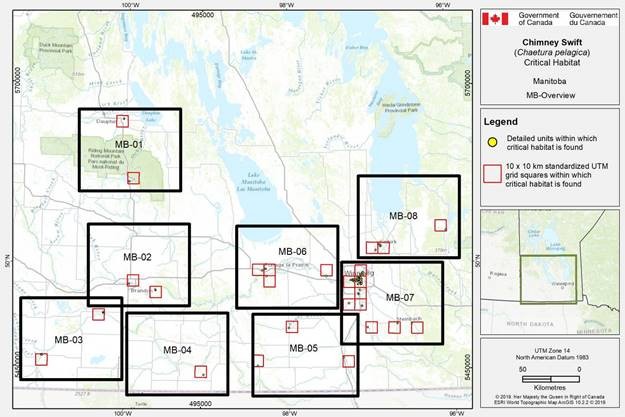
Figure D-1. Overview of Figures D-1.1 to D-1.8 (maps MB-01 to MB-08) representing the critical habitat for the Chimney Swift in Manitoba. The critical habitat units are indicated by a yellow dot within he red 10 x 10 km squares, where the criteria and methods for identifying critical habitat set out in section 7.1 are applied. The 10 x 10 km squares in the standardized UTM grid system of Canada indicate the general geographic location of the critical habitat.
The map shows an overview of critical habitat for the Chimney Swift in Manitoba. Numerous 10 x 10 UTM grid squares cover critical habitat across central-south Manitoba, subdivided into 8 maps that are more detailed.
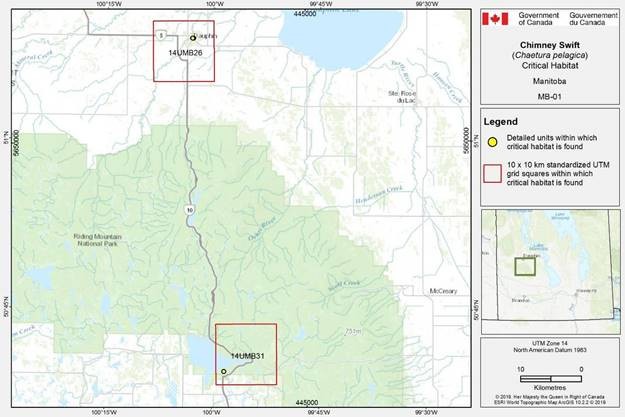
Figure D-1.1. Critical habitat for the Chimney Swift in Manitoba. The critical habitat units are indicated by a yellow dot within he red 10 x 10 km squares, where the criteria and methods for identifying critical habitat set out in section 7.1 are applied. The 10 x 10 km squares in the standardized UTM grid system of Canada indicate the general geographic location of the critical habitat.
The map contains two polygons within two 10 x 10 km standardized UTM grid squares. The first polygon is found within a 10 x 10 km standardized UTM grid square, located east of Highway 5 and Highway 10 at the top of the map. The other polygon is located along highway 10 within a large body of water at the bottom of the map.
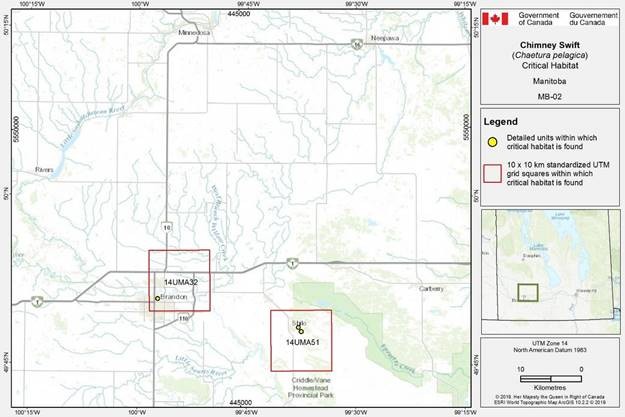
Figure D-1.2. Critical habitat for the Chimney Swift in Manitoba. The critical habitat units are indicated by a yellow dot within the red 10 × 10 km squares. where the criteria and method for identifying critical habitat set out in section 7.1 are applied. The 10 × 10 km squares in the standardized UTM grid system of Canada indicate the general geographic location of the critical habitat.
The map contains three polygons within two 10 x 10 km standardized UTM grid squares. The first polygon is found within a 10 x 10 km UTM grid square, located between Highway 5, Highway 10 and Highway 110. The other two polygons are located north of Criddle/Vane Homestead Provincial Park and south of Highway 1, in a single grid square.
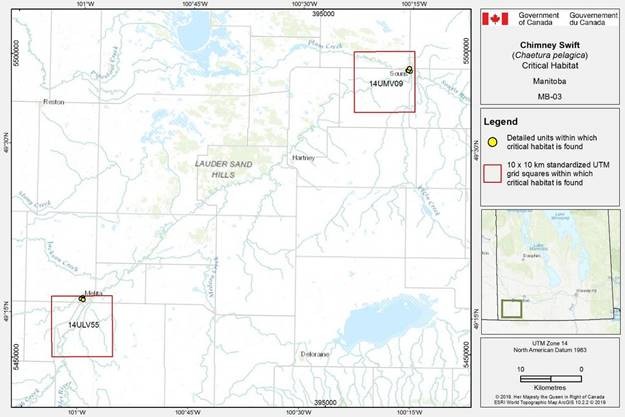
Figure D-1.3. Critical habitat for the Chimney Swift in Manitoba. The critical habitat units are indicated by a yellow dot within the red 10 × 10 km squares. where the criteria and method for identifying critical habitat set out in section 7.1 are applied. The 10 × 10 km squares in the standardized UTM grid system of Canada indicate the general geographic location of the critical habitat.
The map contains six polygons and two 10 x 10 km standardized UTM grid squares. Three polygons are clustered in a grid square located below Melita, Manitoba. The remaining three polygons are clustered in a grid square around Souris, Manitoba.
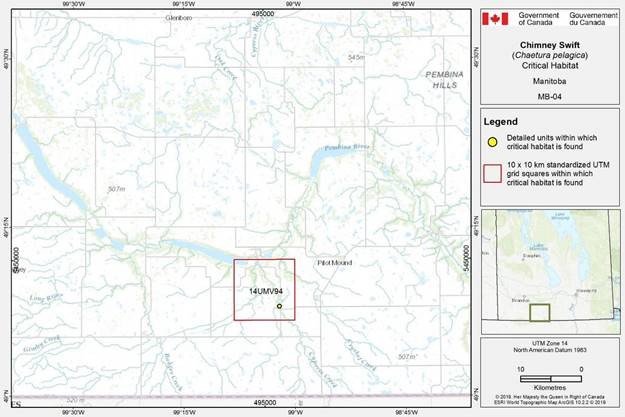
Figure D-1.4. Critical habitat for the Chimney Swift in Manitoba. The critical habitat units are indicated by a yellow dot within the red 10 × 10 km squares. where the criteria and method for identifying critical habitat set out in section 7.1 are applied. The 10 × 10 km squares in the standardized UTM grid system of Canada indicate the general geographic location of the critical habitat.
The map contains a single polygon in a 10 x 10 km standardized UTM grid squares. The polygon is located west of Pilot Mound, Manitoba and south of the Pembina River.
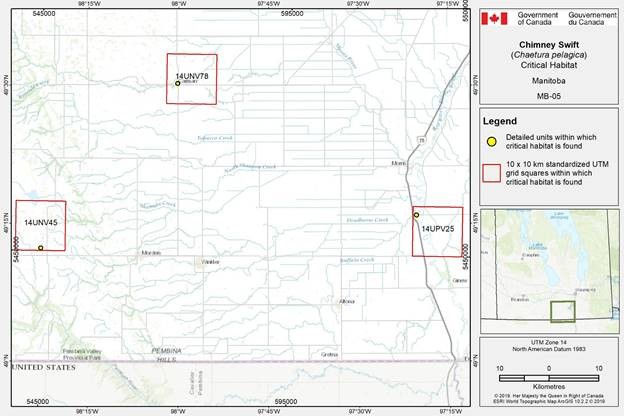
Figure D-1.5. Critical habitat for the Chimney Swift in Manitoba. The critical habitat units are indicated by a yellow dot within the red 10 × 10 km squares. where the criteria and method for identifying critical habitat set out in section 7.1 are applied. The 10 × 10 km squares in the standardized UTM grid system of Canada indicate the general geographic location of the critical habitat.
The map contains three polygons, each in a 10 x 10 km standardized UTM grid square. The first polygon is located west of Morden, Manitoba. The second polygon is located east of Deadhorse Creek and Highway 75. The third polygon is located in Carman, Manitoba.
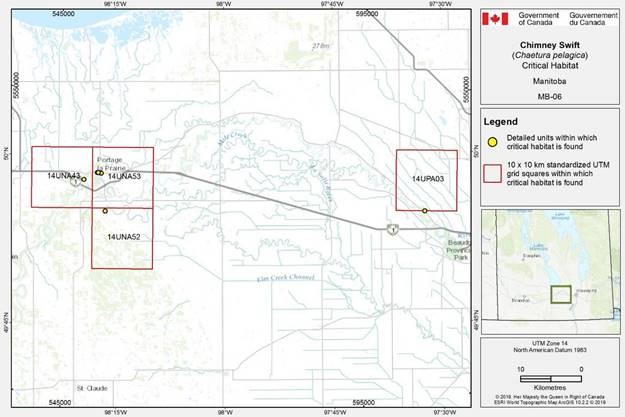
Figure D-1.6. Critical habitat for the Chimney Swift in Manitoba. The critical habitat units are indicated by a yellow dot within the red 10 × 10 km squares. where the criteria and method for identifying critical habitat set out in section 7.1 are applied. The 10 × 10 km squares in the standardized UTM grid system of Canada indicate the general geographic location of the critical habitat.
The map contains around five polygons and four 10 x 10 km standardized UTM grid squares. The lone polygon and grid square are located north of Beaudry Provincial Park and Highway 1. The remaining polygons and three grid squares are clustered around Portage la Prairie and Highway 1.
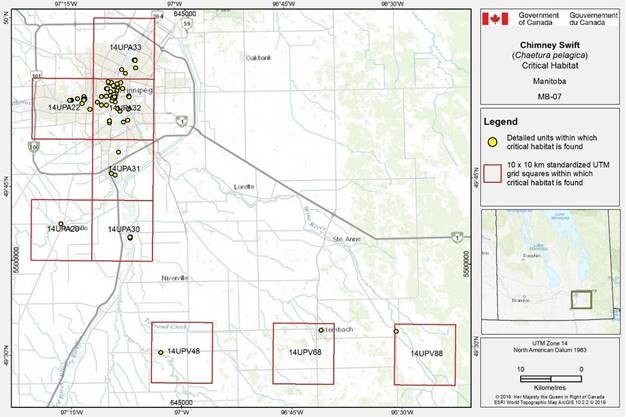
Figure D-1.7. Critical habitat for the Chimney Swift in Manitoba. The critical habitat units are indicated by a yellow dot within the red 10 × 10 km squares. where the criteria and method for identifying critical habitat set out in section 7.1 are applied. The 10 × 10 km squares in the standardized UTM grid system of Canada indicate the general geographic location of the critical habitat.
The map contains many polygons spread across nine 10 x 10 km standardized UTM grid squares. The majority of the polygons are in six grid squares that are clustered northwest of Niverville, Manitoba and around Winnipeg, Manitoba. The remaining three grid squares are spread evenly across the bottom of the map and contain one polygon each.
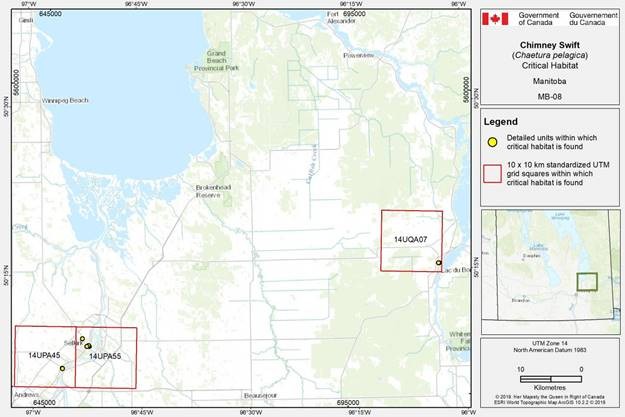
Figure D-1.8. Critical habitat for the Chimney Swift in Manitoba. The critical habitat units are indicated by a yellow dot within the red 10 × 10 km squares. where the criteria and method for identifying critical habitat set out in section 7.1 are applied. The 10 × 10 km squares in the standardized UTM grid system of Canada indicate the general geographic location of the critical habitat.
The map contains around 5 polygons and three 10 x 10 km standardized UTM grid squares. One polygon and grid square is located on the center right side of the map. The remaining polygons and grid squares are clustered above Andrews, Manitoba at the bottom left of the map.
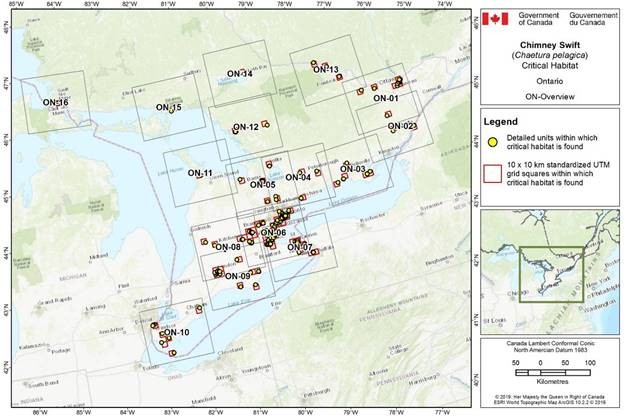
Figure D-2. Overview of Figures D-2.1 to D-2.16 (maps ON-01 to ON-16) representing the critical habitat for the Chimney Swift in Ontario. The critical habitat units are indicated by a yellow dot within the red 10 × 10 km squares. where the criteria and method for identifying critical habitat set out in section 7.1 are applied. The 10 × 10 km squares in the standardized UTM grid system of Canada indicate the general geographic location of the critical habitat.
The map shows an overview of critical habitat for the Chimney Swift in Ontario. Numerous 10 x 10 UTM grid squares cover critical habitat across southern Ontario, subdivided into 16 maps that are more detailed.
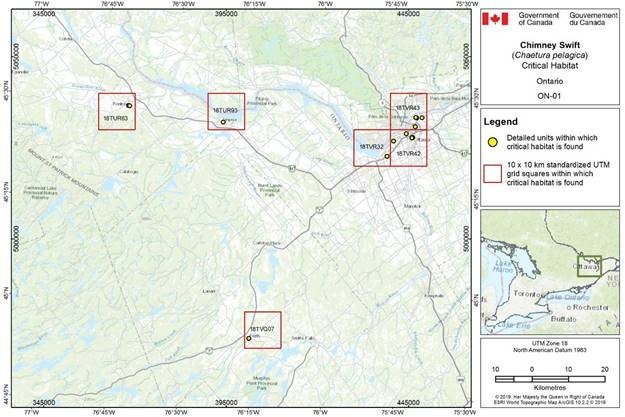
Figure D-2.1. Critical habitat for the Chimney Swift in Ontario. The critical habitat units are indicated by a yellow dot within the red 10 × 10 km squares. where the criteria and method for identifying critical habitat set out in section 7.1 are applied. The 10 × 10 km squares in the standardized UTM grid system of Canada indicate the general geographic location of the critical habitat.
The map contains a few polygons within six 10 x 10 km standardized UTM grid squares. One polygon and grid square is located in Perth, Ontario. Another lone polygon and grid square are located in Arnprior, Ontario. The last lone grid square containing 1-2 polygons is located in Renfrew, Ontario. The remaining 7-9 polygons and grid squares are clustered around Ottawa, Ontario, south of the Ottawa River.
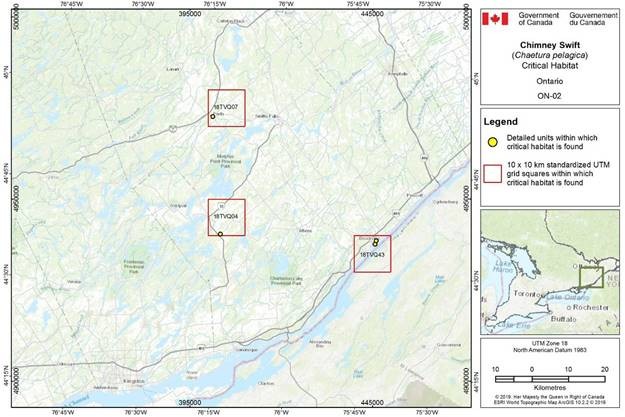
Figure D-2.2. Critical habitat for the Chimney Swift in Ontario. The critical habitat units are indicated by a yellow dot within the red 10 × 10 km squares. where the criteria and method for identifying critical habitat set out in section 7.1 are applied. The 10 × 10 km squares in the standardized UTM grid system of Canada indicate the general geographic location of the critical habitat.
The map contains four polygons within three 10 x 10 km standardized UTM grid squares. One polygon and grid square is located in Perth, Ontario. Another lone polygon and grid square are located next to Highway 15 in the center of the map. The last lone grid square containing two polygons is located in Brockville, Ontario south of the 401.
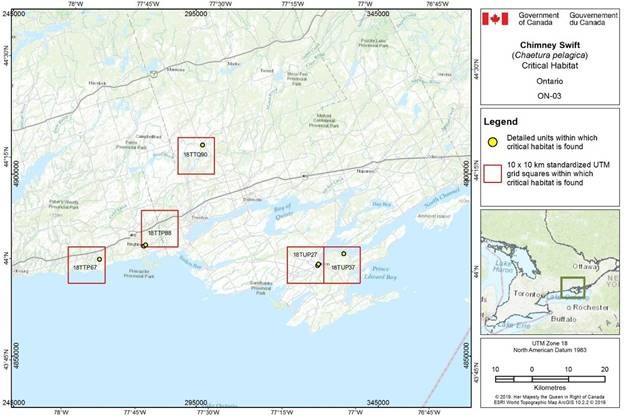
Figure D-2.3. Critical habitat for the Chimney Swift in Ontario. The critical habitat units are indicated by a yellow dot within the red 10 × 10 km squares. where the criteria and method for identifying critical habitat set out in section 7.1 are applied. The 10 × 10 km squares in the standardized UTM grid system of Canada indicate the general geographic location of the critical habitat.
The map contains seven polygons within five 10 x 10 km standardized UTM grid squares. One polygon and grid square is located south of Highway 401 and west of Presqu'ile Provincial Park, Ontario. The next two polygons are found in a grid square located in Brighton, Ontario and south of Highway 401. The next lone polygon and grid square are located north of Trenton, Ontario and east of Campbellford, Ontario. The remaining three polygons and two grid squares are clustered between Sandbanks Provincial Park and Prince Edward Bay.
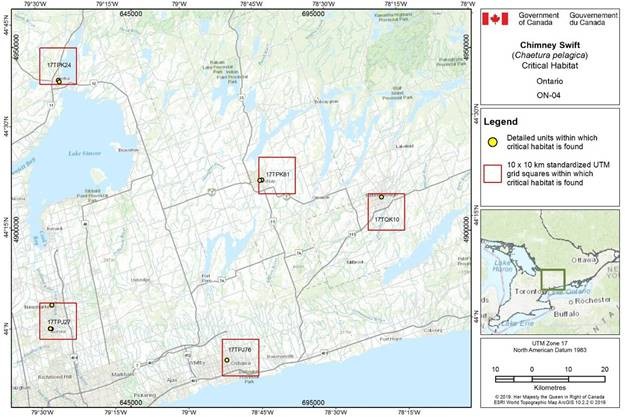
Figure D-2.4. Critical habitat for the Chimney Swift in Ontario. The critical habitat units are indicated by a yellow dot within the red 10 × 10 km squares. where the criteria and method for identifying critical habitat set out in section 7.1 are applied. The 10 × 10 km squares in the standardized UTM grid system of Canada indicate the general geographic location of the critical habitat.
The map contains eight polygons within five 10 x 10 km standardized UTM grid squares. The first two polygons are found within a single grid square, one in Newmarket, Ontario and the other in Aurora, Ontario. The next two polygons are located in a single grid square found in Orillia, Ontario. The next grid square contains two polygons that are found within Lyndsay, Ontario. The next lone polygon and grid square are found in Peterborough, Ontario. The final lone polygon and grid square are found in Oshawa, Ontario.
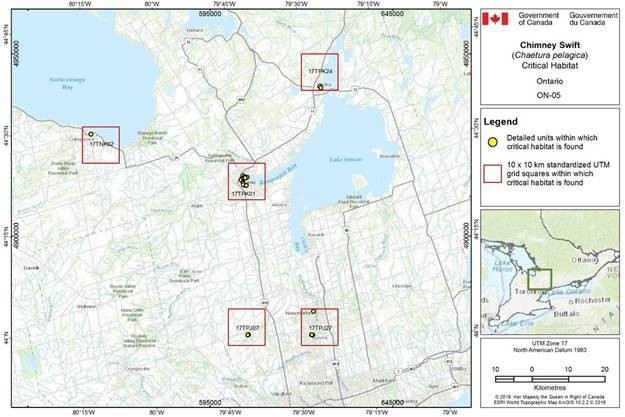
Figure D-2.5. Critical habitat for the Chimney Swift in Ontario. The critical habitat units are indicated by a yellow dot within the red 10 × 10 km squares. where the criteria and method for identifying critical habitat set out in section 7.1 are applied. The 10 × 10 km squares in the standardized UTM grid system of Canada indicate the general geographic location of the critical habitat.
The map contains numerous polygons within five 10 x 10 km standardized UTM grid squares. The first lone polygon and grid square can be found in Collingwood, Ontario. The next two polygons are located in a single grid square found in Orillia, Ontario. The next two polygons are found within a single grid square, one in Newmarket, Ontario and the other in Aurora, Ontario. The next lone polygon and grid square are found north of Bolton, Ontario and west of Newmarket, Ontario. A large cluster of polygons are found in Barrie, Ontario and next to Kempenfelt Bay.
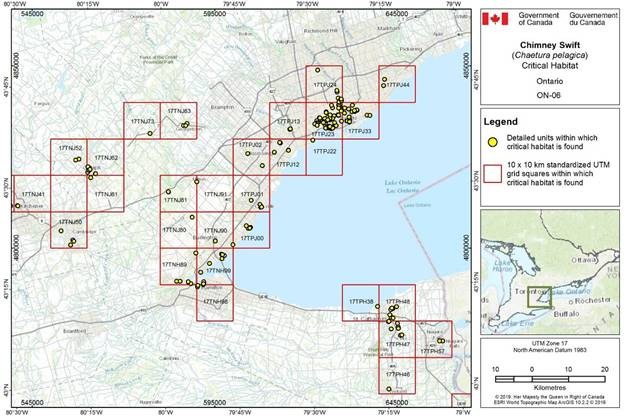
Figure D-2.6. Critical habitat for the Chimney Swift in Ontario. The critical habitat units are indicated by a yellow dot within the red 10 × 10 km squares. where the criteria and method for identifying critical habitat set out in section 7.1 are applied. The 10 × 10 km squares in the standardized UTM grid system of Canada indicate the general geographic location of the critical habitat.
The map contains numerous polygons spread among 30 10 x 10 km standardized UTM grid squares. The first group of polygons are found within eight clustered grid squares spanning from Cambridge, Kitchener through Guelph to Georgetown, Ontario. The next set of polygons within 17 clustered grid squares run along Lake Ontario, from Hamilton, through Burlington, Mississauga to west of Pickering, Ontario. The next set of polygons within five clustered grid squares run from St. Catherines to Welland, Ontario.
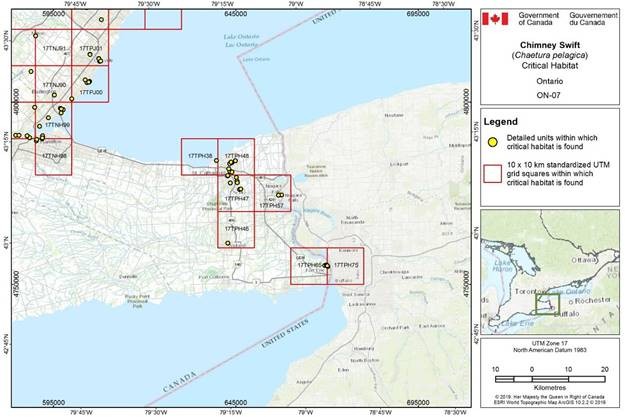
Figure D-2.7. Critical habitat for the Chimney Swift in Ontario. The critical habitat units are indicated by a yellow dot within the red 10 × 10 km squares. where the criteria and method for identifying critical habitat set out in section 7.1 are applied. The 10 × 10 km squares in the standardized UTM grid system of Canada indicate the general geographic location of the critical habitat.
The map contains numerous polygons spread among 17 10 x 10 km standardized UTM grid squares. The set of polygons within 10 clustered grid squares run along Lake Ontario, from Hamilton, Ontario to north of Oakville, Ontario. The next set of polygons within five clustered grid squares run from St. Catherines to Welland, Ontario. The remaining polygons are found within two clustered grid squares between Fort Erie, Ontario and the United States border.
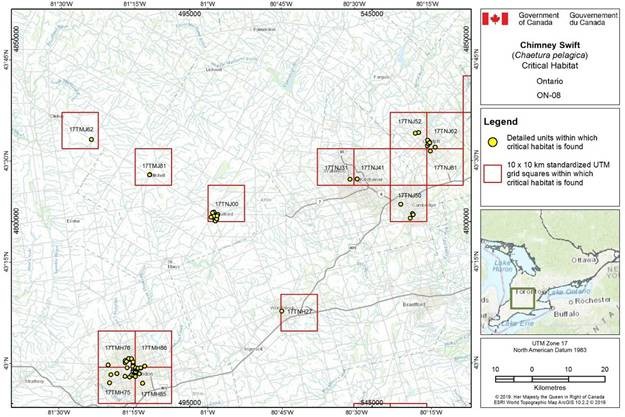
Figure D-2.8. Critical habitat for the Chimney Swift in Ontario. The critical habitat units are indicated by a yellow dot within the red 10 × 10 km squares. where the criteria and method for identifying critical habitat set out in section 7.1 are applied. The 10 × 10 km squares in the standardized UTM grid system of Canada indicate the general geographic location of the critical habitat.
The map contains numerous polygons spread among 15 10 x 10 km standardized UTM grid squares. The first group of polygons are found within seven clustered grid squares spanning from Cambridge to Kitchener and Guelph, Ontario. The next set of polygons are found within four grid squares clustered around London, Ontario. The next lone polygon and grid square is found southeast of Clinton, Ontario. The next lone polygon and grid square is found in Mitchell, Ontario. The next set of polygons are located within a grid square found in Stratford, Ontario. The final lone polygon and grid square are found within Woodstock, Ontario.
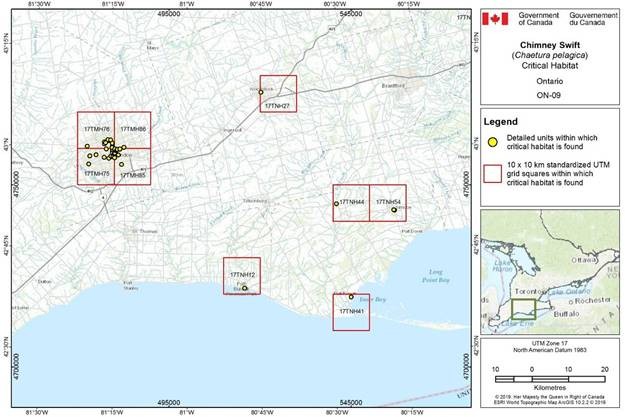
Figure D-2.9. Critical habitat for the Chimney Swift in Ontario. The critical habitat units are indicated by a yellow dot within the red 10 × 10 km squares. where the criteria and method for identifying critical habitat set out in section 7.1 are applied. The 10 × 10 km squares in the standardized UTM grid system of Canada indicate the general geographic location of the critical habitat.
The map contains numerous polygons spread among nine 10 x 10 km standardized UTM grid squares. Two polygons and two grid squares encompass Simcoe, Ontario and slightly west. The next set of polygons are found within four grid squares clustered around London, Ontario. A lone polygon and grid square are found at Point Rowan, Ontario. The next lone polygon and grid square are found at Port Burwell, Ontario. The final lone polygon and grid square are found within Woodstock, Ontario.
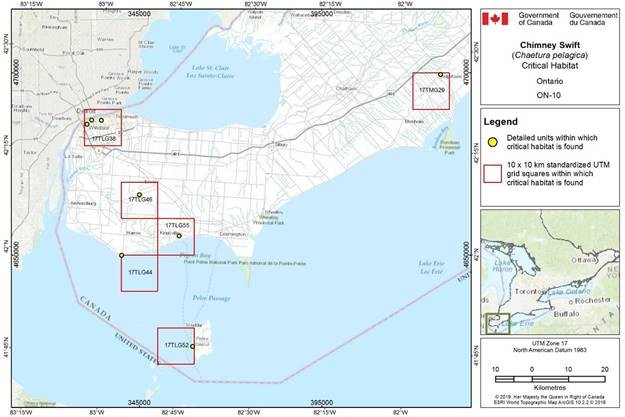
Figure D-2.10. Critical habitat for the Chimney Swift in Ontario. The critical habitat units are indicated by a yellow dot within the red 10 × 10 km squares. where the criteria and method for identifying critical habitat set out in section 7.1 are applied. The 10 × 10 km squares in the standardized UTM grid system of Canada indicate the general geographic location of the critical habitat.
The map contains eight polygons spread among six 10 x 10 km standardized UTM grid squares. Three polygons are found in a grid square in Windsor, Ontario. The first lone pair is found in a grid square north of Harrow, Ontario. The next lone polygon and grid square are found south of Harrow, Ontario. The next lone polygon and grid square is found in Kingsville, Ontario. The final lone polygon and grid square is found on Pelee Island, Ontario.
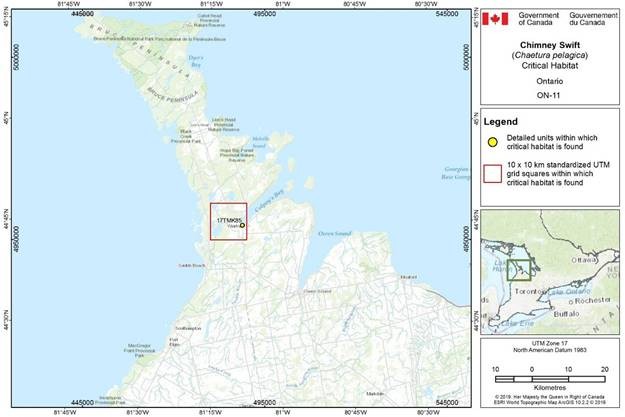
Figure D-2.11. Critical habitat for the Chimney Swift in Ontario. The map contains a single polygon in a single 10 x 10 km standardized UTM grid square located in Wiarton, Ontario.
The map contains a single polygon in a single 10 x 10 km standardized UTM grid square located in Wiarton, Ontario.
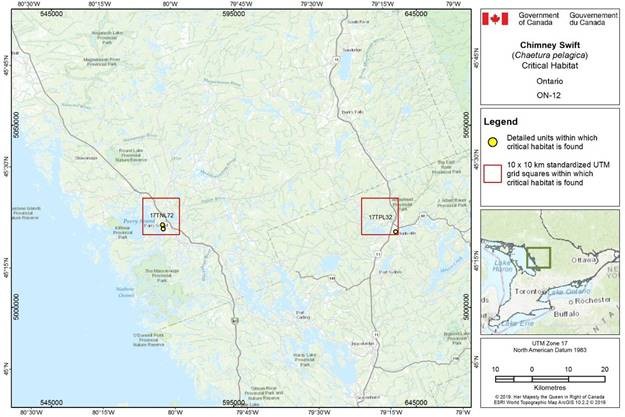
Figure D-2.12. Critical habitat for the Chimney Swift in Ontario. The critical habitat units are indicated by a yellow dot within the red 10 × 10 km squares. where the criteria and method for identifying critical habitat set out in section 7.1 are applied. The 10 × 10 km squares in the standardized UTM grid system of Canada indicate the general geographic location of the critical habitat.
The map contains three polygons spread among two 10 x 10 km standardized UTM grid squares. Two polygons are within a grid square located in Parry Sound, Ontario. The remaining polygon and grid square are located in Huntsville, Ontario.
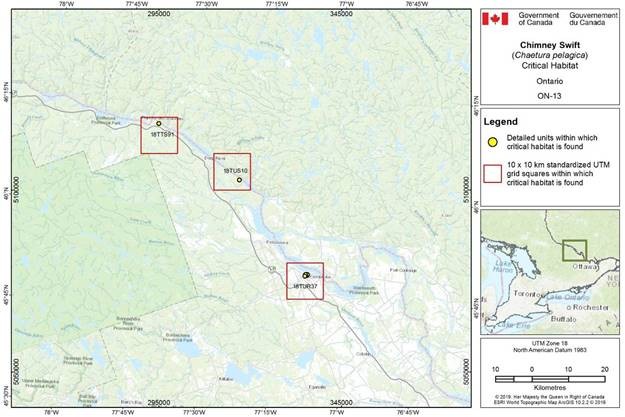
Figure D-2.13. Critical habitat for the Chimney Swift in Ontario. The critical habitat units are indicated by a yellow dot within the red 10 × 10 km squares. where the criteria and method for identifying critical habitat set out in section 7.1 are applied. The 10 × 10 km squares in the standardized UTM grid system of Canada indicate the general geographic location of the critical habitat.
The map contains several polygons spread among three 10 x 10 km standardized UTM grid squares. There is a cluster of polygons within a single grid square found in Pembroke, Ontario. The next lone polygon and grid square are found southeast of Deep River, Ontario. The remaining lone polygon and grid square is found south of Rapides-des-Joachims, Quebec.
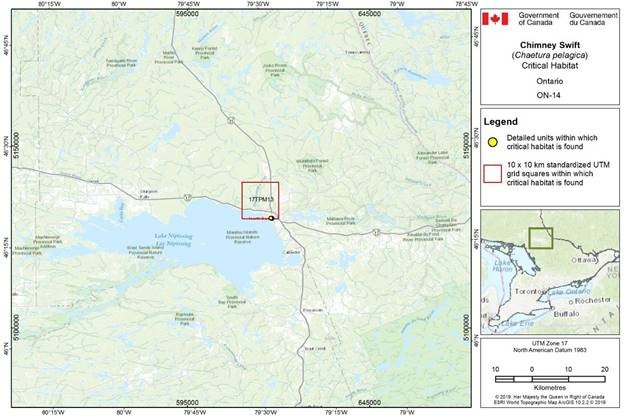
Figure D-2.14. Critical habitat for the Chimney Swift in Ontario. The critical habitat units are indicated by a yellow dot within the red 10 × 10 km squares. where the criteria and method for identifying critical habitat set out in section 7.1 are applied. The 10 × 10 km squares in the standardized UTM grid system of Canada indicate the general geographic location of the critical habitat.
The map contains a single polygon in a single 10 x 10 km standardized UTM grid square located in North Bay, Ontario.
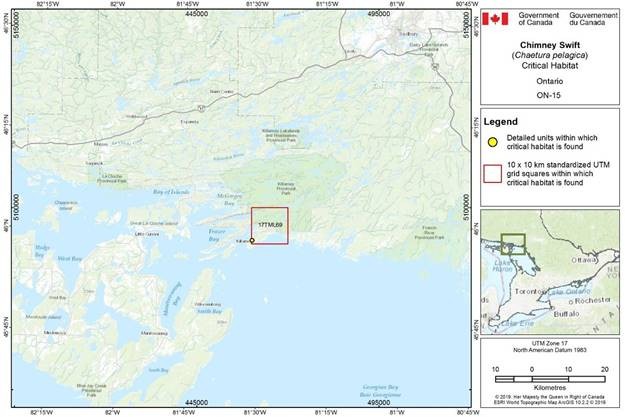
Figure D-2.15. Critical habitat for the Chimney Swift in Ontario. The critical habitat units are indicated by a yellow dot within the red 10 × 10 km squares. where the criteria and method for identifying critical habitat set out in section 7.1 are applied. The 10 × 10 km squares in the standardized UTM grid system of Canada indicate the general geographic location of the critical habitat.
The map contains a single polygon in a single 10 x 10 km standardized UTM grid square located in Killarney, Ontario.
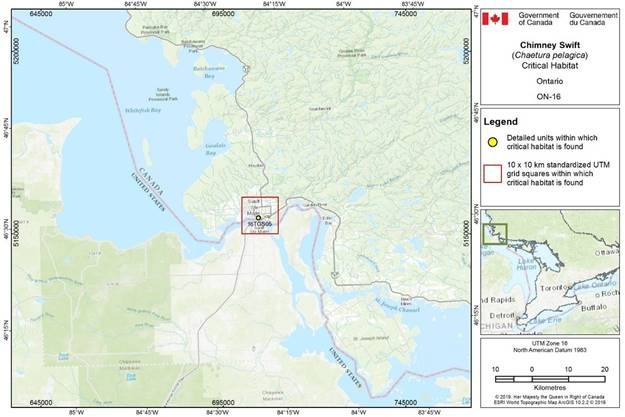
Figure D-2.16. Critical habitat for the Chimney Swift in Ontario. The critical habitat units are indicated by a yellow dot within the red 10 × 10 km squares. where the criteria and method for identifying critical habitat set out in section 7.1 are applied. The 10 × 10 km squares in the standardized UTM grid system of Canada indicate the general geographic location of the critical habitat.
The map contains a single polygon in a single 10 x 10 km standardized UTM grid square located in Sault Ste Marie, Ontario.
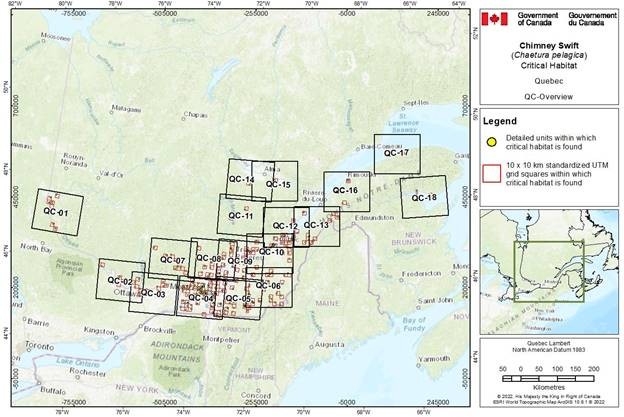
Figure D-3. Overview of Figures D-3.1 to D-3.18 (maps QC-01 to QC-18) representing the critical habitat for the Chimney Swift in Quebec. The critical habitat units are indicated by a yellow dot within the red 10 × 10 km squares. where the criteria and method for identifying critical habitat set out in section 7.1 are applied. The 10 × 10 km squares in the standardized UTM grid system of Canada indicate the general geographic location of the critical habitat.
The map shows an overview of critical habitat for the Chimney Swift in Quebec. Numerous 10 x 10 UTM grid squares cover critical habitat across Quebec, subdivided into 18 maps that are more detailed.
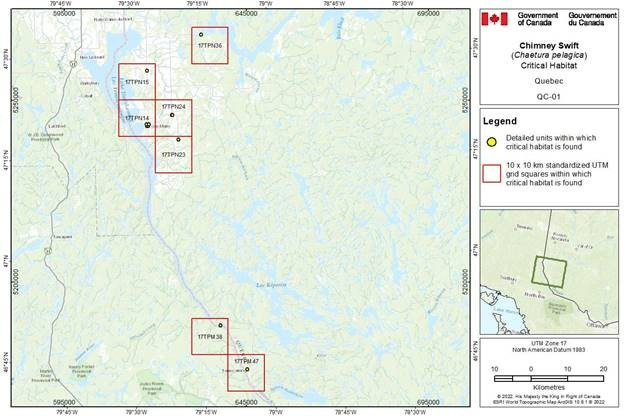
Figure D-3.1. Critical habitat for the Chimney Swift in Quebec. The critical habitat units are indicated by a yellow dot within the red 10 × 10 km squares. where the criteria and method for identifying critical habitat set out in section 7.1 are applied. The 10 × 10 km squares in the standardized UTM grid system of Canada indicate the general geographic location of the critical habitat.
The map contains multiple polygons within seven 10 x 10 km standardized UTM grid squares. Two grid squares containing one polygon each are found diagonally of each other along the Quebec and Ontario border, near Temiscaming, Quebec. A lone polygon and grid square are located northwest of Rivière Fraser. The remaining polygons and four grid squares are clustered around Lake Timiskaming.
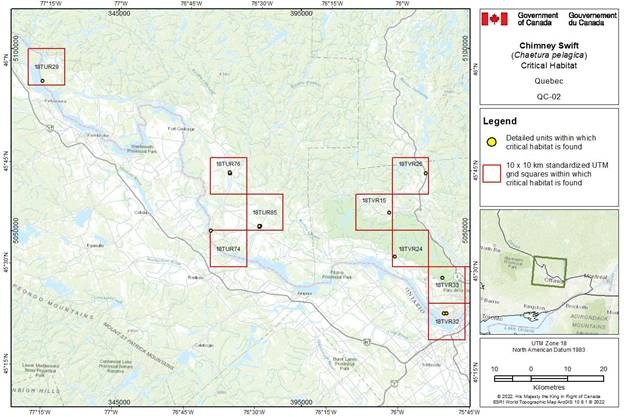
Figure D-3.2. Critical habitat for the Chimney Swift in Quebec. The critical habitat units are indicated by a yellow dot within the red 10 × 10 km squares. where the criteria and method for identifying critical habitat set out in section 7.1 are applied. The 10 × 10 km squares in the standardized UTM grid system of Canada indicate the general geographic location of the critical habitat.
The map contains multiple polygons within nine 10 x 10 km standardized UTM grid squares. Three grid squares containing at least one polygon each are found clustered to the north of and between Renfrew, Ontario and Amprior, Ontario. A lone polygon and grid square are located north of Petawawa, Ontario. The remaining polygons and five grid squares are clustered east of Fitzroy Provincial Park.
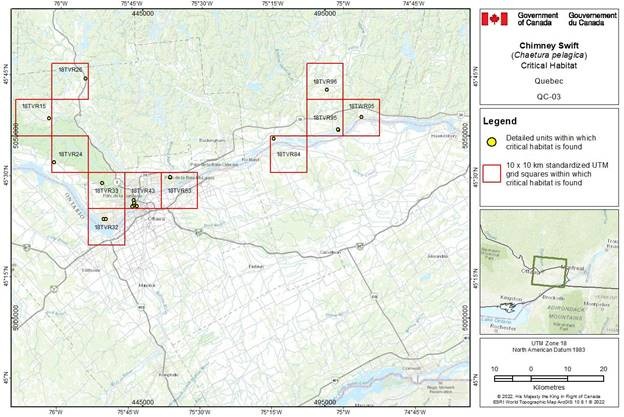
Figure D-3.3. Critical habitat for the Chimney Swift in Quebec. The critical habitat units are indicated by a yellow dot within the red 10 × 10 km squares. where the criteria and method for identifying critical habitat set out in section 7.1 are applied. The 10 × 10 km squares in the standardized UTM grid system of Canada indicate the general geographic location of the critical habitat.
The map contains multiple polygons within eleven 10 x 10 km standardized UTM grid squares. Four grid squares containing at least one polygon each are found clustered to the north of the Ottawa River and east of Rockland, Ontario. The remaining polygons and seven grid squares are clustered north of the Ottawa River and west of Parc de la Baie-McLaurin.
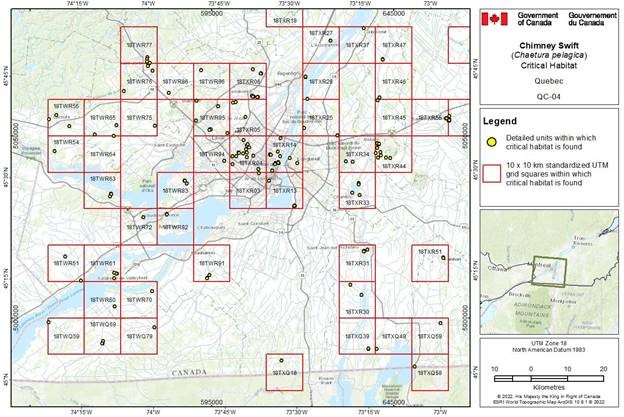
Figure D-3.4. Critical habitat for the Chimney Swift in Quebec. The critical habitat units are indicated by a yellow dot within the red 10 × 10 km squares. where the criteria and method for identifying critical habitat set out in section 7.1 are applied. The 10 × 10 km squares in the standardized UTM grid system of Canada indicate the general geographic location of the critical habitat.
The map contains multiple polygons within 49 10 x 10 km standardized UTM grid squares. All the grids and polygons are clustered across the entire map. The map runs from Voyageur Provincial Park to Saint Hyacinth, Quebec and from Rouses Point, New York USA to Contrecoeur, Quebec.
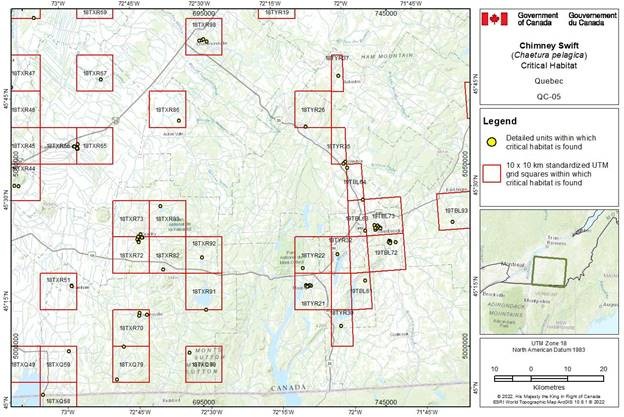
Figure D-3.5. Critical habitat for the Chimney Swift in Quebec. The critical habitat units are indicated by a yellow dot within the red 10 × 10 km squares. where the criteria and method for identifying critical habitat set out in section 7.1 are applied. The 10 × 10 km squares in the standardized UTM grid system of Canada indicate the general geographic location of the critical habitat.
The map contains 33 10 x 10 km standardized UTM grid squares that encompass multiple polygons. All the grids and polygons are spread in clusters across the entire map. The map runs from Richford, New York USA to Drummondville, Quebec and from Saint Hyacinth, Quebec to East Angus, Quebec.
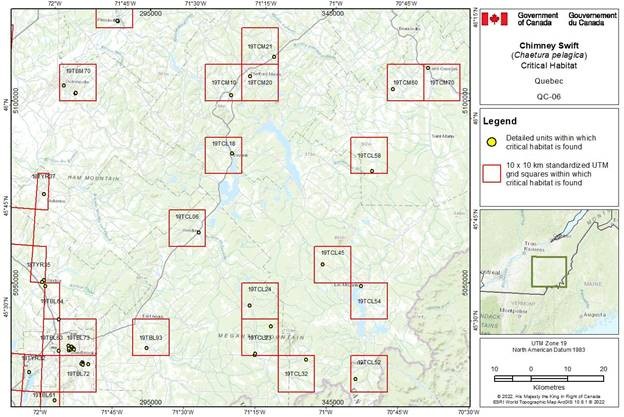
Figure D-3.6. Critical habitat for the Chimney Swift in Quebec. The critical habitat units are indicated by a yellow dot within the red 10 × 10 km squares. where the criteria and method for identifying critical habitat set out in section 7.1 are applied. The 10 × 10 km squares in the standardized UTM grid system of Canada indicate the general geographic location of the critical habitat.
The map contains 29 10 x 10 km standardized UTM grid squares that encompass multiple polygons. All the grids and polygons are spread in clusters across the entire map. The map runs from the Quebec and New York border to Plessisville, Quebec and from slightly west of Windsor, Quebec to Saint-Georges, Quebec.
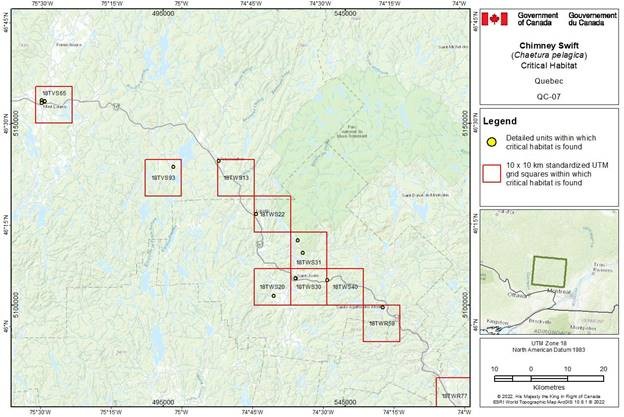
Figure D-3.7. Critical habitat for the Chimney Swift in Quebec. The critical habitat units are indicated by a yellow dot within the red 10 × 10 km squares. where the criteria and method for identifying critical habitat set out in section 7.1 are applied. The 10 × 10 km squares in the standardized UTM grid system of Canada indicate the general geographic location of the critical habitat.
The map contains ten 10 x 10 km standardized UTM grid squares that encompass multiple polygons. All the grids and polygons run along Highway 117, which runs diagonally from the bottom right corner of the map. The map runs from Mont-Laurier, Quebec to east of Saint-Donat-de-Montcalm, Quebec.
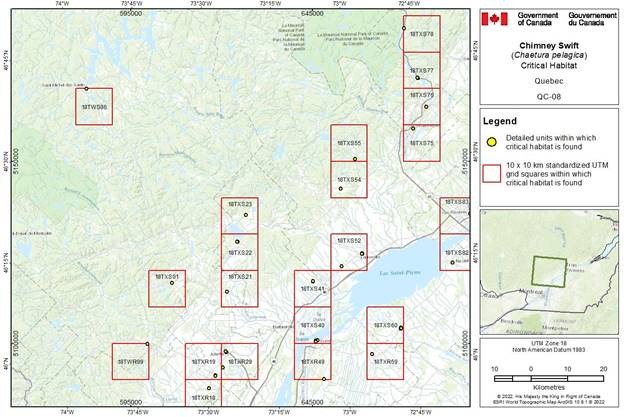
Figure D-3.8. Critical habitat for the Chimney Swift in Quebec. The critical habitat units are indicated by a yellow dot within the red 10 × 10 km squares. where the criteria and method for identifying critical habitat set out in section 7.1 are applied. The 10 × 10 km squares in the standardized UTM grid system of Canada indicate the general geographic location of the critical habitat.
The map contains 23 10 x 10 km standardized UTM grid squares that encompass multiple polygons. A lone polygon and grid square can be found at Saint-Michel-des-Saints, Quebec. The remaining grids and polygons cluster and run east of Saint-Donat-de-Montcalm, Quebec, south and east of La Maurice National Park of Canada and the surrounding area of Lac Saint-Pierre.
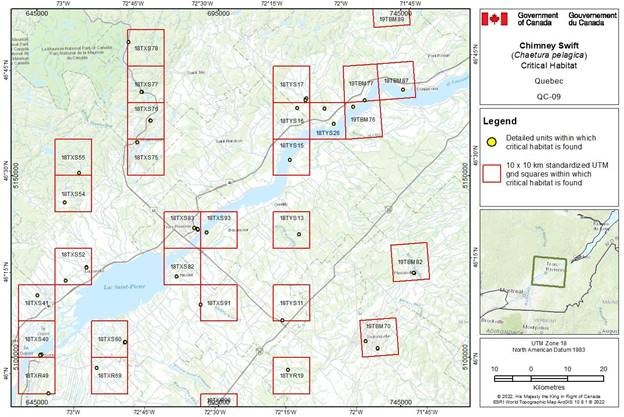
Figure D-3.9. Critical habitat for the Chimney Swift in Quebec. The critical habitat units are indicated by a yellow dot within the red 10 × 10 km squares. where the criteria and method for identifying critical habitat set out in section 7.1 are applied. The 10 × 10 km squares in the standardized UTM grid system of Canada indicate the general geographic location of the critical habitat.
The map contains 28 10 x 10 km standardized UTM grid squares that encompass multiple polygons. All the grids and polygons are spread in clusters across the entire map. The map runs from La Maurice National Park of Canada in the north- west to Pont Rouge in the east and continues south of Victoriaville, Quebec.
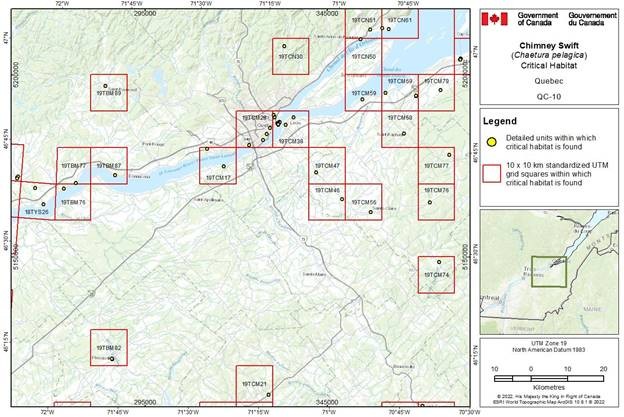
Figure D-3.10. Critical habitat for the Chimney Swift in Quebec. The critical habitat units are indicated by a yellow dot within the red 10 × 10 km squares. where the criteria and method for identifying critical habitat set out in section 7.1 are applied. The 10 × 10 km squares in the standardized UTM grid system of Canada indicate the general geographic location of the critical habitat.
There are multiple polygons of critical habitat located within twenty-six 10 x 10 km UTM grid squares. There are many polygons in the area surrounding the Chenal de l’Île d’Orléans and along the St. Lawrence River.
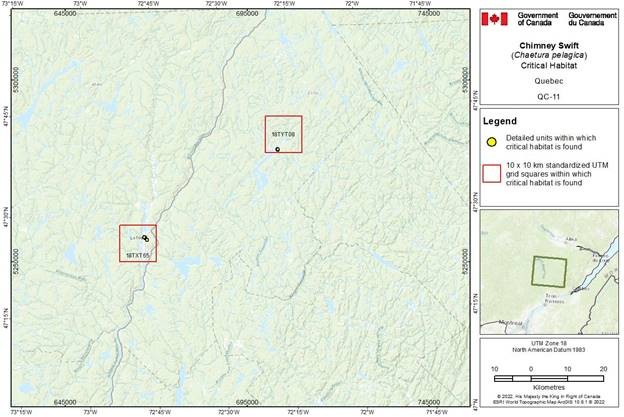
Figure D-3.11. Critical habitat for the Chimney Swift in Quebec. The critical habitat units are indicated by a yellow dot within the red 10 × 10 km squares. where the criteria and method for identifying critical habitat set out in section 7.1 are applied. The 10 × 10 km squares in the standardized UTM grid system of Canada indicate the general geographic location of the critical habitat.
There are three polygons of critical habitat located within two 10 x 10 km UTM grid squares. Two polygons are located near La Tuque, and the other is found northeast of La Tuque in its own grid square.
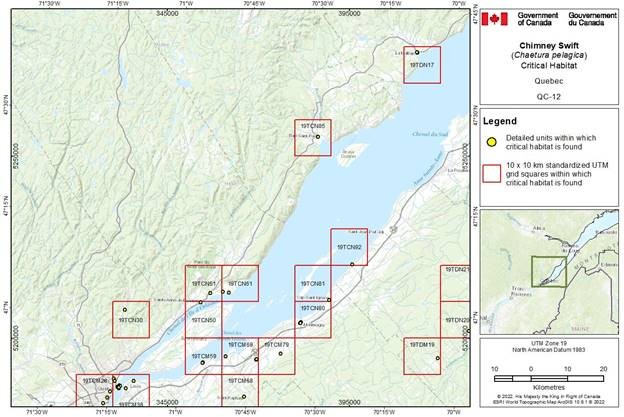
Figure D-3.12. Critical habitat for the Chimney Swift in Quebec. The critical habitat units are indicated by a yellow dot within the red 10 × 10 km squares. where the criteria and method for identifying critical habitat set out in section 7.1 are applied. The 10 × 10 km squares in the standardized UTM grid system of Canada indicate the general geographic location of the critical habitat.
There are multiple polygons of critical habitat located within eighteen 10 x 10 km UTM grid squares. Clusters of polygons are located along the Chenal de l’Île d’Orléans from Quebec City and Levis toward Saint-Jean-Port-Joli. North of the cluster is one polygon near Baie-Saint-Paul and further northeast of that is another polygon near La Malbaie. There are another two polygons located in two grid squares in the southeast corner of the map.
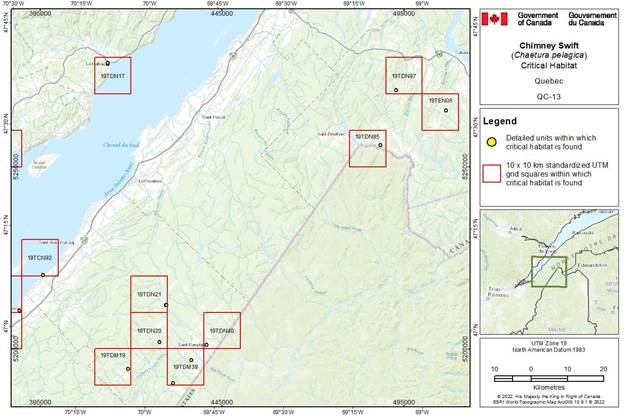
Figure D-3.13. Critical habitat for the Chimney Swift in Quebec. The critical habitat units are indicated by a yellow dot within the red 10 × 10 km squares. where the criteria and method for identifying critical habitat set out in section 7.1 are applied. The 10 × 10 km squares in the standardized UTM grid system of Canada indicate the general geographic location of the critical habitat.
There are thirteen polygons of critical habitat located within eleven 10 x 10 km UTM grid squares. Six polygons are located near Saint-Pamphile in the southwestern region of the map. Northwest of the cluster are two polygons located south of Saint-Jean-Port-Joli. Further north, in La Malbaie, there are two more polygons. East of the previous polygons are three more polygons located between Cabano and Saint-Éleuthère.
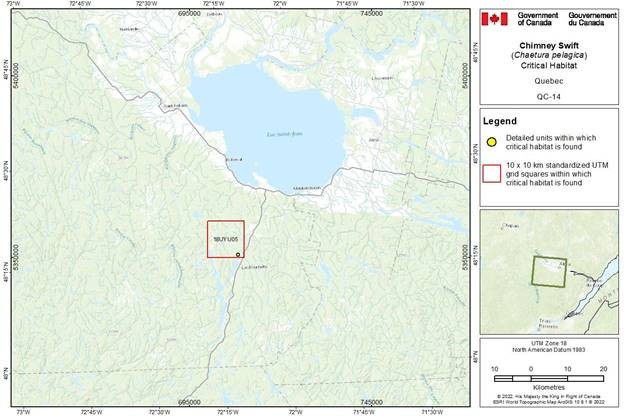
Figure D-3.14. Critical habitat for the Chimney Swift in Quebec. The critical habitat units are indicated by a yellow dot within the red 10 × 10 km squares. where the criteria and method for identifying critical habitat set out in section 7.1 are applied. The 10 × 10 km squares in the standardized UTM grid system of Canada indicate the general geographic location of the critical habitat.
There is one polygon of critical habitat located within one 10 x 10 km UTM grid square. The polygon is located south of Lac Saint-Jean and north of Lac-Bouchette.
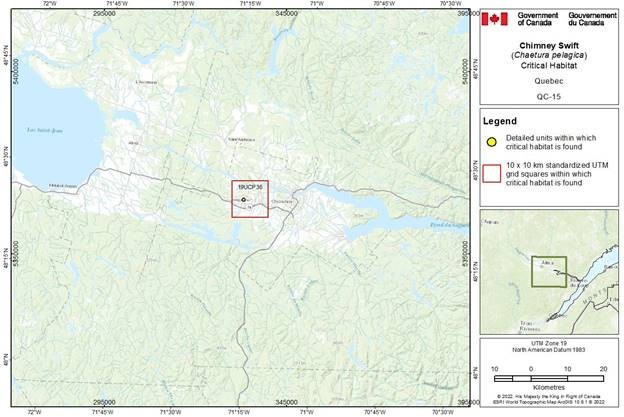
Figure D-3.15. Critical habitat for the Chimney Swift in Quebec. The critical habitat units are indicated by a yellow dot within the red 10 × 10 km squares. where the criteria and method for identifying critical habitat set out in section 7.1 are applied. The 10 × 10 km squares in the standardized UTM grid system of Canada indicate the general geographic location of the critical habitat.
There is one polygon of critical habitat located within one 10 x 10 km UTM grid square. The polygon is located south of Saint Ambroise in Jonquière.
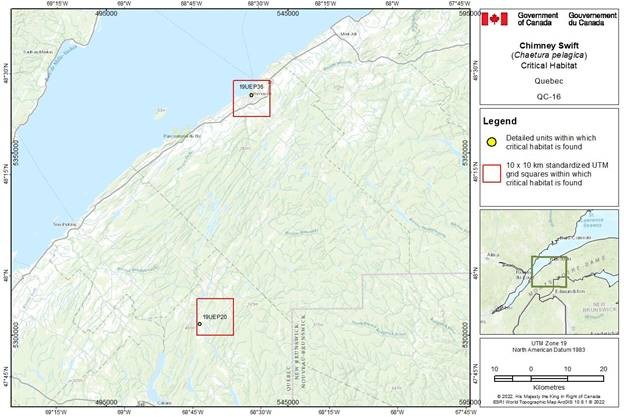
Figure D-3.16. Critical habitat for the Chimney Swift in Quebec. The critical habitat units are indicated by a yellow dot within the red 10 × 10 km squares. where the criteria and method for identifying critical habitat set out in section 7.1 are applied. The 10 × 10 km squares in the standardized UTM grid system of Canada indicate the general geographic location of the critical habitat.
There are two polygons of critical habitat located within two 10 x 10 km UTM grid squares. One polygon is located in Rimouski. The other polygon is located south of the previous polygon, west of the Quebec-New Brunswick Border and north of Cabano.
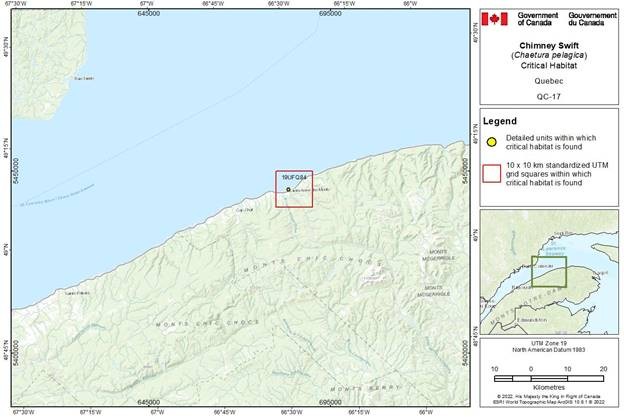
Figure D-3.17. Critical habitat for the Chimney Swift in Quebec. The critical habitat units are indicated by a yellow dot within the red 10 × 10 km squares. where the criteria and method for identifying critical habitat set out in section 7.1 are applied. The 10 × 10 km squares in the standardized UTM grid system of Canada indicate the general geographic location of the critical habitat.
There is one polygon of critical habitat located within one 10 x 10 km UTM grid square. The polygon is located in Sainte-Anne-des-Monts near St. Lawrence River.
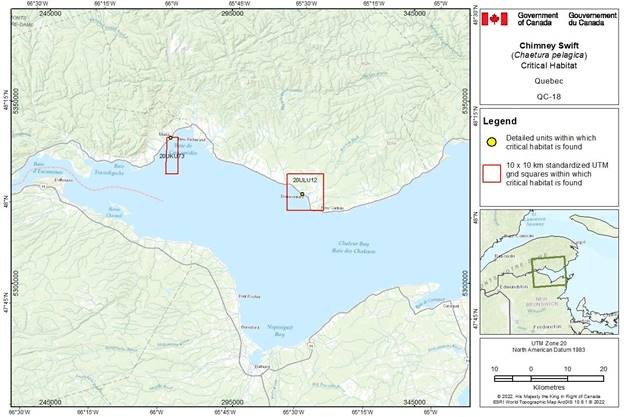
Figure D-3.18. Critical habitat for the Chimney Swift in Quebec. The critical habitat units are indicated by a yellow dot within the red 10 × 10 km squares. where the criteria and method for identifying critical habitat set out in section 7.1 are applied. The 10 × 10 km squares in the standardized UTM grid system of Canada indicate the general geographic location of the critical habitat.
There are two polygons of critical habitat located within two 10 x 10 km UTM grid squares. One polygon is located in Maria, along Baie de Cascapédia. Southeast of the previous polygon is the other polygon, located in Bonaventure.
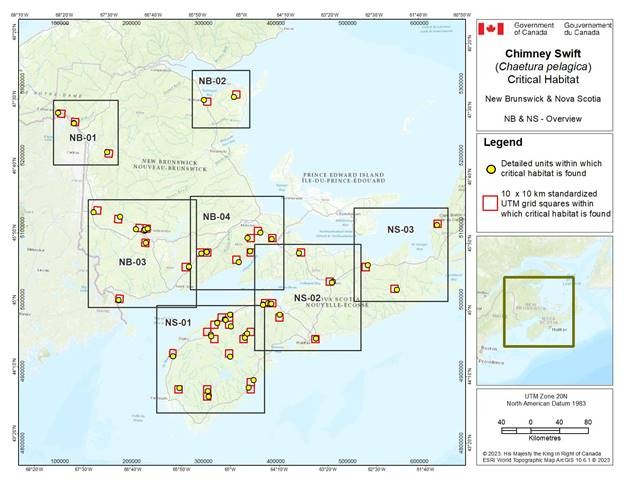
Figure D-4. Overview of Figures D-4.1 to D-4.7 (maps NB-01 to NB-04 and NS-01 to NS-03) representing the critical habitat for the Chimney Swift in New Brunswick and Nova Scotia. The critical habitat units are indicated by a yellow dot within the red 10 × 10 km squares. where the criteria and method for identifying critical habitat set out in section 7.1 are applied. The 10 × 10 km squares in the standardized UTM grid system of Canada indicate the general geographic location of the critical habitat.
The map shows an overview of critical habitat for the Chimney Swift in New Brunswick and Nova Scotia. Numerous 10 x 10 UTM grid squares cover critical habitat across both provinces, subdivided into 7 maps that are more detailed.
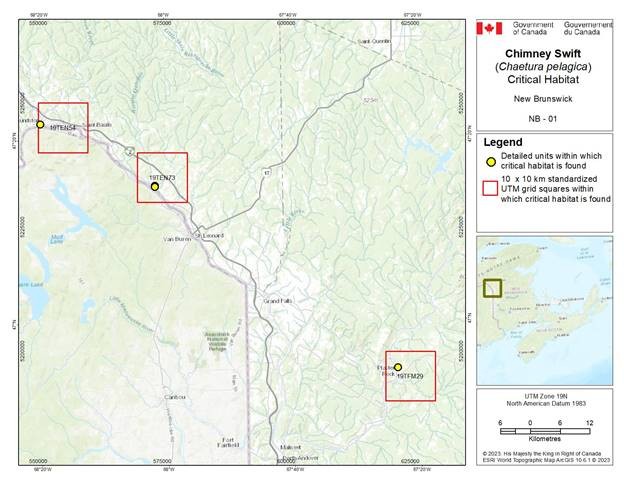
Figure D-4.1. Critical habitat for the Chimney Swift in New Brunswick. The critical habitat units are indicated by a yellow dot within the red 10 × 10 km squares. where the criteria and method for identifying critical habitat set out in section 7.1 are applied. The 10 × 10 km squares in the standardized UTM grid system of Canada indicate the general geographic location of the critical habitat.
The map contains three polygons within three 10 x 10 km standardized UTM grid squares. The first polygon is found within a grid square, located between Edmunston and Saint – Basile, New Brunswick. The second polygon and grid square are located along the United States border between Saint – Basile and St Leonard, New Brunswick. The last polygon and grid square are found at Plaster Rock, New Brunswick.
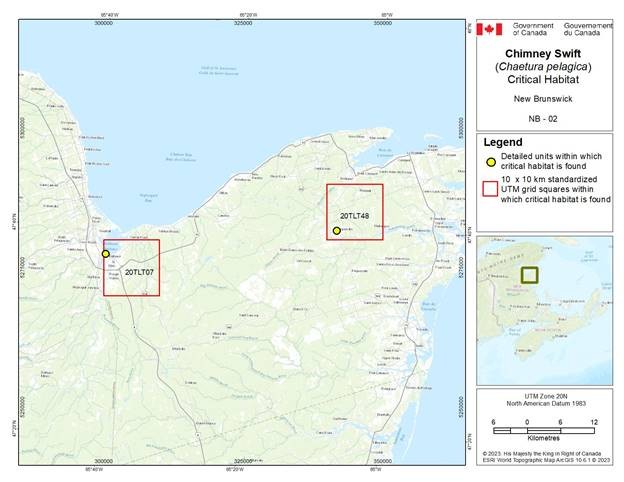
Figure D-4.2. Critical habitat for the Chimney Swift in New Brunswick. The critical habitat units are indicated by a yellow dot within the red 10 × 10 km squares. where the criteria and method for identifying critical habitat set out in section 7.1 are applied. The 10 × 10 km squares in the standardized UTM grid system of Canada indicate the general geographic location of the critical habitat.
The map contains two polygons within two 10 x 10 km standardized UTM grid squares. The first polygon is found within a grid square, located near Bathurst, New Brunswick. The second polygon and grid square are located in Paquetville, New Brunswick.
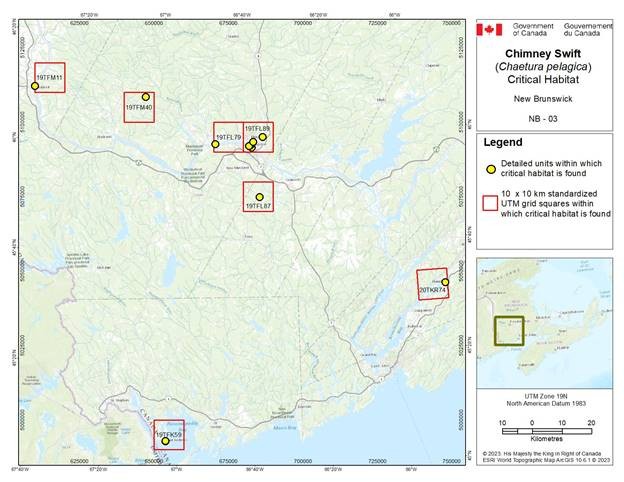
Figure D-4.3. Critical habitat for the Chimney Swift in New Brunswick. The critical habitat units are indicated by a yellow dot within the red 10 × 10 km squares. where the criteria and method for identifying critical habitat set out in section 7.1 are applied. The 10 × 10 km squares in the standardized UTM grid system of Canada indicate the general geographic location of the critical habitat.
The map contains multiple polygons within seven 10 x 10 km standardized UTM grid squares. The first polygon is found within a grid square, located northeast of Nackawic, New Brunswick. Another polygon and grid square can be found northwest of Nackawic, New Brunswick. The next few polygons are clustered within two adjacent grid squares that are located east of Mactaquac Provincial Park. The next lone polygon and grid square is located in St. Andrews, New Brunswick. Another lone polygon and grid square can be found between Tracy, Oromocto and New Maryland, New Brunswick. The last polygon and grid square are found at Hampton, New Brunswick.
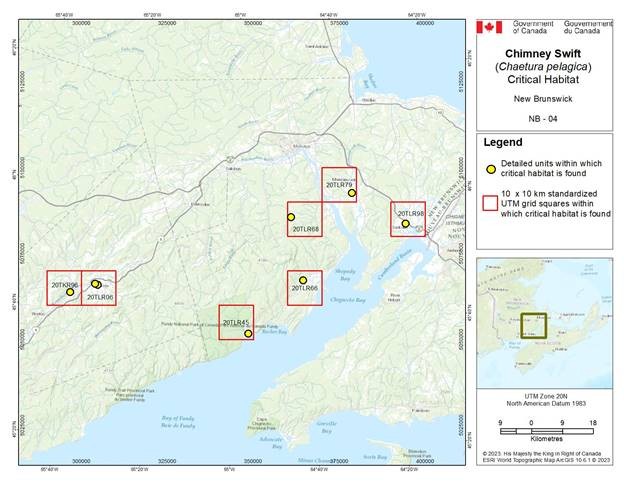
Figure D-4.4. Critical habitat for the Chimney Swift in New Brunswick. The critical habitat units are indicated by a yellow dot within the red 10 × 10 km squares. where the criteria and method for identifying critical habitat set out in section 7.1 are applied. The 10 × 10 km squares in the standardized UTM grid system of Canada indicate the general geographic location of the critical habitat.
The map contains eight polygons within seven 10 x 10 km standardized UTM grid squares. The first polygon is found within a grid square, located northeast of Sackville, New Brunswick. The next lone polygon and grid square are located west of Shepody Bay. The next lone polygon and grid square can be found at the bottom right of Fundy National Park. The next two polygons each have their own grid square located diagonally of each other, with the first one located just south of Memramcook, New Brunswick, while the other polygon located west of Shepody Bay and south of Moncton, New Brunswick. The remaining polygons are found clustered in two grid squares in Sussex, New Brunswick and northeast of Norton, New Brunswick.
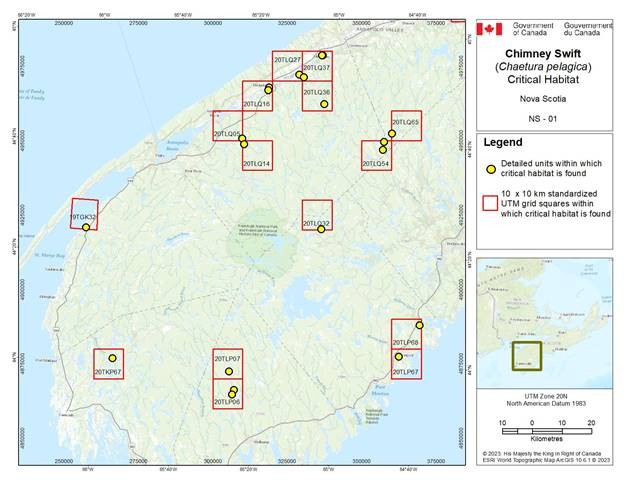
Figure D-4.5. Critical habitat for the Chimney Swift in Nova Scotia. The critical habitat units are indicated by a yellow dot within the red 10 × 10 km squares. where the criteria and method for identifying critical habitat set out in section 7.1 are applied. The 10 × 10 km squares in the standardized UTM grid system of Canada indicate the general geographic location of the critical habitat.
The map contains multiple polygons within 15 10 x 10 km standardized UTM grid squares. The first lone polygon is found within a grid square, bordering St. Mary’s Bay and northeast of Saulnierville, Nova Scotia. The next lone polygon and grid square can be found just east of Port Maitland, Nova Scotia. The last lone polygon and grid can be found northeast of Kejimkujik National Park And Natural Historic Site of Canada. The next three polygons are found in two diagonally connected grid squares found northeast of the last lone polygon and grid. The next three polygons are found clustered in two grid squares to the south of Kejimkujik National Park And Natural Historic Site of Canada. The next two polygons and their grid squares can be found in and north of Liverpool, Nova Scotia. The remaining polygons are found across six clustered grid squares running from Bear River, New Brunswick to Greenwood, Nova Scotia.
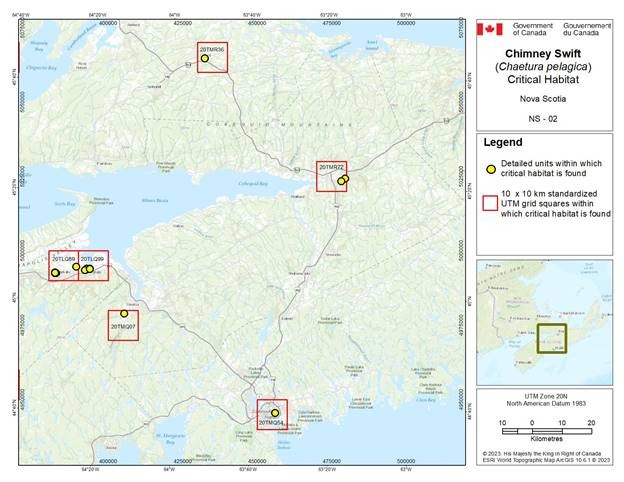
Figure D-4.6. Critical habitat for the Chimney Swift in Nova Scotia. The critical habitat units are indicated by a yellow dot within the red 10 × 10 km squares. where the criteria and method for identifying critical habitat set out in section 7.1 are applied. The 10 × 10 km squares in the standardized UTM grid system of Canada indicate the general geographic location of the critical habitat.
The map contains multiple polygons within six 10 x 10 km standardized UTM grid squares. The first lone polygon is found within a grid square, along Highway 104 between Chignecto Bay and Tatamagouche Bay. The next lone polygon and grid square are found just south of Windsor, Nova Scotia. Two polygons are found within one grid square where Highway 104 and Highway 102 meet. Another grid square containing one polygon can be found in Dartmouth and Halifax, Nova Scotia. The remaining polygons are clustered across two grid squares spanning Kentville, Nova Scotia and Wolfville, Nova Scotia.
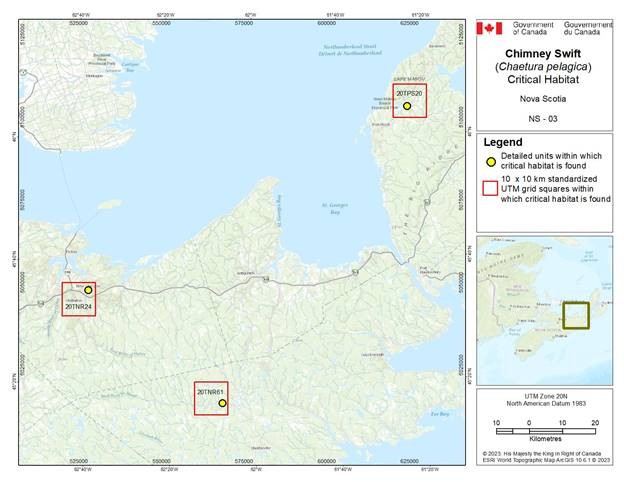
Figure D-4.7. Critical habitat for the Chimney Swift in Nova Scotia. The critical habitat units are indicated by a yellow dot within the red 10 × 10 km squares. where the criteria and method for identifying critical habitat set out in section 7.1 are applied. The 10 × 10 km squares in the standardized UTM grid system of Canada indicate the general geographic location of the critical habitat.
The map contains three polygons, each within their own 10 x 10 km standardized UTM grid square. The first polygon and grid square can be found northeast of the place where Highway 106 and Highway 104 meet. The second polygon and grid square can be found right of West Mabou Beach Provincial Park, Nova Scotia. The remaining polygon can be found south of Highway 104 at the bottom of the map, northwest of Sherbrooke.
Appendix E: Description of building types
Below are descriptions of the building (or structure) types identified as being associated with critical habitat for the Chimney Swift (see Tables D-1 to D-5). In the case of an abandoned building, the most recent known use of the building was used to identify the building type.
- Residential building
- a single-family or multi-family building used primarily for dwelling purposes. Examples: detached house, apartment building, condominium, duplex, triplex, fourplex, townhouse.
- Commercial building
- a building used for the sale of retail goods or the supply of services to the public. Examples: car dealership, automobile repair shop, gas station, bank, bookstore, movie theatre, pharmacy, bakery, bar, restaurant, supermarket, shopping mall, department store, convention centre, hotel.
- Residential and/or commercial building
- a building that is used for both residential and commercial purposes. For example, a building comprising condominiums or apartments as well as retail stores. This category was also applied when there was uncertainty about a specific building type based on the available information.
- Office building – Public building
- a large building containing offices OR a government building OR a building used to provide public services, activities or transportation to citizens. Examples: city hall, embassy, courthouse, prison, fire station, police station, post office, hospital, rehabilitation centre, medical clinic, nursing home, public swimming pool, public sports hall, public arena, public library, museum, community centre, airport terminal, railway station, bus station, military building (e.g. barracks, citadel, fortification).
- Educational building
- a building in which education or training are provided to children or adults. Examples: nursery school, elementary and secondary schools, college, university, vocational school.
- Religious building
- a building used for religious purposes. Examples: church, temple, mosque, synagogue, shrine, presbytery, convent.
- Industrial building
- a building or structure designed to house industrial operations. Examples: factory, brewery, mill, hydroelectric power station, warehouse.
- Agricultural building
- a building or a structure designed for agricultural and farming practices. Examples: barn, silo, stable.
- Water well:
- a hole or shaft sunk into the earth for the purpose of withdrawing water.
- Chimney Swift tower
- hollow structure (e.g. artificial chimney) specially constructed for Chimney Swifts, either freestanding or attached to a building.
Footnotes
- footnote[1] Back to paragraph Species at risk public registry
- footnote[2] Back to paragraph The Government of Quebec is not a signatory to this Agreement. However, it works with the Government of Canada on the conservation of species at risk of common interest.
- footnote[3] Back to paragraph Species at risk: the act, the accord and the funding programs
- footnote[4] Back to paragraph These federally protected areas are as follows: a national park of Canada named and described in Schedule 1 to the Canada National Parks Act, Rouge National Urban Park established by the Rouge National Urban Park Act, a marine protected area under the Oceans Act, a migratory bird sanctuary under the Migratory Birds Convention Act, 1994, and a national wildlife area under the Canada Wildlife Act. See subsection 58(2) of SARA.
- footnote[5] Back to paragraph This organization was formerly known as “Bird Studies Canada”.
- footnote[6] Back to paragraph Chimney Swift tower: A hollow structure specifically designed and constructed for the Chimney Swift to provide alternative sites to building chimneys (or other human-made structures not designed for the species’ use) and that replicates the features sought by Chimney Swifts for nesting or roosting. Stakeholders occasionally use the term “artificial chimney”.
- footnote[7] Back to paragraph Aerial insectivores: birds that feed on insects captured in flight.
- footnote[8] Back to paragraph Extent of occurrence: The extent of occurrence is the area contained within the shortest continuous boundary drawn to encompass all the known, inferred or projected sites of present occurrence of the wildlife species, excluding cases of vagrancy (COSEWIC 2015).
- footnote[9] Back to paragraph Area of occupancy: The area within the extent of occurrence that is occupied by the wildlife species, excluding cases of vagrancy. This measure reflects the fact that the extent of occurrence may contain unsuitable or unoccupied habitat. The index of area of occupancy (IAO) is a measure that aims to provide an estimate of area of occupancy that is not dependent on scale (COSEWIC 2015).
- footnote[10] Back to paragraph An overview of this bird population monitoring program is available at Breeding Bird Survey overview
- footnote[11] Back to paragraph Cumulative scope of threats 1.1 and 1.2.
- footnote[12] Back to paragraph 2,4-Dichlorophenoxyacetic acid
- footnote[13] Back to paragraph Phenology is the study of periodic events in biological life cycles and how these are influenced by seasonal and interannual variations in climate, as well as habitat factors (such as elevation).
- footnote[14] Back to paragraph A trend is considered stable when the 95% confidence or credibility interval surrounding the estimates includes a value of zero.
- footnote[15] Back to paragraph The cumulative rate of decline of the population in Canada must not exceed 10% during this period.
- footnote[16] Back to paragraph The term “priority” reflects the degree to which the approach contributes directly to the recovery of the species or is an essential precursor to an approach that contributes to the recovery of the species.
- footnote[17] Back to paragraph No elements of Indigenous traditional knowledge on this subject were reported in the last status report (COSEWIC 2018).
- footnote[18] Back to paragraph The Cabinet Directive on the Environmental Assessment of Policy, Plan and Program Proposals.
- footnote[19] Back to paragraph The Federal Sustainable Development Strategy
- footnote[20] Back to paragraph Based on the standard UTM Grid - Military Grid Reference System, where the first 2 digits represent the UTM zone, the following letter represents the UTM row, the next 2 letters indicate the 100 km x 100 km standardized UTM grid, followed by 2 digits to represent the 10 x 10 km standardized UTM grid comprising one or several critical habitat units. This unique alphanumeric code is based on the methodology used for the Breeding Bird Atlases of Canada (see Birds Canada for more information on breeding bird atlases).
- footnote[21] Back to paragraph See Appendix E for a description of building types.
- footnote[22] Back to paragraph When there is more than one chimney on the building or property. N = north; S = south; E = east; W = west.